
- Get access now

30+ tips and tricks to make Google Slides presentation look good
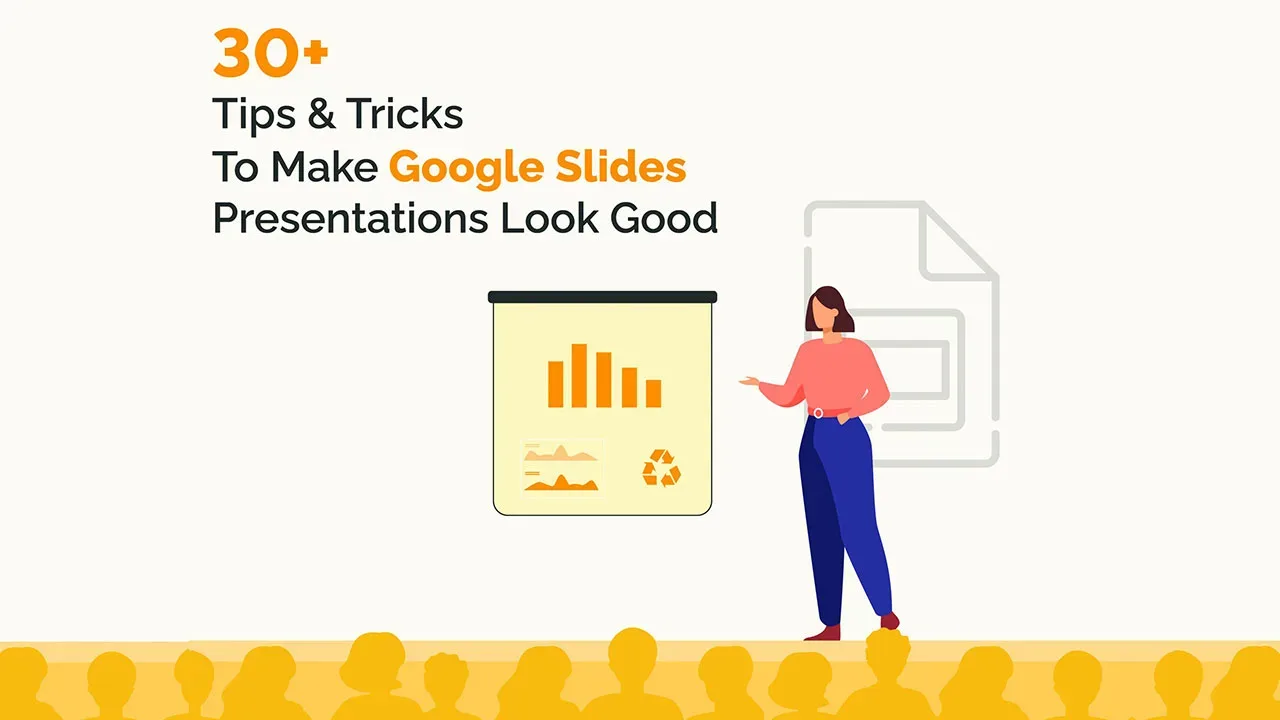
Let’s face it, it’s no fun to look at a slide with heavy texts and overcrowded images. It leaves the audience bored and disinterested. It’s very important for your Google Slides presentation to look good in order to have your audience on board. You don’t need to be a designer to learn how to make aesthetic google slides. You can make some basic editing and formatting easily in Google Slides presentation to take it to the next level. In this article, we present some amazing hacks to have a killer presentation that leaves the audience in awe.
Be prepared for a bonus at the end!
Use Google Slides layouts wisely
1. customize slide layouts.
Every presentation needs to follow a basic layout which is regular throughout. Google Slides have a set of layout and theme options to choose from. But in case you wish to edit certain elements, you are free to do it. This will make the presentation truly yours. Click here for a complete guide on using layouts any fresher can use.
2. Use pretty backgrounds for Google Slides
Most of the professional presentations contain a lot of jargon-heavy information written in plain texts on plain backgrounds. Instead, include a transparent or mild background to support your text. The background can either be related to the story or just a plain color wall that goes with the text font and the context.
3. Draw attention with dark background
Audience gets tired of looking at bright colors all day. So, using a dark background not only catches their attention, but is also pleasant for the eyes. But remember to use the matte finish or mild colors for text with the dark background.
4. Try black and white theme to look professional
Often, a black and white theme stands out both because of the professionalism it conveys. This keeps your presentation minimal in appearance and adds to the authenticity of your delivery. But you should be careful not to make it look boring.
5. Use the Master Slides tool
Any change you make in the master slide will automatically reflect on all other slides. Customize the master slide first so that you can save time. You can modify backgrounds, rearrange placeholders, or change theme for the whole presentation with Master slides tool.
6. Keep it minimal
Don’t go fancy with the designs and fonts, keep it minimal. Overcrowding the slides with bulky texts and images or vibrant colors is not a good idea. It will distract the audience and make the presentation look unprofessional.
How to make Google Slides look good with Images
1. use shape masks to make creative images.
Using regular shapes like square and rectangle for images can get boring. To make it interesting, give different shapes to the images.
How to use shape masks in Google Slides:
Select the image you want to apply a shape mask on. Crop the image to the size you want. In crop tool, go to Shapes and choose a shape from the drop-down menu.
2. How to import images from the web
Adding relevant and catchy images make your google slides aesthetic. But you may not have the perfect image to go with the slide. In that case, you can directly download the picture from Google without leaving the tab.
How to import Google images into Google Slides:
Go to Insert >> Image >> Search the web >> Type in the name of the image you want. Or, go to Explore section and Google directly from the Slides tab.
3. Reflect your images if it suits the context
This will be a really cool effect, especially for slides with a single important image. Reflecting your images is a creative way to grab the attention with a single slide. But, this is a bit outdated feature, so it’s better to avoid for professional presentations.
How to reflect an image in Google Slides:
Select an image. Go to Format options and tick the box next to Reflection. Use the slider to adjust the size and transparency.
4. Make the image transparent
Another tip is to adjust the transparency of your image rather than adding a plain image. Plus, you can write relevant text on top of a transparent image.
How to make an image transparent in Google Slides:
Right-click on the picture and go to Formats option. Go to Adjustments >> Transparency. Adjust the transparency as per your requirements.
5. Resize and rotate shapes and images
When you import an image from the web, it might not be the right size for your slides. Google Slides allows you to resize and rotate the images and shapes.
To resize a picture, simply select the picture and move the cursor to bring to the desired size. To rotate an image, click the picture and choose Arrange. Then, click Rotate and select the preferred orientation. Avoid these while using images in Google Slides presentation: Though there are a hundred things you can do to your image, overdoing it will beat the point of making your Google Slides presentation look good. Following are some of the things you should avoid so that the slides look professional.
Using blurry or irrelevant pictures. Stretching or cropping the image more than necessary Low resolution images Watermarked images Not adding citations while using a picture you don’t own Crowding the slides with pictures Using reflection or transparency settings in all the images
Make your Google Slides presentation interactive
1. use the interactive q&a tool.
Having a Q&A section at the end helps you clear any doubts your audience might have. You can make it more interesting by using the Q&A tool. The audience don’t have to wait till the end of the presentation, they can type in the question whenever they want.
How to use the Q&A tool:
During your presentation, activate the Q&A feature by clicking on the Q&A tool. Audience sees a weblink where they can submit their questions. You can answer them at the end of the presentation. You can check the past questions by going to Tools >> Q&A history
2. Create a timeline
In many business presentations, you might need to present the progress of a project and timeline is an important part of it. It is easy to understand and remember. This can be used for interactions and discussions with the audience.
How to create timeline in Google Slides:
Go to Insert >> Diagram This shows a list of different types of timeline templates in built with Google Slides. Choose the one you like and edit it for your data.
Color schemes for your Google Slides presentation
1. edit theme colors.
Every Google Slide theme you choose comes with a pre-set color scheme. However, you can customize the theme according to the color you prefer.
Go to Slide >> Edit Theme Choose a color from the drop-down menu. Here’s a guide on choosing the right color for your Google Slides presentation.
2. Use color split
Using two different colors on the same slide is visually appealing. Make sure you use complementary colors like yellow and blue. For example, if you are using a blue background, use orange color for the texts.
3. Create a color overlay
Color overlay is a technique to make transparent shapes appear on your images or text. You can either apply it to the whole slide or a part of it.
Go to Insert >> Shape Choose a shape if you want to overlay only a part of your slide. Place the selected shape on the slide. Click on the shape and go to Fill colors and choose the color you want. Avoid these while choosing colors for your Google Slides presentation: While adding colors in a smart way can grab the audience’s attention, there are certain rules you should stick to while using them. Here is a small list of things to avoid in order to make your Google Slides look good.
Using multiple bold colors in a single slide Using same color for theme and texts Not sticking to your brand colors Using bright colors for reflection of images or texts. Overusing color gradient
Tips for text in Google Slides presentation
1. try different font attributes.
No one is going to read all the text in your presentation. So, you can highlight the parts which you want to stress on. You can make the text bold, italics, or underlined.
2. Research the top text fonts to use in Google Slides
There are a number of text fonts available in Google Slides, but not all of them make it to a professional presentation deck. So, it’s very important to know the most preferred text fonts to use in Google Slides.
Here are the 5 top text fonts:
Open sans Montserrat Cabin Ubuntu Lato
3. Use text box to have neat texts
Texts randomly strewn across the slides can be distracting for your audience. So, use a text box to have the texts placed in a neat way. You can also align your texts to left, right or centered to make it look professional.
4. Add a drop shadow to the text
Another way to make your texts look interesting is to use a drop shadow effect for Google Slides. However, if you lack experience in designing, we suggest you not to use this effect.
How to add drop shadow:
Select the text you want to use drop shadow on. Go to Format and check the box near Drop Shadow. Use the slider to adjust blur, transparency, and angle.
5. Add the technical terms to your personal dictionary
There might be terminologies or names that are specific to your topic, which may come off as spelling errors. In slides, they may appear in red and you may lose your credibility. To remove this, you can add those terms to the personal dictionary.
Go to Tools >> Personal dictionary Add the technical terms. They will no longer be shown as spelling errors. Common mistakes people make in Google Slides text: While the above features can make your text professional and easy to read, most people miss out on the basics.
Omitting indentation Wrong alignment of text on the slide Using very large or very small texts Not proofreading for typos Inadequate spacing between texts or lines.
Include infographics in Google Slides presentation
1. experiment with different types of diagrams.
If you have a lot of data to present, it’s better to present as graphs or charts instead of pulling off large sheets of data. There are different types of graphs you can use like line graph, bar graph, histogram, pie chart, etc. So, use them in your presentation. This adds credibility to your work and presentation.
2. Let your graph speak for itself
This means you must label, highlight or add everything in the graph such that anyone can analyze it. A single graph with right labels and arrows to show the trend can convey the meaning much better than large amount of texts or spreadsheets.
Add animation to make Google Slides presentation attractive
1. add subtle animation effects on texts.
If you have a lot of information to share on a single slide, use animations to delay some texts instead of displaying everything at a time. This works well for bullet points where you can display one point after another.
2. Add a GIF or a meme
One of the main reasons why presentations are boring is the lack of fun element. Adding a GIF or a relatable meme is not only funny, but helps you put the message across easily. It is an effortless attention grabber.
But you have to make sure it gets added as an animated GIF rather than a still image. For this, the following steps will help:
Find the GIF in Google and copy the image address. Go to Google Slides >> Image >> by URL Paste the URL and click Insert. Remember you have to insert the image by URL for it to play.
3. Add trimmed videos in Google Slides
People recollect visuals better than written text. So, if there is a video on YouTube which can explain what you want to convey, use it. But instead of including the full video, you can add only the relevant part by using the embed option.
4. Use transitions for slides
Adding smooth transition effects for individual slides helps in keeping the flow. The most recommended transition effects to use in a professional presentation are dissolve, fade in, slide from the left, fly in from bottom and fly in from left to right.
Go to Insert >> Animation Select a transition from the available options. Apply to a single slide or all slides, as you wish.
Are you terrified by the amount of effort you have to put in researching about fonts, choosing best colors and get the formatting perfect? This can be time-consuming if you designing is not your biggest flex.
Don’t worry! Here’s the good news!!
You can skip all these steps and still have an amazing presentation deck if you use professional templates!
Use Google Slides presentation templates
Making a presentation from the scratch is wasted time and energy which could be spent on crafting the story you want to convey. That’s why we bring to you the best presentation templates to help you tell your story in your unique way. SlideKit has professional templates designed by experts and you can customize it according to your needs. This can be installed as an add-on in Google Slides for free. It ensures consistency of aspects like font, theme, color scheme and layout used throughout the deck.
SlideKit has slides in the business and other professional domains which you can download, edit and use for free. Premium membership gives you access to 3500+ templates over 35+ niches. Using these templates will make your Google Slides presentation stand out. Here are a few tips to make the most out of SlideKit’s professional google slides templates .
1. Customize the templates
The presentation deck you choose will have all the design and infographic elements you need; but you need to customize them according to your data and your preferred color and font. In SlideKit, you can add images, videos, or hyperlinks, and place them wherever you want on the slide. Additionally, you can acquire hyperlinks from other websites to your own which is referred as niche edits .
2. Use niche-specific templates
There are templates available for different domains, so choose the one that fits your industry. Templates are perfect for branding since they come with placeholders for logo, letterhead, contact details and website address. But it’s important to choose the one that is aligned with the industry. SlideKit makes it easier for you by giving you a variety of industry-specific options to choose from. Moreover, incorporating effective SEO strategies , such as optimizing presentation titles, using relevant keywords, and providing quality content, can significantly enhance the online visibility of your Google Slides presentations, making them more accessible to your target audience and boosting overall engagement.
3. Plug in your data to relevant infographics
As mentioned before, including graphs and charts is beneficial for both you and your audience. Depending on the domain, SlideKit offers relevant infographics which can be customized according to your data. You can change the labels, legends, scale and figures, among many other features.
Now you have the best resources and tools to make your Google Slides presentation look compelling.
Happy presenting!
Welcome back, please sign in to continue..

Please sign up to continue.
How To Make Google Slides Look Good [Complete 2024 Guide]
- Last updated January 2, 2024
Making a standard presentation is easy, but knowing how to make Google Slides look good is an entirely different challenge. In my guide, I will show you how to make your Google Slides better , both functionally and aesthetically.
Keep reading to learn how to take your Google Slides presentation from good to great !
Table of Contents
1. Choose a Google Slides Theme

Themes ensure your presentation has visually consistent colors, fonts, sizes, and layouts. This goes a long way toward providing a professional and polished appearance, and it’s much easier for the audience to follow along.
- Choose a theme that aligns with the tone and purpose of your presentation.
- Ensure slides have a consistent set of colors, fonts, and layouts.
- Select a visually appealing color scheme and legible font combination.
While you can handpick background color palettes, typefaces, and slide layouts, many of the best Google Slides templates are built into the program! In a blank presentation, you’ll find them on the right-hand side.

Creating Your Own Google Slides Theme
It’s fairly straightforward to create your theme in Slides. Add whatever background color, images, shapes, and page formatting you prefer. Right-click your chosen slide and select “ Add to theme .”

Related : Don’t want to make one from scratch? I’ve got you covered with some of my favorite Google Slides templates at the bottom of this article.
How To Import a Theme to Google Slides
- Create a new presentation or open an existing one.

Note : Importing a theme into your presentation will impact all of your slides. To revert to the previous version, use the “ Undo ” button by pressing the keyboard shortcut Ctrl + Z (on Windows) or use Command + Z (on Mac).
2. Choosing Color Schemes in Slides
A color scheme is one of the first things your audience will see, so it’s one of the most critical elements. Google Slides offers plenty of color options, including gradients (which can be used for almost all the elements, including background, font, and shapes).
Use color theory principles (like complementary colors) to create combinations that stand out for the right reason. Color psychology is also a great way to express emotions or convey messages purposefully:
- Warm colors (e.g., red, orange, yellow) can express warmth, energy, or even a warning.
- Cool colors (e.g., blue, green, purple) can represent relaxation, sophistication, or security.
Use Color to Make Sections Stand Out
Strategically use color to highlight essential elements (e.g., headings, critical data). To guide the audience’s attention:
- Use vibrant shades that contrast the color scheme.
- Assign specific colors to categories, sections, and team members.
Be Mindful of Contrast
Check that the text and background colors have enough contrast for better reading. The most readable combination is dark text on a light backdrop (or vice versa). In charts and graphs, use color to improve focus and understanding.
Note : Avoid colors that can blend together or present difficulties for people with color blindness .
3. Choosing Text and Fonts
Your chosen font portrays information and dramatically improves your presentation’s overall aesthetic. If you’re trying to make a cool presentation on Google Slides, you’ve got a lot to consider!
Use Clear, Legible, and Easy-to-Read Fonts
Avoid overly decorative or ornate fonts because they can hinder readability (especially when projected on a larger screen). Stick to widely available and compatible fonts across devices like Arial, Georgia, or Open Sans.
Ensure Font Sizes, Weights, and Styles Stand out
Headings should stand out; supporting text should be smaller (or less emphasized). This is done to guide the audience’s attention and improve readability.
Note : While they can add visual interest, excessive use of font styles can be distracting and more challenging to read.
Complement Font Pairings
Select a combination of fonts that contrast each other and create visual interest. Consider using online resources or font pairing tools for inspiration. We recommend sticking to a maximum of two to three fonts to prevent visual chaos.
Use Fonts That Align with Branding Guidelines
If your website uses a specific font and color scheme, incorporate them into your presentations to support the organization’s visual identity.
Align Text and Spacing
Align text and leave enough white space for a clean, organized look.
4. How to Add Word Art to Google Slides:
- Select “ Insert ” > “ Word Art ” from the drop-down menu.

- Type your text, then press the “ Enter ” key on your keyboard.

There you have it! Your Word Art will now appear on your selected slide.

Note: If you want to edit the font or color, click the Word Art, and a formatting box will pop up.

5. How To Add Google Slides Transitions
You can ensure seamless transitions from slide to slide with a couple of clicks:

- If you want to apply the selected transition to all slides in your presentation, click “ Apply to All Slides .”
- Any transitions applied to skipped slides won’t play during the preview.
- Click the “ Stop ” button when you’re finished.

Tip : You can configure your presentation to play automatically using Google Slides’ automatic transitions. This removes the need to press the spacebar or click on the screen to trigger the next slide.
How Many Transitions Are Available in Google Slides?
At the time of writing, Google Slides offers seven built-in transitions . There is currently no option to add or download additional transitions.
6. How To Add Animations on Google Slides
Enhance the visual appeal of your slideshow by incorporating animations (i.e., effects that make elements move). They can be applied to almost every object, from images to tables to bullet points. Follow the steps below to add animations to your slides:

- You’ll notice that your selected object’s “ Animation Type ” is set to “ Appear .”

- Fade in : This transition introduces the object by gradually fading it in.

- Fly in from left/right or top/bottom : The object flies into the slide from one side.

- Zoom in : The object starts small and slowly increases in size.
Under “ Animation Type ,” you’ll see the “ Start Condition ” drop-down. Open it to select whether the animation should play upon clicking a slide, with the previous animation, or after the previous animation.

Note: The start conditions “With Previous” and “After Previous” will only work if there is another animated object immediately before your selected object .

- Click on the “ Play ” button to preview your animation(s).
- Click the “ Stop ” button to end the preview and continue working on your slideshow.
Related : Google Slides vs. PowerPoint: Which Program Is Better?
Tips for Using Transitions & Animations
We recommend using these effects sparingly to emphasize essential elements or facilitate the flow of information. Avoid using them solely for decorative purposes.
Pick Subtle and Smooth Transitions
Flashy or distracting effects can overshadow your content. Your goal is to provide a seamless flow between slides. Try a simple fade or slide transition.
Adjust the Timing and Duration
Transitions shouldn’t be too fast or slow. Aim for a natural pace that allows the audience to follow along comfortably.
Highlight Specific Elements Within a Slide
Selectively animating text, images, or charts can emphasize critical points (or reveal information) in a controlled manner. Avoid excessive animation that appears gimmicky or distracting.
Be Consistent
Choose a specific transition style or animation effect — then stick to it. This will help you avoid distractions and inconsistencies.
7. Using Images and Videos

Adding images and videos to slides can greatly enhance visual appeal and engage your audience. Here are some points to consider when choosing an image:
- Choose images that are relevant to your content.
- Use high-quality images that are clear, crisp, and well-composed.
- Use images that evoke emotions or illustrate concepts.
- Strike a balance between text and images on your slides.
- Consider using images as slide backgrounds.
- Adjust transparency or apply overlays to maintain readability.
- Experiment with image formatting options (e.g., cropping, resizing, transparency, brightness).
8. How To Include Infographics in Google Slides

Infographics in a presentation can communicate complex information effectively. Use the drawing feature in Google Slides to make attractive and informative infographics. Keep these points in mind when using infographics:
- Keep your infographics clean and basic.
- Choose from bar charts, pie charts, line graphs, timelines, flowcharts, maps, and diagrams.
- Avoid overwhelming your audience: Use limited details, succinct labeling, and clear graphics.
- Use custom colors, typefaces, and visual styles to reflect your presentation or company identity.
- Highlight the most significant facts or data.
- Make sure infographic details are simple to read and understand.
How Can Poor Design Affect A Presentation?
Your presentation could be significantly impacted if you haven’t learned how to make Google Slides look professional. Here’s why:
Lack of Clarity
Poor aesthetics often make it more difficult for the audience to grasp — or focus on — details. Avoid cluttered or crowded presentations, imprecise typefaces, and insufficient color contrast. Key points might be missed, or the audience may get distracted.
Unprofessionalism
A disorganized presentation might give the appearance of being unprofessional, affecting the presenter’s credibility.
Poor Readability
Small fonts, poor contrast, and ornamental typefaces can strain the eyes and make it difficult to follow a presentation.
Lack of Visual Appeal
A presentation with a dull or unappealing design may fail to catch attention (and make the material less memorable).
9. A Few of My Favorite Google Slides Templates
If you’re not interested in using stock templates (let alone creating your own), I’ve got you covered with these slick presentations:
Ganymede Template

The Ganymede template offers a modern style with bold text for extra impact. Whether you aim to make a lasting impression with your pitch deck — or simply want to use colors that align with your brand — this template suits your needs.
Access Template
Dynamic Business Template

An effective project management report is characterized by clarity, and your color scheme plays a significant role. I love the streamlined theme of this Google Slides template and appreciate that a blank timeline chart, roadmap diagram, and funnel are included for incredible customization.
Frequently Asked Questions
Can you make google slides vertical.
You can make Google Slides vertical by following simple steps:
- Open a new or existing presentation.
- Click the “ File ” button to open a drop-down menu.
- Click the “ Page setup ” option.
- Select the “ Custom ” option and set your desired size (width and height)
- Hit “ Apply ” to save the changes.
Can You Do Hanging Indent in Google Slides?
Yes. There are three methods to do hanging indent in Google Slides:
- The ruler (blur triangle) along the top to position your hanging indent.
- The keyboard Tab key for quick indentation adjustments.
- Select “ Text Fitting ”> “ Indention ” > “ Hanging ” > “ First line indent ” > “ Hanging indent ” to the desired amount.
Are There More Google Slides Templates?
Yes. There are many free Google Slides templates out there. Here are ten additional templates for you to use.
Bottom Line
Any presentation’s goal is to keep the audience’s attention, and you can do that with a balance between aesthetics and practicality.
I hope I’ve helped you learn how to make your Google Slides look good, express your message, and captivate your audience. If you need more assistance, Spreadsheet Point’s premium Google Slides templates can take the pressure off you. When you use the code SSP, you’ll get 50% off !
Get Premium Templates
- How To Download Google Slides [Step-by-Step Guide]
- How To Add Bitmoji to Google Slides
- How To Make Google Slides Play Automatically
Most Popular Posts

How To Highlight Duplicates in Google Sheets

How to Make Multiple Selection in Drop-down Lists in Google Sheets

Google Sheets Currency Conversion: The Easy Method
A 2024 guide to google sheets date picker, related posts.
How to Import Stock Prices into Google Sheets
- April 2, 2024
How to Calculate Age in Google Sheets (2 Easy Methods)
- Sumit Bansal
- February 21, 2024
How to Hide Gridlines in Google Sheets
- February 14, 2024
Excel and Google Sheets Drop Down Lists: Complete Guide
Thanks for visiting! We’re happy to answer your spreadsheet questions. We specialize in formulas for Google Sheets, our own spreadsheet templates, and time-saving Excel tips.
Note that we’re supported by our audience. When you purchase through links on our site, we may earn commission at no extra cost to you.
Like what we do? Share this article!

15 Tips to Make an Amazing Google Slides Presentation Design!
By: Author Shrot Katewa
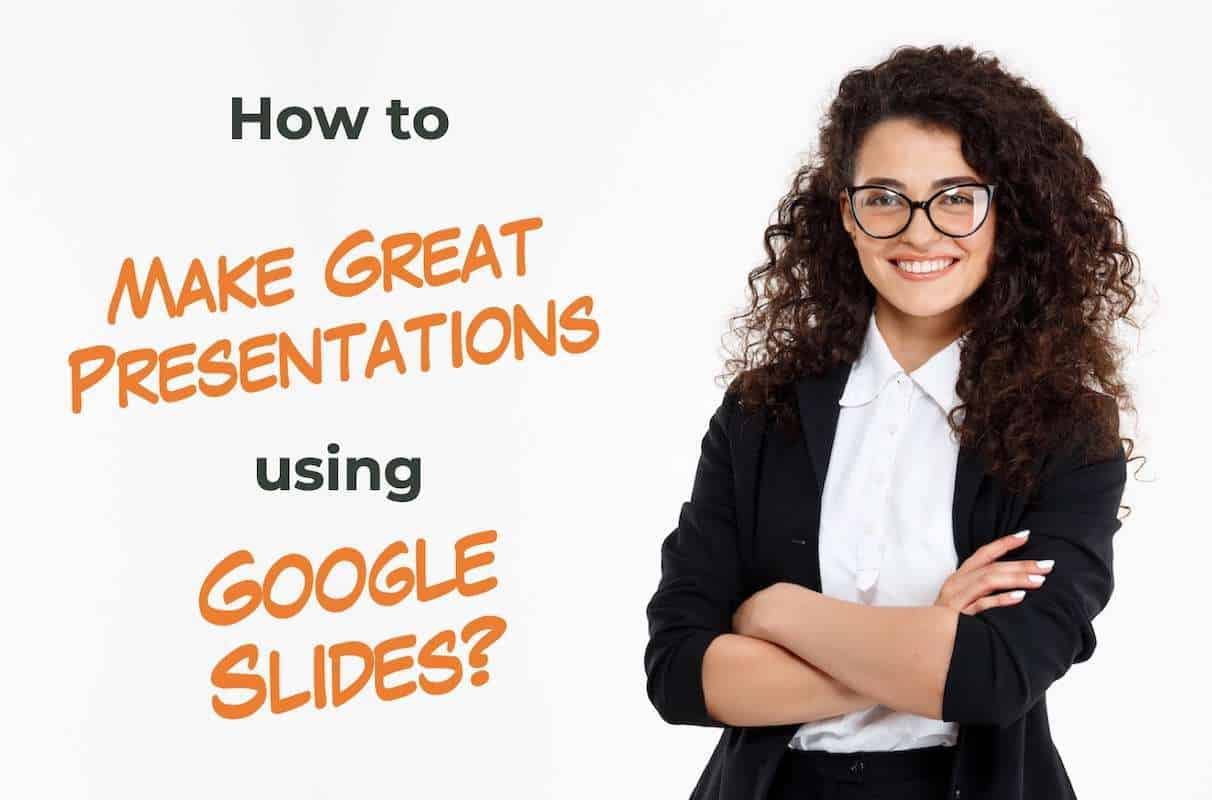
There are many reasons that people like to use Google Slides. It could be for a school project, work presentation or just to share information with friends and family.
Whatever the reason, one thing is certain: you want your design to look amazing! If you want an easy way to create a great-looking design for your next presentation then this blog post is for you.
In this article, we will go over 15 tips on how to make an amazing design using Google Slides. Whether it’s your first time creating a presentation on Google Slides or if you’re an experienced professional, these tips are sure to help guide you in the right direction!
So, let’s get started!
Note – if you are strapped for time , simply considering outsourcing the presentation design process to a professional! I’d recommend using Fiverr . It is completely hassle-free to set up and start using. Plus, you don’t need to pay anything to hire a professional. You only pay for the slide design! And, you can start with as little as $5 to $10 per slide!
Tips to Make an Amazing Google Slide Presentation Design!
Since this is going to be an action-packed article with a ton of suggestions, let’s just dive right in with the tips!
1. Create a Compeling Narrative Through a Story Arc
A presentation is only as good as the narrative it holds!
If your presentation doesn’t leave “ food for thought ” for your audience, they are less likely to remember your presentation, and even less likely to take any action afterward (which is mostly bad news especially if you are trying to convince your investors to give you more money!)
Presentation design goes hand-in-hand with the content that is going to be used for the presentation. Thus, start with a compelling story.
The best way to create a convincing story for your presentation is to use the “ Story Arc “.
A “ Story Arc ” or a “Narrative Arc” is something that has been successfully used by storytellers and writers for ages. The keyword here is “successfully”!
A powerful narrative can not only help your audience understand the intricacies of the subject of the presentation, but it also makes the presentation engaging and entertaining.
The best way to start working on a story arc is to either look at what is the most important aspect of your presentation and how can it be emphasized in a manner that takes the role of a protagonist?
Another way that I’ve used the story arc in my presentations successfully is to work backward. Think of what is the end outcome that you expect, and try to track things backward in order to achieve the end outcome.
No matter what approach you take, if you are able to fit a story arc in your presentation, you’d be golden!
Finally use stories from your life, or what you experienced while working on a project! I’ve seen this works really well and resonates with the audience. Here’s a quick video on tips for using storytelling in your presentation.
2. One Topic Per Slide
Now that you’ve identified the larger part of what you going to cover in your presentation – in other words, the content, you now need to lay it out on your presentation such that it can be consumed by your audience comfortably!
One of the simplest tips to design a better presentation is to make sure that you don’t cramp all the information in a single slide or 4-5 slides! Make sure that you spread out the presentation on multiple slides so that the audience can absorb all the information, but in short bursts, and then move on to the next topic!
A good rule of thumb for a good design is to try and cover just 1 topic on a slide.
I’ve seen this work plenty of times, and I personally also use this technique for my presentations. Simply divide the content of your presentations first into multiple key sections. Then, divide the sections further into key topics that should be covered within that section.
You can do this activity on a sheet of paper or just on the first slide of the presentation. Once you’re done with this activity, you’ll realize that the outline that you’ve just created also serves as the “Agenda” or the “Table of Contents” slide.
Now, all you’re left to do is fill in the information that needs to go under each topic.
You may be wondering how is this a design tip. Well, when you have just one concept present on a slide, it is not only easier for your audience to consume, but also easier to design. You’ll realize this when designing the presentation and thank me later!
Remember, there will be times when you will not have much to say about a particular topic, your slide will look empty, and you will be tempted to add another topic on the same slide. Don’t fall for that. Instead, use images that accentuate the text or the topic of the slide.
3. Start with a Template (Don’t Design from Scratch!)
This next tip might seem a bit obvious to some.
But, the reality is that quite a lot of people tend to miss out on the fact that you can use presentations that already look good, and just customize the slides for your content!
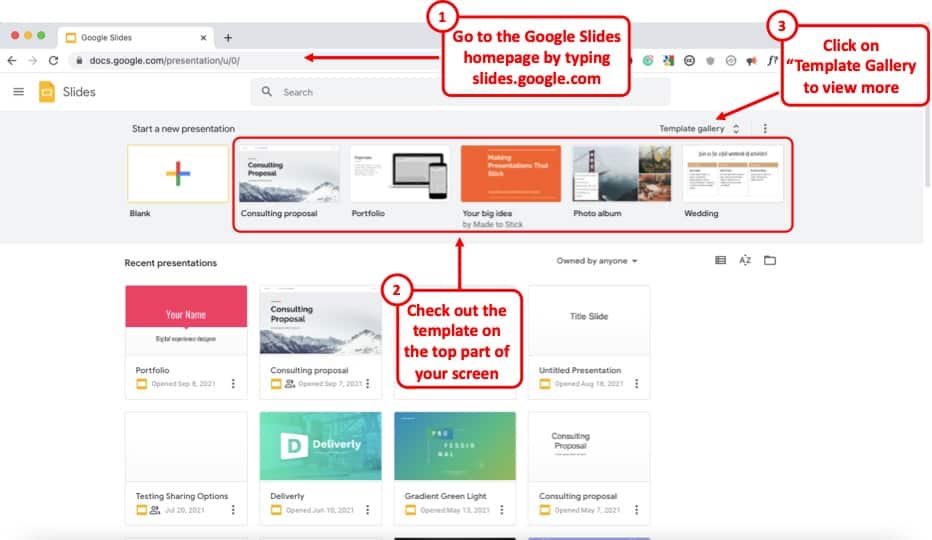
Google Slides already provides you with a number of free templates. Here’s how you can access them –
- First, visit your Google Slides dashboard page.
- Login to your Google Account (if prompted)
- Choose a template from “Start a new presentation” section
- You can also click on “Template Gallery” to view more templates.
The one template that I end up using over and over again is the file name “ Consulting Proposal “. It has got a sleek modern design, a good mix of image slides as well as different text placeholder slide layouts for you to easily edit your presentation.
But, feel free to check out other templates and see which one fits your need the best.
The point here is that if you are not great at designing a presentation, you’d perhaps be better off using a template rather than starting from scratch!
4. Use Fonts the Right Way
When it comes to designing a good presentation on Google Slides (or any application for that matter), fonts do play a key role in how your presentation looks!
Thus, it is important to make sure that you use the fonts correctly when creating your presentation.
Here’s what you need to remember when using fonts for your presentation –
- Use Just One or Two Fonts – Don’t use too many fonts in your presentation. Your presentation design will not look good. Plus, using too many fonts in a presentation shows lack of consistency and professionalism in design.
- Combine Fonts – Ideally, just use one font if you are unsure of which fonts work great together. But, you can also combine fonts to make the content of your presentation standout!
If you do want to go with a two-font option, use the Google Fonts tool to identify the font combination.
Here’s how you can find a good font combination for your presentation –
Step 1 – Visit Googe Fonts and Search for a Font
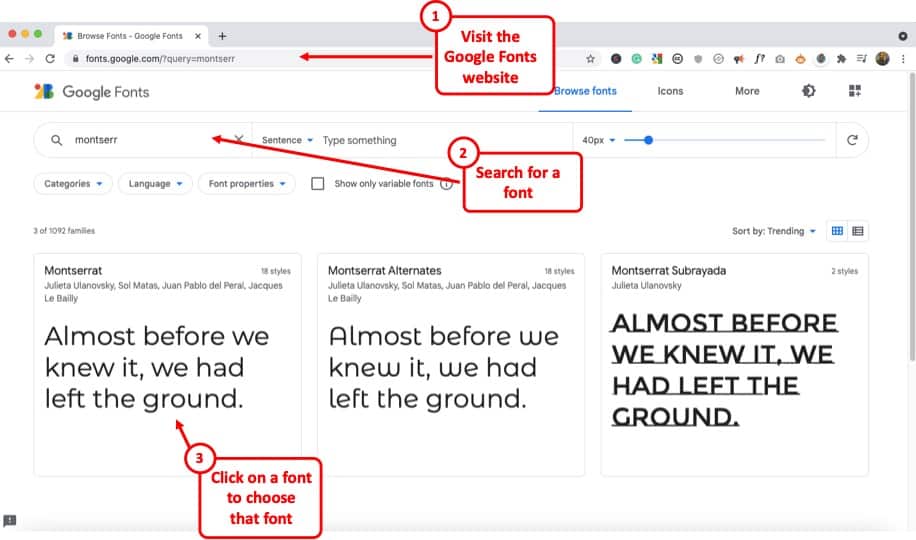
Google Fonts site provides free fonts that are compatible with most modern internet sites and web browsers. Google Fonts are considered the gold standard for sites as these look very modern and are light.
The best thing is – most of them are already available in your Google Slides presentation by default.
So, the first step is to visit the Google Fonts website . Then, search for a font, to begin with. My favorite font is Montserrat . But, you can also go with Lato, Roboto, or Source Sans Pro if you are looking for a Sans Serif Font .
If you are looking for a Serif font , I would recommend using Merriweather .
Step 2 – Choose the Font and click “Pairings”
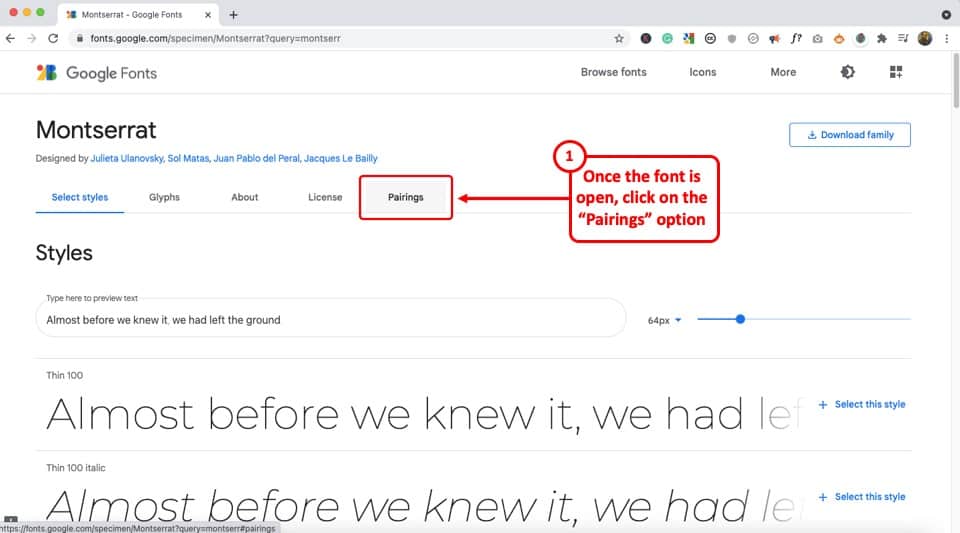
The next step is to choose a font. You can either type one of the fonts that I mentioned in the search bar and click on it once it appears OR you can also simply choose from the list provided below.
Just make sure that you click on the font that you like to open it.
Once the font is open, click on the “Pairings” tab on the top (as shown in the image).
Step 3 – Choose a Font Pair

Now simply choose one of the font pairs provided by Google Fonts. You can also click on a font pair to see how it looks on the section on the right.
Play with the options provided and choose the font combination that you like.
Now, simply go back to your Google Slides presentation and change the fonts according to your selection.
5. Choose the Right Color Combination
Just the way fonts are an important part of your Google Slides presentation design, choosing a good color combination can make your presentation look visually appealing, consistent, and professional.
Unfortunately, a lot of struggle with choosing a good color combination. Thus, I highly advise going with a monochromatic color scheme.
A monochromatic color scheme in a presentation provides a variety of color combinations of the same color. This makes your presentation look consistent and professional.
Moreover, using a monochromatic color scheme is a perfect way option for a beginner as it requires the least amount of time and effort to set up!
Check out my other article on using a monochromatic color scheme for presentations to understand the topic in-depth.
Then, also check out how to use the eyedropper tool in Google Slides to implement the color scheme that you end up choosing.
Make sure that you change the color at the theme level in Google Slides instead of changing it on every single slide. This will save you quite a bit of time!
6. Use the Expore Tool to Generate Slide Designs
Once you’ve decided the fonts, color scheme, and theme, and you have the content structured out, you’ve done most of the hard work!
All you are now left to do is create the slide designs. And, to help you with that, make sure that you use the “ Explore Tool ” in Google Slides.
The “Explore” feature in Google Slides generates slide designs based on the content that is already present on the slide. It is a great way to get a slide designed almost instantaneously!
The “Explore” feature in Google Slides works much as the design ideas feature in PowerPoint.
Based on the content on the slide, it will throw a few suggestions on how the content can be laid out on the slide. You can choose the design you like. If not, you can still design your own slide. But, it is definitely worth trying out first. Pretty cool, isn’t it!
I wrote a detailed article on the Explore Feature in Google Slides . Make sure you check out that article to learn where to find this tool and know how to use it!
That said, one thing to keep in mind is that this feature is still an experimental tool . And, while it is getting better with time, I wouldn’t recommend using it with every single slide.
In my experience, I’ve noticed that using the “Explore” feature in Google Slides works best when you want to create a title slide, a section break slide, or just want to get a few ideas on how the slide can be designed.
7. Apply the 3 by 3 Design Rule
The 3 by 3 design rule, otherwise also known as “ the rule of thirds “, is a principle that has been borrowed from photography. But, it is every bit applicable even for slide designs and other design elements!
As per the 3 by 3 design principle, you basically need to divide the visual canvas into 3 equal-sized vertical and horizontal grids with the help of 2 vertical grid lines and 2 horizontal grid lines.
Here’s a video that explains the concept of the rule of thirds for presentations –
Using these grids helps place the content correctly in the grids such that the key message usually aligns with the way our eyes like to see them visually!
The 3 by 3 design principle may seem confusing at first, but once you’ve understood how to use it, you can literally take your presentation design skills a few notches above the rest!
Using 3X3 Grids to Properly Layout Content on your Slides
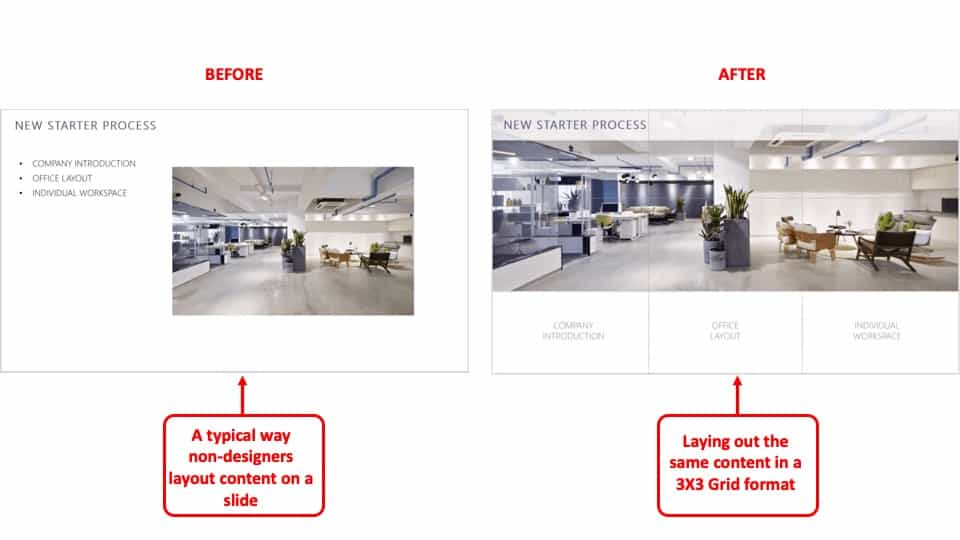
The interesting thing is, you can take the same principle to make it work with elements apart from the images that are present on your slide. And, the results are just amazing!
The picture above shows how most people design their slides (on the left). However, you can literally transform the way your slides look by applying the concept of 3×3 grids to any existing content on the slides! (as shown on the right part of the picture above)
Here’s another video that explains how this concept of 3 by 3 grids can be used to take any existing slides and make them better (if they aren’t properly organized).
8. Use Powerful Images
They say – “An image speaks a thousand words!”. This absolutely holds true when it comes to big impact presentation!
If you recollect any one of the top presentations from Steve Jobs. His presentation was almost always using powerful images with very few words on them.
Using images, as opposed to a lot of text, on your presentation has a few advantages of its own –
- Visual Appeal – Using images makes the slide visually appealing. Think about it – if there aren’t too many objects placed on the slide, the chances of making design related mistakes are also far lower!
- Emotional Connect – Using images creates a subtle emotional connect in the minds of the audience with the topic of the presentation and/or the presenter.
- Audience Focus – When you use text on a presentation, often the audience just reads the text and doens’t want to listen to the presenter. Instead, when using the images, you control the focus of the attention of your audience. Once you have their attention, making a presentation impactful is a lot easier!
- Faster Design Process – In most cases, it is faster to find an image and add it to the presentation rather than think of a way to design a slide to communicate a concept. This is especially true if you have only basic design skills.
If you watch some of the most famous TED or TEDx presentations ( know the difference between TED and TEDx presentations here ), it is quite common to see presenters using high-impact images with text. Ever wonder why is it so?
Well, one of the most important reasons is that you are able to control the attention of the audience!
Now, if you are wondering how to find images for your presentation, keep reading as I’ve got some great recommendations for add-ons later in the article!
9. Keep the Text on the Slide Readable
If using images for most slides is not the way for you, then this section is going to be quite important!
In fact, even if you do plan to use just images on your slides, there may still be a few slides where you will need to have some text. If so, make sure that the text on the slide is readable!
Make sure that you don’t use text that is too small to read.
As a general rule – the further the audience is going to be away from the screen, the larger the size of the text!
Here’s what to remember for the size of the text on the slides –
- Presentation seen on a computer screen – If the presentation that you are designing is going to be seen on a computer screen (either over an email or a zoom call), then make sure that the font size used for the presentation is not less than 16 points .
- Presentation seen on a large screen – If the presentation is going to be delivered in an auditorium, then it is recommended to use a font size no less than 30 points . For the rest of the situations, anything in between should be fine!
Also, make sure that you don’t use too much text on the same slide. Remember – you only need to cover one key topic on one slide.
It is totally okay to just use one word in the middle of the slide, and talk about that topic rather than using text from a complete word document on a slide!
If your audience will have to squint to read what is written, it just creates a bad user experience and they quickly lose interest.
Also, for the above reason, don’t include everything on the slide that you plan to say! If you do so, you may come across as a person who is just reading from the slide! Most importantly, the audience is going to end up reading the text from the slide faster than you speak, and end up losing interest in the presentation!
10. Ditch the Bullet Points (Use Infographics Instead!)
Using bullet points on a presentation is so 1990s! It’s just not the way good presentations are given anymore!
If you want your presentation design to look good, make sure that you get rid of bullet points. Instead, you can either use images, icons, or even infographics!
I’ve written an entire article on how to use infographics in Google Slides where I also talk about SmartArt and charts in Google Slides. Make sure you check out that article!
There are a ton of different ways in which you get infographics for Google Slides. I’ve talked about that also in the same article that I’ve linked above.
Likewise, you can also use icons instead of bullet points. Although adding icons to Google Slides is not an option that is available by default, there are a few ways you can work around this problem. For instance, you can use an add-on like “Flaticon” that provides free icons for Google Slides!
If you are wondering how to create a slide with bullet points and use icons or other methods, here’s a good example of an actual client slide that I redesigned –
As you can see on the image, simply using icons and structuring the text to give proper hierarchy to the information can make all the difference to the design of the slide!
In case you don’t want to use icons, you can also use numbers with circles, and use a similar design instead of just adding bullets to your presentation. If you do so, your presentation will still look good!
11. Avoid Using Just Table or a Graph
The next tip to remember is to avoid using just a table or a graph on a slide. Make sure that you also include a few points that act as key takeaways from the information that you provide.
Using just a table will present a lot of information on a single slide. This will definitely cause an information overload. And, even though your audience may be able to assess what is being presented to them, it is important to either highlight key pieces of information in the table or a graph.
Alternatively, you can also add a couple of lines of text indicating the key learnings from the data set.
Don’t get me wrong, it is important to have data sets on a presentation if you have one! But, just make sure that you also highlight key pieces of information that your audience should pay attention to.
12. Keep Animations and Transitions Subtle
Another design tip that you should keep in mind is the use of animations and transitions in Google Slides.
You want to make sure when using animations in Google Slides , you don’t add any funny movements. Think old school when using animations and transitions in your presentation.
Any additional movement or sudden transitions can distract the attention of the audience from the core topic and the messaging of the presentation.
So, make sure that you keep the use of such animations or transitions to the minimal!
13. Use Professional Google Slides Templates
If you find that the free template doesn’t have enough slide layouts for your presentation or doesn’t really fit the topic of your presentation, you may want to consider using professional templates!
There are a ton of different ways you can get templates for Google Slides. Unfortunately, most of the free options (and even most paid options) have outdated designs!
My personal favorite method for getting amazing Google Slides presentation templates is using Envato Elements .
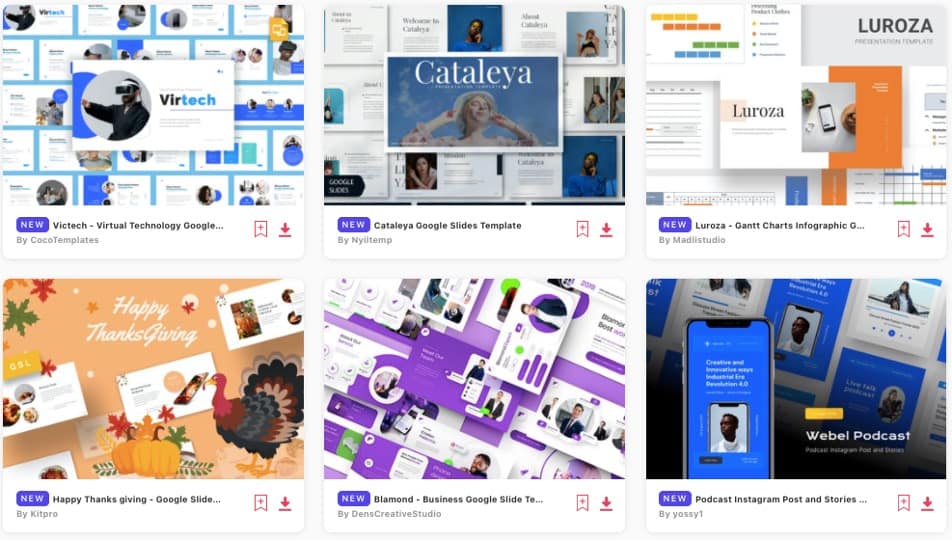
The best part about using Envato Elements is that not only does it provide you with the best-in-class designs for your templates, but it also provides you with an option to download an unlimited number of presentations! (yes, you hear that right!)
Moreover, the pricing of Envato Elements is also really affordable! All you need to do is click on Envato Elements to visit the website, view the templates, and click on the “ Get Unlimited Downloads ” button on the top.
You will be prompted to sign up and pay a subscription. Just go for a monthly subscription and pay for one month (You can easily remove the payment method and cancel your subscription anytime).
Once you’ve logged in, simply cancel your subscription. Your subscription will be valid until the next date of renewal even if you cancel it.
Now, for the one month that you’ve paid, feel free to download all the templates that you like including templates for Google Slides, and PowerPoint!
14. Use Add-ons for Faster and Better Designs
One of the challenges with Google Slides, as opposed to some of the most reliable presentation design software, is the limited number of features it offers.
I suppose we should not really be complaining about it given that we do get a great presentation design application for free along with several additional advantages with Google Slides ! That said, you do feel the need for a few pro-features that PowerPoint has to offer.
However, one way to fix this problem is to use add-ons with Google Slides!
Using add-ons allows you to use third-party tools and bring additional functionalities to your Google Slides presentation!
Add-ons on Google Slides are easy to add. Simply go to the Google Marketplace, and search for the add-on that you would like to add. Install it, and you are done!
Check out my complete guide on using Add-ons on Google Slides where I not only talk about how to use add-ons in Google Slides, but I also provide you with my personal favorite top 5 recommendations of add-ons that you should be using in Google Slides!
15. Hire a Professional
Well, the last tip is not so much as a tool that you can use on Google Slides. But, it is a great hack to ensure that you create great presentation designs!
Simply hire a professional to do the design work for you! You may be wondering that hiring a presentation professional might be difficult. However, that is not the case.
You can easily find some really good presentation designers on Fiverr , and you can start at as little as $5 to $10 dollars per slide! I’ve personally used freelancers from the site, and although finding a good freelancer may take you 15-20 minutes, you can easily outsource your work and let the designer worry about the rest!
The best part is – you don’t have to pay a single penny to hire a professional. You only pay to get the work done!
There are a ton of other platforms to hire professionals that can design a good presentation for you. However, I have found Fiverr (especially for presentation design work) and Upwork to be the most effective.
A Few Things to Remember When Delivering the Presentation
Once you have created an amazing Google Slides presentation, you are perhaps ready to deliver the presentation. However, I’d like to also share a couple of tips that can be helpful when you plan to give the presentation!
So, here they are –
1. Use a Presentation Remote
It doesn’t matter whether you are giving a presentation in an auditorium or online through Zoom or Microsoft Teams.
Using a presentation remote helps you keep your hands free and allows for free movement and hand gestures. This does help engage with your audience.
Check out my other article on using presentation clickers with Google Slides where I provide you with a few tips and recommendations on which remote you should go with.
2. Use the Q&A Tool in Google Slides
A unique feature that Google Slides provides is the Q&A tool. This is great especially if you are delivering a webinar-style presentation or if you are simply addressing a large gathering.
This tool allows your audience to send questions during the course of your presentation. Then, at the end, you can simply view the questions in the Q&A session and answer them one by one!
It is a great way to deliver an engaging presentation using Google Slides!
Credit to cookie_studio (on Freepik) for the featured image of this article (further edited).
Sign up for our daily newsletter
- Privacy Policy
- Advertise with Us
8 Tips on How to Make Google Slides Look Good
Expect your audience to not be very impressed if you have a generic Google Slides presentation. They’re used to seeing similar information online, and this makes it difficult for you to get through to them. Deliver your point effectively by learning how to make Google Slides more pleasing to the eye in this guide.
Tip: already have a great-looking presentation? Learn how to extract images from Google Slides or PowerPoint .
How to Make Google Slides Look Good
1. choose the right slide layout, 2. use an appropriate color scheme, 3. choose a font based on application, 4. insert infographics, 5. embed videos and gifs, 6. add animations and transitions, 7. interact with audience using the q&a tool, 8. use google slides templates.
While the definition of a “good-looking presentation” is very subjective, there are some benchmarks that you can refer to. The following eight tips can improve the appearance of your Google Slides presentation:
Position your photos and text at optimal locations on a slide so that your audience can read and consume the details you’re presenting without hassle. But where are these “optimal locations”? That’s where slide layouts come into play.
When you add a new slide to a Google Slides presentation, you have an option to choose a layout. The layouts are preset with image placeholders, text boxes, title boxes, and similar elements. You just need to insert your content.
Find the slide layouts by clicking the downward arrow beside the “New slide” button in the toolbar. Choose one of these common (but effective) slide layouts:

- Section header: use this layout to separate your content into different sections. It also helps your audience understand when you’re transitioning to another topic.

- Title and body: this is likely to be the layout you use most often in your presentation. Use it to present an idea with supporting bullet points.

- One column text: this layout is good to use when you want to insert a supporting photo beside a text box.

- Caption: Sometimes a picture can convey more meaning than a slide filled with text. For full-screen photos, the caption slide is the best option.

- Big number: when presenting important figures and statistics, this layout will help deliver a better impact among your audiences.

Good to know: learn how to add a chart to your Google Slides presentation .
Colors play a vital role in setting the mood of your presentation. If you choose the wrong color scheme, you may not be able to deliver your point clearly. Worse, your audience could get distracted if you choose tacky colors.
Consider the context and audience of your presentation when choosing a color scheme:
- Monochrome for formal scenarios: when delivering keynote presentations, pitch decks, and other business reports, use colors that look more formal. Consider black and white themes or incorporate varying shades of blue to add visual interest to your slides.

- Vibrant themes for the creatives: if you’re running a creative studio or making a presentation related to marketing, consider using more vibrant colors. Make sure you find the right blend to showcase your own creative abilities.

- Utilize your brand colors: if you want to showcase your products or services in your Google Slides, why not use your brand’s colors? This would give more emphasis to your products and increase brand awareness.
Aside from the appropriate slide colors, remember to apply your chosen color scheme to other elements as well. Ensure that the color of your text contrasts nicely with the background for optimal readability. Simply put, use light-colored fonts for dark backgrounds and vice versa.
When selecting fonts, consider looking up font psychology on the Web. Basically, it shows how different styles of fonts can evoke emotion or tone among people. The following are the three major font categories:
- Serif: use this when delivering formal presentations, especially in academic and corporate applications. Examples include EB Garamond, Lora, and Roboto Serif.

- Sans serif: for more casual applications, use a sans serif font, such as Arial, Lexend, and Work Sans.

- Script: if you want to showcase your creativity, such as for art presentations and marketing pitches, a script font may be more appropriate. Examples are Caveat, and Lobster. You can also opt for a “hand-drawn” font, such as Amatic.

Whichever you choose, use only two to three fonts in your Google Slides presentation. This way, you provide enough visual interest to your slides and avoid making them look tacky. Pairing serif and sans-serif fonts for the title and body text is a great way to start.
Remember to experiment with the font sizes, too. Establish a visual hierarchy using bigger fonts for headers and smaller fonts for the details.

Good to know: use these tools to identify fonts in images .
Infographics provide a more interesting and meaningful way to present your data compared to plain text. Since there are graphics and visual cues involved, your audience can consume the content more intuitively (like in a process flow diagram).

Google Slides offers numerous kinds of diagrams, from grids to cycle charts. Whichever you choose, ensure that it matches the set of information that you’re presenting. For example, you can use a timeline chart when presenting the milestone years of your brand.

To add an infographic in Google Slides, go to “Insert -> Diagram.” Select your preferred chart, and edit as needed.

Videos are great supporting materials in your presentation, especially when you’re discussing complex topics. You have two source options here: YouTube and Google Drive.
Inserting a Video From YouTube:
- Go to YouTube and find the video that you want to insert.
- Click the “Share” button.

- Choose “Copy.”

- Return to your Google Slides presentation.
- Go to “Insert -> Video.”

- Click the search bar at the top, and paste the link that you copied.
- Select the result that appears.
- Click the “Insert” button.

Inserting a Video From Google Drive:
If you want to use videos that you have previously recorded or ones you downloaded from Facebook, upload them to your Google Drive account first, then insert them into your slides as instructed below:
- Go to your account on Google Drive , and select your video.
- Right-click on the video, then choose “Share -> Copy link.”

- Return to your presentation.
- Choose “Insert -> Video.”

- Switch to the “Google Drive” tab, then paste the link you copied to the search bar at the top.

- Click “Insert” to finish.

When using a video in your presentation , remember that it’s only supporting material. Ensure that it lasts no more than two minutes on a slide. Keep the number of video clips to a maximum of three in your entire presentation, too.
For short clips that span only a few seconds, we recommend using GIFs instead. They’re much lighter in storage than videos and would be just as effective. You can add one by choosing “Insert -> Image” in the menu bar.

Whichever source you prefer to use is up to you. You can search for photos online in an app, upload them from your drive or local storage, or copy and paste the URL of your image.
Tip: running out of space on Drive? Learn how to delete files from Google Drive to gain more room .
Using animations and transitions can make your Google Slides more attractive and enjoyable. They make your presentation appear less static and can also help with the pacing of your discussion.
When adding them to your slides, ensure that they are uniform throughout. For animations, it’s good to use up to two styles. For transitions, apply a single effect to every slide to not risk distracting your audience. Follow the steps below to add animations and transitions:
- Go to “Slide,” and select “Transition.”

- Select your preferred effect in the side panel under “Slide Transition.”
- Adjust its speed as necessary.
- Click “Apply to all slides.”

- Under “Object Animations,” select the effect you want to apply to your text or object.

- Preview your transition and/or animation using the “Play” button.

Note: we recommend that you avoid using the “Spin” animation for normal text, as it can be distracting. This also applies to the “Flip,” “Cube,” and “Gallery” transitions.
Related: want to whiz along more quickly when creating your presentation? Check out these Google Slides keyboard shortcuts .
After attracting your audience’s attention, go a step further to keep them engaged. One of the best features that you can use in Google Slides is the Q&A tool. Follow these steps to implement it:
- Click the “Slideshow” button in the top-right corner of your screen.

- Choose the More icon (vertical three dots) in the lower-left corner.
- Select “Q & A” from the list.
- Alternatively, press the “A” key on your keyboard.

- Click “Start new.”

You can enable this tool from the very start of your presentation. There will be a link displayed on top of the presenter screen where your audience can send their questions and concerns. This link works until you disable it or your presentation ends.

The questions will pool in the Q&A tool as your presentation progresses. Ensure that you allot time to address them. You can find the questions in the same tab as the steps above.
Given our tips, you probably realize that creating a visually appealing presentation consumes much time and effort. You may want to use a Google Slides template to save time for other tasks.
Templates already follow a structured format, from the design elements to the layout. Just insert your content, and customize the template to your needs.
FYI: make it educational for your kids by creating a simple flash card game in Google Slides .
Final Thoughts
A good-looking presentation doesn’t just impress your audience – it also ensures that your point comes across. To create an effective Google Slides presentation, consider using preset layouts and templates, and select the right colors and font styles to properly set the mood of your presentation.
Infographics, videos, and other visual cues would also be beneficial. And to top it off, consider using the Q&A tool to keep your audience engaged.
Want to learn more? Take a look at these 10 Google Slides tips to save you time .
Image credit: Unsplash . All screenshots by Princess Angolluan.
Our latest tutorials delivered straight to your inbox
Princess is a freelance writer based in Croatia. She used to work as an English teacher in Hokkaido, Japan before she finally changed careers and focused on content writing & copywriting, while running their own digital marketing company in Europe. For 5 years, she has written many articles and web pages on various niches like technology, finance, digital marketing, etc. Princess loves playing FPS games, watching anime, and singing.

- PowerPoint Themes
- Latest PowerPoint Templates
- Best PowerPoint Templates
- Free PowerPoint Templates
- Simple PowerPoint Templates
- PowerPoint Backgrounds
- Project Charter
- Project Timeline
- Project Team
- Project Status
- Market Analysis
- Marketing Funnel
- Market Segmentation
- Target Customer
- Marketing Mix
- Digital Marketing Strategy
- Resource Planning
- Recruitment
- Employee Onboarding
- Company Profile
- Mission Vision
- Meet The Team
- Problem & Solution
- Business Model
- Business Case
- Business Strategy
- Business Review
- Leadership Team
- Balance Sheet
- Income Statement
- Cash Flow Statement
- Executive Summary
- 30 60 90 Day Plan
- SWOT Analysis
- Flow Charts
- Gantt Charts
- Text Tables
- Infographics
- Google Slides Templates
- Presentation Services
- Ask Us To Make Slides
- Data Visualization Services
- Business Presentation Tips
- PowerPoint Tutorials
- Google Slides Tutorials
- Presentation Resources

Google Slides Tips and Tricks 2024: How to Make Google Slides Look Good?
Google Slides tips and tricks have been so helpful, especially to those who are new to this online tool in professional settings. Learn how to make Google Slides look good through our latest Google Slides tips and tricks, elevating your content with design finesse and engaging visual appeal.
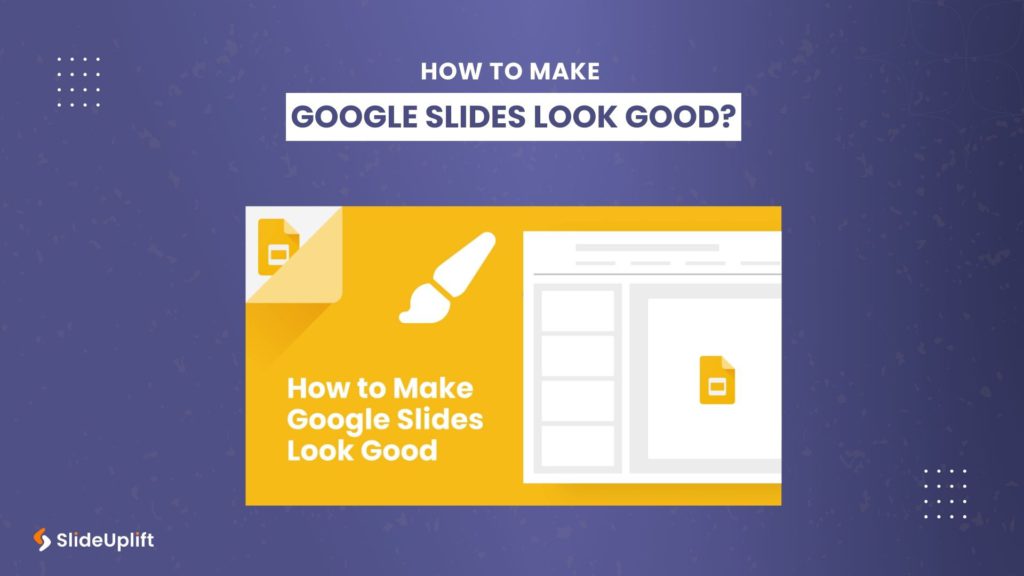
Google Slides is a go-to tool for making outstanding presentations, thanks to its user-friendly interface, accessibility from anywhere, and easy collaborative options. It improves presentation skills regardless of whether you’re a working professional or a student. In addition, it is a great choice for teams that work remotely. Hence, you should consider learning how to make Google Slides look good.
Learning some quick and easy tips and tricks for Google Slides presentations can help you create, edit, and present more effectively. In this blog, you will discover how to make a good Google Slides presentation by incorporating tips and tricks to enhance the overall visual appeal of your presentations. So, let’s get started.
What Are The Benefits Of Good Looking Google Slides?
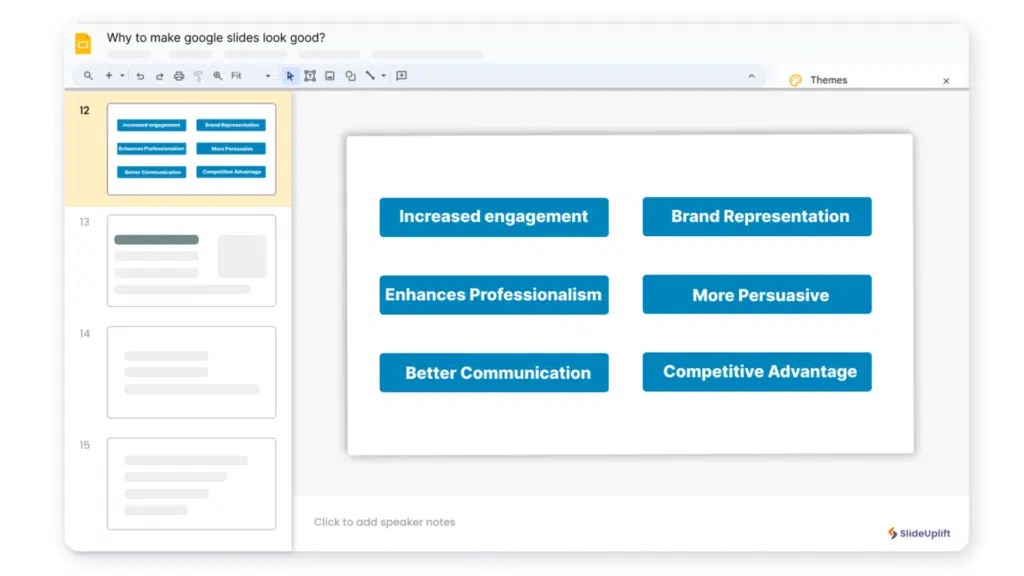
Several good reasons explain why making your Google Slides look good is crucial:
Increased engagement
Beautifully crafted to not only spark interest but retain a focus that will have your audience stay hooked right through your presentation. Well-designed slides can engage interest and maintain focus, which ensures increased information retention.
Enhances Professionalism
It shows professionalism. Well-prepared, this presentation points out your professionalism. It is proof of investing time and effort into producing a sleek, visually appealing deliverable, a factor speaking to the credibility and authority of your presentation.
Better Communication
Clear, visually attractive slides help you communicate your message to the audience. These may be pictures, graphs, or charts that draw the audience’s attention to certain points or explain difficult ideas.
Brand Representation
Google Slides ensures that your brand is consistently represented through common design elements like color schemes, fonts, or logos. That way, with the consistency in the Google Slides presentation and that of your brand’s visual guideline, an image of cohesion is portrayed, signaling professionalism. Hence, you should consider how to make Google Slides look good.
More Persuasive
Presenting your slides visually and aesthetically increases the perception and persuasiveness of your target audience. Research has shown that individuals are more likely to be persuaded by information that is presented with visual appeal. You can make slides attractive so that you have more persuasive power in presenting your ideas.
Competitive Advantage
Presentations are mostly used in academic, professional, and corporate worlds to display concepts, projects, or proposals being made, whether orally or in writing. When your presentation is visually compelling, you have a competitive advantage, and the decision-maker or stakeholder will remember you.
Create Your Presentation Outline First
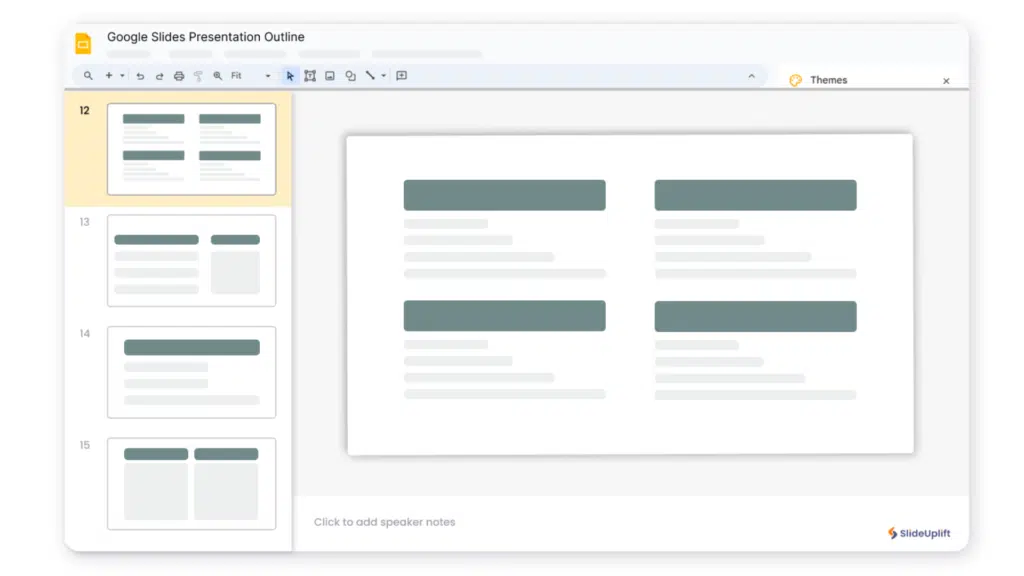
The first and foremost step to making a good-looking Google Slides presentation is to plan it out. You should create an outline before actually creating your Google Slides presentation. How can you effectively design a presentation without thinking about what your slide will present? That’s why before discussing how to make Google Slides look good, we will see how to create an outline.
An outline of the presentation ensures that you include all the crucial elements and meeting agenda in your slides. It helps you clarify the goal of the meeting. It also saves time and makes the whole process more effective, as you already know what items to add to the presentation.
You need to think clearly about your discussion topic and meeting agenda to create an outline. A few things to consider while making the outline are as follows :
- What are the objectives you want to achieve from this presentation?
- Who is your audience?
- What are the frequently asked questions?
- How will you structure the content?
After you have listed all the required elements, you are ready to create the Google Slides presentation. Now, let’s discuss how to make your Google slides look cool.
How To Make Google Slides Look Good?
Making good-looking presentations is crucial for effective presentation and to captivate your audience’s attention. Google Slides has various features that can be used to improve the appearance of your presentation. Here are a few Google Slides design tips and tricks to help you improve your visual elements and capture audience attention:
Choose Better Slides Layout
- Add well-structured quality content
- Pay attention to fonts
- Select the right color
Mask Your Images Into Different Fun Shapes
- Include animations and transitions
- Use Infographics to present data
Add a Q&A section to make your presentation interactive
Let’s look deep into each of these tips on how to make Google slide look good:
The most crucial aspect of making a good-looking presentation is its layout. Google Slides offers multiple layout options so you can better present your content. It provides placeholders for texts, images, and other elements where you can easily add your content. Choose a layout that best suits your presentation style and customize it according to your needs.
You can utilize the master slides tool. All you have to do is customize the master slide, and all the settings of your master slide will reflect in all the other slides. This master slide can help you change the backgrounds, themes, and placeholders of all your slides. It will save you time; you won’t have to edit each slide separately. Using the master Slides tool also ensures consistency throughout your Google Slides presentation.
Add well-structured & quality content
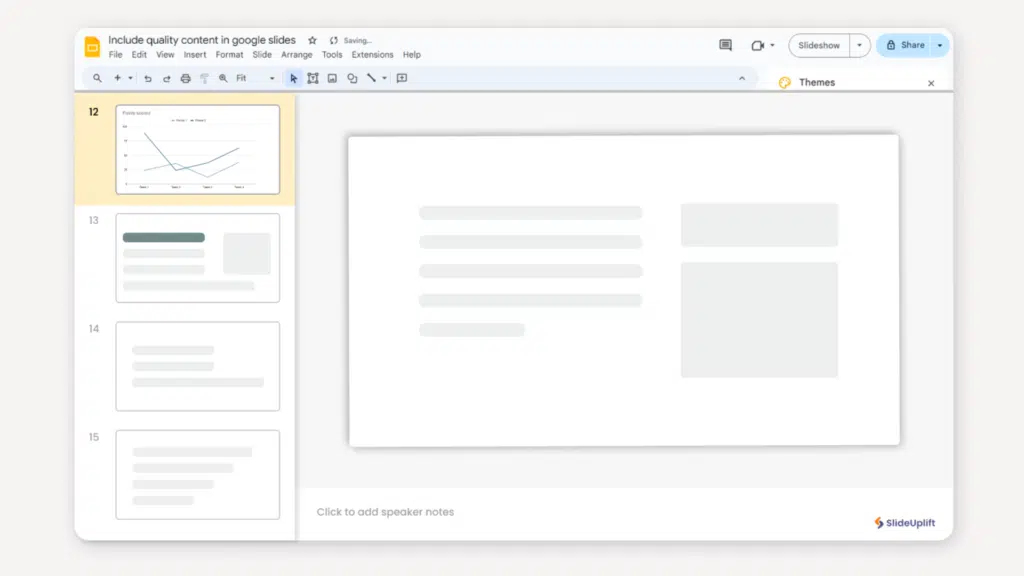
We all know content is the king. You can try all the hacks to make your Google slides look good, but they will not attract your audience unless the content is of good quality. Your content should have a clear hierarchy with headings and texts. Your audience should clearly understand what you are talking about. Keep your font size consistent. Well-structured content with a good flow of information always works.
Your slides should contain well-structured and formatted content. This means you have to present your content in a flow—start with the basics and then gradually discuss each section. This keeps your audience aligned with the presentation, and it’s easier for them to comprehend your point.
How to make Google Slides look good using proper fonts?
- Choose fonts that are easy to read, legible, and clear. You can also choose to add fonts to your presentation to improve your text.
- Create a visual hierarchy by using various font sizes, weights, and styles.
- Make sure that essential headings and titles are more noticeable, and supporting material should be less stressed or smaller.
- Predefine the font size based on the headers and in a single slide. To maintain consistency and avoid visual clutter, limit the number of typefaces you use to two or three.
READ MORE: How to Embed Fonts in PowerPoint?
Select The Right Colors
- Choose a consistent color scheme that goes well with your presentation.
- Apply the principles of color theory and vision sciences to produce pleasing pairings and recognize the psychological effects of various hues to use them to communicate messages.
- Use colors to highlight crucial components, such as headlines, titles, critical information, or call-to-action options.
- Ensure sufficient contrast between the text and backdrop colors for reading. Dark text on a light background or vice versa makes for the best readable combination.
Add Images
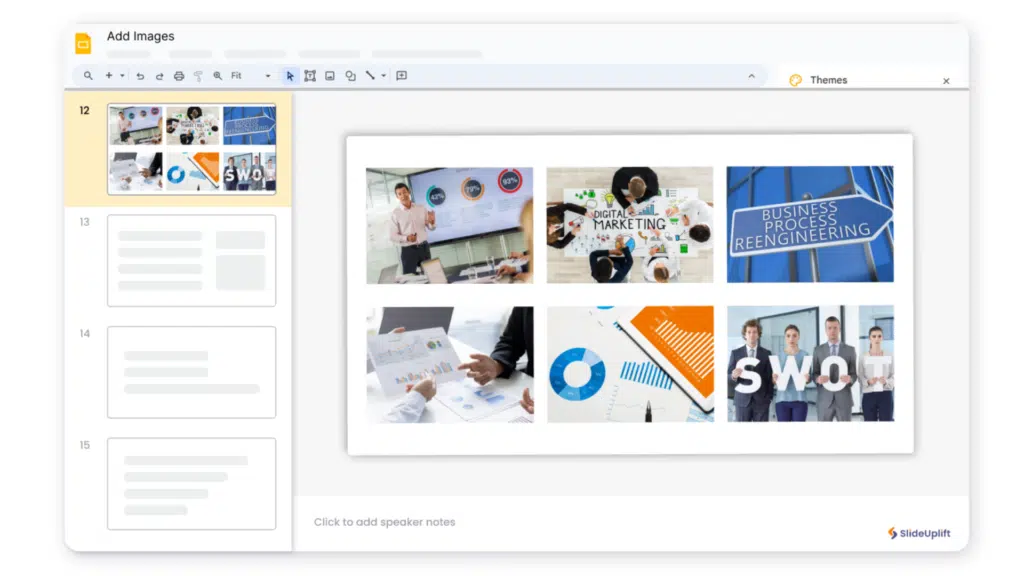
A presentation with only text is dull, especially if it is lengthy. Too much text makes your presentation boring, and your audience might lose interest. The best way to keep your audience hooked is by using Images. Add Images that align with your content piece. The added images will enhance your presentation, and it will become easy for your audience to grasp the concept.
Your image should clearly portray the theme you are talking about. Even if users don’t read the text, they will still understand the topic just by looking at your images. You should add images at regular intervals to make your Google slides visually appealing. Ensure your images have a consistent visual style across your slides.
Reflect the Images
You can also use this feature for some of your images in Google Slides to make your presentation more creative and grab your audience’s attention.
To apply this feature, select the image you want to reflect, go to the “Format” option, and choose the desired reflection. Click “Flip horizontally” or “Flip vertically” to reflect the image along the horizontal or vertical axis. You may adjust the size and transparency of your image.
Now we will discuss how to make Google Slides look good using shapes. Break free from the confines of square or rectangular images. Unleash your creativity by transforming your images into various PowerPoint shapes , arrows, callouts, or equations using Google Slides. Here’s how:
- To access the hidden photo masking choices, click the image you wish to cover up on your Google Slides presentation.
- Locate the ‘Mask picture’ option near the Crop symbol. It’s the tiny triangle button that you need to toggle. To reshape your image, choose the shape, arrow, callout, or equation you want to use. There are numerous shapes to choose from.
- Using shapes, arrows, callouts, and inserting equations , you may alter images in Google Slides.
Feel free to try new things and explore your alternatives. Remember that you can permanently erase changes you make to Google Slides.
READ MORE: How to Make An Image Transparent in Google Slides?
Use Infographics to present data
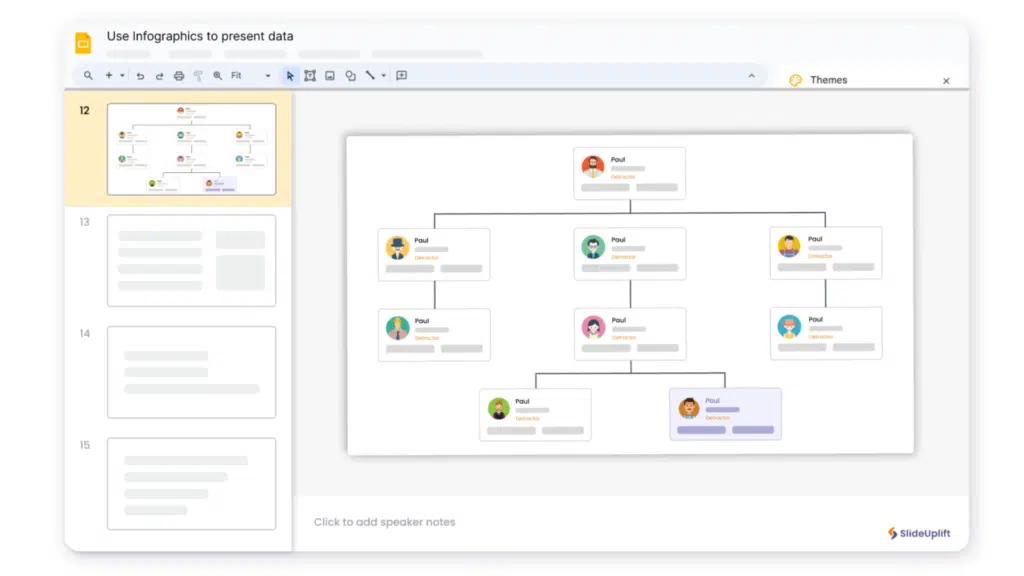
Infpgraphcos combines information and graphics to help you present complex data easily. Infographics are suitable for showcasing diverse data, like process steps or historical values, not just paragraphs or charts. Even Google Slides offers a built-in feature to create infographics.
You can create infographics by navigating to the Insert menu and selecting diagrams. From there, you can choose multiple templates, such as hierarchical charts or flowcharts . You can customize the infographic and add content and colors to suit your preferences.
Use infographics templates , or make one yourself using graphical tools. Convert two long paragraphs into visually engaging bullet points in Google Slides presentation using infographics.
How to make Google slides look good with Animations & Transitions?
Now, we will discuss how to make slides look good. Transitions and animations are some of the visual effects offered in Google Slides. These effects increase how the slides change from one to another and how elements in the slides either appear or move while making a presentation. These attributes make them livelier and more attractive.
Transitions
These assist in controlling how slides change from one to the other during the presentations. The transitions are the movements and effects to and from slides that set the stage for its movement from slide to slide. Some common effects include fades, slides, flips, and dissolves.
Google Slides offers different transition options that may be assigned to individual slides or even the whole presentation. Animations:
Slide animations help in adding movement and effects to text, pictures, shapes, and other elements of an individual slide. They can appear, disappear, or move from place to place on the slide. The users are able to add animations to individual elements and set the timing, duration, and effect details for those elements. Among those are entrance animations, exit animations, emphasis animations, and motion paths. Users may add animations to specific elements and set up their timing, duration, and effect by applying custom emphasis, exit, or entrance animation to the object.
Follow the below tips to learn how to make your Google slides look better by adding animations and transitions:
- Choose smooth, unobtrusive slide animations and transitions. Avoid using distracting or flashy effects that might obscure your text.
- Create visual links between slides for seamless flow using one transition.
- Adjust timing for a smooth pace of transition, enabling the audience to follow the progression of your slides smoothly.
- Employ animations judiciously to emphasize essential points or reveal information by selecting animating text, photos, or charts.
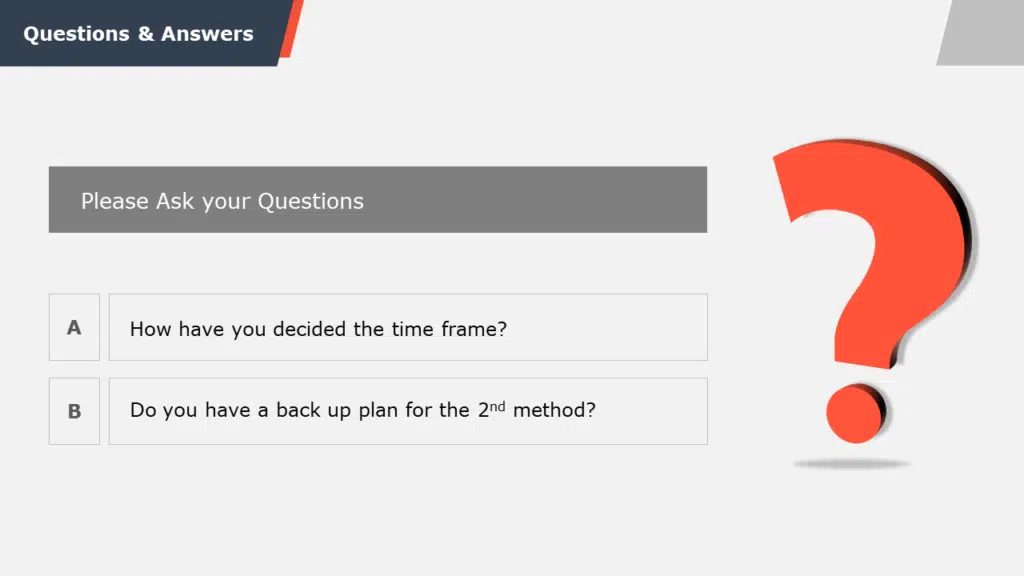
Let’s discuss how to make Google Slides look good by adding a Q&A section at the end. The best presentations are interactive in nature, where both parties engage—the presentation host and the audience. To fully engage your audience, you should add an O&A section at the end of your presentation. It will allow you to address and resolve your audience’s queries during the presentation. Allow your audience to ask questions and provide them with clear answers.
Google Slides Tips And Tricks
Getting well-versed with some of the most essential Google Slides tutorials and hacks is vital to making your presentation unique and appealing. Below are some of the most used Google Slide hacks and tricks:
- Maintain consistency across slides
- Insert images directly from Google Images
- Add various Google Slides diagrams
- Modify the slide master to make extensive changes
- Embedding YouTube videos to Google Slides
- Use Google Slides Templates
How to make Google Slides look good by Maintaining Consistency Across Slides?
Are you thinking about how to make your Google slides look cool? One of the easiest options is to maintain consistency in your slides. Consistency in Google Slides maintains professionalism, brand identity, and audience appeal.
The consistency of design elements like font, color, or layout retains a professional outlook. At the same time, this is good for the audience because it does not put extra pressure on them, avoiding cognitive loads that enable better understanding and retention of information. Consistent branding elements might further help in branding identity and sometimes even help improve the visibility of the brand.
At the same time, templates and master slides foster the process of presentation creation in general since visual inconsistencies and lack of polished looks across the slides are already taken care of. This, in other words, showed that consistency in design conformed to the better professional, cohesive, and engaging presentation experience of the audience in general.
Insert Images Directly From Google Images
One of the most useful Google slide tips is to insert images directly from Google. There are billions of images indexed in Google Image Search. To add pictures directly from Google Images:
- Open your Google Slides Presentation
- Select “Insert” > “Image” > “Search the web” from the drop-down menu.
- The “Search for Google Images” side panel will display on the right side of your screen.
- Just enter the keyword(s) for your image in the search box below to see the results.
- The final step would be to click on the photo(s) you want to utilize in your slide.
Add Various Google Slides Diagrams
Follow the below steps to learn how to make Google Slides look good:
- Select “Insert” > “Diagram” to add a diagram to your slides. The diagrams side panel will show up on the right side of your screen.
- The six types of diagrams available are Grid, Hierarchy, Timeline, Process, Relationship, and Cycle diagrams.
- Please choose the most appropriate options and make changes until you discover your presentation’s ideal diagram.
One of the most helpful Google Slides tips and tricks has to be adding hyperlinks in your presentation to make it more engaging. Google Slides allows you to add hyperlinks to websites, images, texts in Google Slides presentation. You can link your files on Google Drive and even to other slides in your presentation! Here is how:
- Open Google Slides presentation.
- To insert a hyperlink, click on the text or image you wish to connect to.
- Next, press “CTRL+K” or right-click your mouse and select “Link” from the menu that appears.
- Enter or paste the web URL to add a link.
- Finally, press the “Apply” button.
You can also choose to link slides in the same Google Slides presentation. Google also will show relevant Google Drive files to link to your Google Slides presentation.
Modify The Slide Master To Make Extensive Changes
Instead of editing each slide, you may go to the slide master, and all of the slides in your presentation will be updated immediately:
- Select “Slide” > “Edit Master” to edit your slide master.
- Click or select the elements you want to alter. For example, you can add your company’s logo to the header or footer, and it will automatically appear on all your slides.
Embedding YouTube Videos To Google Slides
You can embed YouTube videos in your presentation, one of the finest methods to make it more engaging. Follow the below steps to learn how to make Google Slides look good:
- Open your Google Slides presentation. Select “Insert” > “Video”.
- You can search for videos in your Google Drive account, add a direct link (URL) to a video that is already online, or search on “YouTube.”
- Clicking on the video will cause the “Format Choices” button to appear on the menu bar, allowing you to edit and format your video.
- The “Format options” side panel will appear on your screen when you click this button.
- You are free to change the drop shadow settings, drop shadow size and position, and the video playback parameters.
Using the above Google slides tips, you can deliver interesting and memorable presentations. Remember that the foundations of an effective presentation are simplicity, compelling imagery, and understanding your audience.
Since you have learned these Google Slides tips and tricks, it is time to apply them using our top Google Slides templates.
Make Use Of Google Slides Presentation Templates
- Optimizing your presentation design with each new presentation is time-consuming. This is where Google Slides templates help.
- Instead of starting from zero, you have pre-made Google Slides themes, in which you can insert your content and alter the template based on the presentation.
- Google Slides includes over twenty preset templates. You can use the theme builder to make changes to each slide individually.
Top 5 Templates for Google Slides Presentations
We discussed how to make Google Slides look good. But, it might be time-consuming for you to create Google Slides presentations from scratch. That’s why we have created numerous Google Slides templates for you to start with. We have compiled a list of the top 5 Google Slides templates:
Project Status Review Deck Google Slides Template
- 30-60-90-Day Plan Google Slides Template
Milestone Google Slides Template
- Startup Pitch Google Slides Template
- Business Review Google Slides Template
- The purpose of the Project Status Review Deck is to discuss and contrast project progress over a given time frame with the project plan.
- They are used In project management. Any project’s success depends on the project status review process.
- The Project Status Review deck provides crucial information in a compact format, helping with effective decision-making and informing all parties.
30 60 90 Day Plan Google Slides Template
- This 30-60-90-Day Plan template is a visual presentation demonstrating thorough planning for the first 90 days of employment.
- The template is divided into three panes that are horizontally spaced apart so that new managers, new hires, team leaders, sales managers, and other users can express their aims and objectives simply.
- 30-60-90-Day Plan Templates can be used as a goal-setting framework to show off your diverse priorities and track your efforts toward various goals.
- This Template gives your presentation a polished, expertly designed elegance. It has five customizable steps that deal with immersion, design, creation, operation, and measurement.
- Professionals use milestone templates when discussing the project’s objectives, activities, and results.
- This template is also available in animation, giving presentations to stakeholders, investors, and clients with a professional image.
Startup Pitch Google Slides Deck
- The Startup Pitch Deck is a valuable pre-made template for companies preparing to introduce a new service or product.
- It is more geared toward companies looking to introduce their fresh product concepts to clients or investors.
- The pitch deck templates are useful for marketers and young entrepreneurs to make presentations on competitive analysis, revenue models, roadmaps, financial needs, etc.
Business Review Dashboard Google Slides Template
- Professionals can display and analyze business data more effectively with the help of this Business Review Dashboard template.
- Its comprehensive dashboard architecture allows users to understandably present performance measurements, financial statistics, and other relevant data.
Google Slides is a flexible platform that enables users to produce engaging presentation material. By adhering to design principles, using its features, and adopting effective presentation techniques, you can create captivating Google Slides presentations that charm your audience and effectively communicate your message.
Using the above tips and tricks for Google Slides, you can deliver interesting and memorable presentations. Remember that the foundations of an effective presentation are simplicity, compelling imagery, and understanding your audience.
You can make aesthetically stunning slides that successfully communicate your message by taking inspiration from several presentation themes and customizing them to your topic. Now that you have learned how to make Google Slides look good, it’s time to put your skills to the test and boast in front of your peers by exploring our vast gallery of Google Slides templates . If you wish to learn more of such tips and hacks to master the art of Google Slides presentation, check out our Google Slides tutorials .
How to make google slides more visually appealing?
Follow the steps below to make your presentation look good on Google Slides:
- Use a suitable Google Slides theme .
- Use consistent fonts.3
- Make use of high-quality photos.
- Layouts should be basic and aligned.
- Use subtle transitions.
How can I choose the best color scheme for my Google Slides presentation?
Keep these Google Slides tips in mind to choose the best color scheme for your presentation:
- Colors should complement the tone and purpose of your text.
- Avoid extremely bright or conflicting pairings.
- Always choose complementary colors.
How can I add visual effects to my slides in the best way?
Here are a few points to add visuals to your slides in the best possible way:
- Ensure a unified design
- Time your animations and transitions carefully. Animations should coincide with your speech and flow naturally.
- Set Master Slide as the default for all fonts, colors, and background components.
How can text and images on a slide be balanced most effectively?
Keep these things in mind to make text and images on a slide look equally balanced:
- Add images to your post to help it along.
- Use visuals, charts, or icons to convey difficult ideas.
- Avoid using only text to highlight crucial aspects.
How can I keep the audience engaged with slides effectively using transitions?
Follow the below steps on how to improve your Google slides:
- Utilize subtle transitions.
- Create seamless visual links between slides for a smooth flow.
- Adjust timing for a natural transition pace.
- Enhance key points with strategic animations.
- Avoid excessive animations that may distract or overwhelm your audience.
Table Of Content
Related presentations.

Customer Journey Roadmap Google Slides Template

Business Proposal Summary Google Slides Template

SWOT Analysis Google Slides Template
Related blogs.

10 Bad PowerPoint Slides Examples to Avoid

10 Best Google Slides Templates And Themes For Presentations

10 Good PowerPoint Presentation Examples
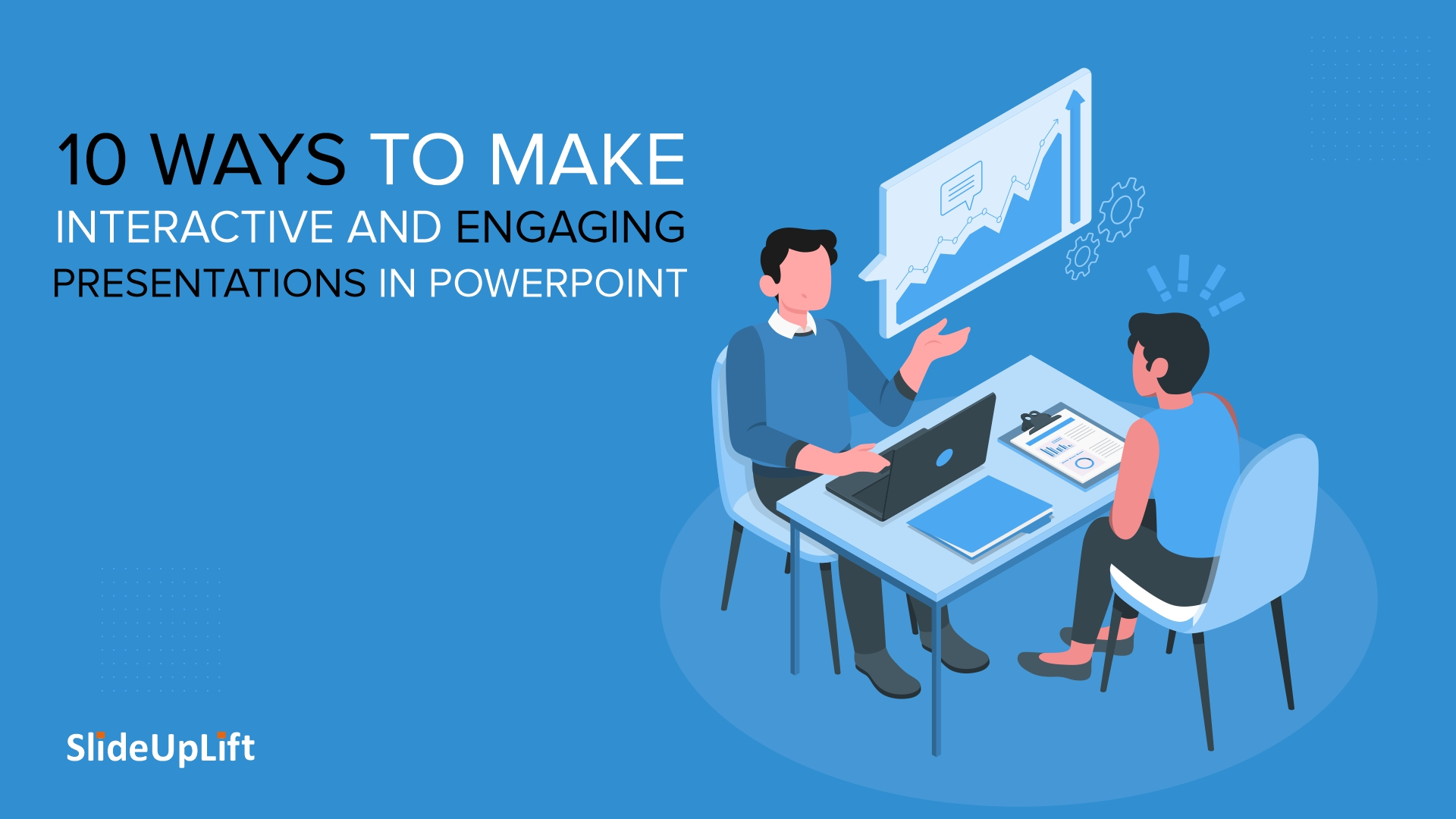
10 Ways To Make Interactive And Engaging Presentations In PowerPoint
Tags and categories, privacy overview.
Necessary cookies are absolutely essential for the website to function properly. This category only includes cookies that ensures basic functionalities and security features of the website. These cookies do not store any personal information
Any cookies that may not be particularly necessary for the website to function and is used specifically to collect user personal data via ads, other embedded contents are termed as non-necessary cookies. It is mandatory to procure user consent prior to running these cookies on your website.
How to Make Your Google Slides Look Cool
Creating a visually appealing and engaging presentation is an art. With Google Slides, you have a range of tools at your disposal to transform a bland presentation into something cool, dynamic, and eye-catching.
Whether you’re presenting to a classroom, a boardroom, or at a conference, the visual appeal of your slides can make a significant difference.
Here, we’ll explore various techniques to elevate the aesthetics and engagement level of your Google Slides presentations.
2 Million+ Google Slides Themes, Presentation Templates + More With Unlimited Downloads
Download thousands of Google Slides themes, and many other design elements, with a monthly Envato Elements membership. It starts at $16 per month, and gives you unlimited access to a growing library of over 2,000,000 presentation templates, fonts, photos, graphics, and more.

Kloe Minimal Template
Clean & simple design.
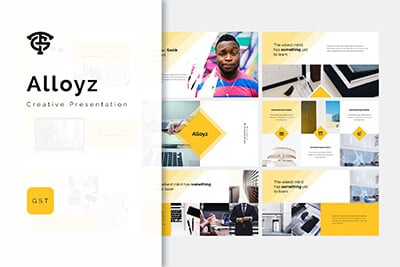
Alloyz Business Template
Google slides.

Creative Template

Company Profile Template
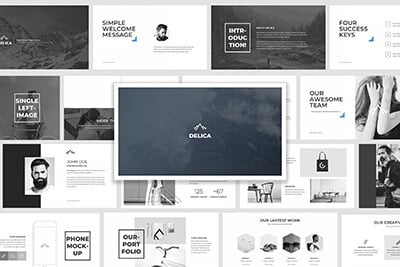
Delica Google Slides
133+ unique slides.
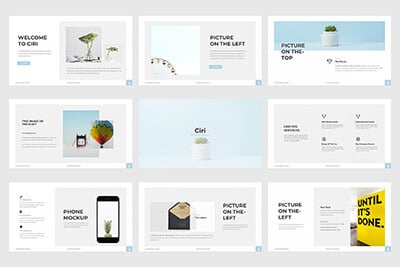
Ciri Slides Template
Clean & minimal.
Explore Google Slides Themes
Step 1: Choosing the Right Theme
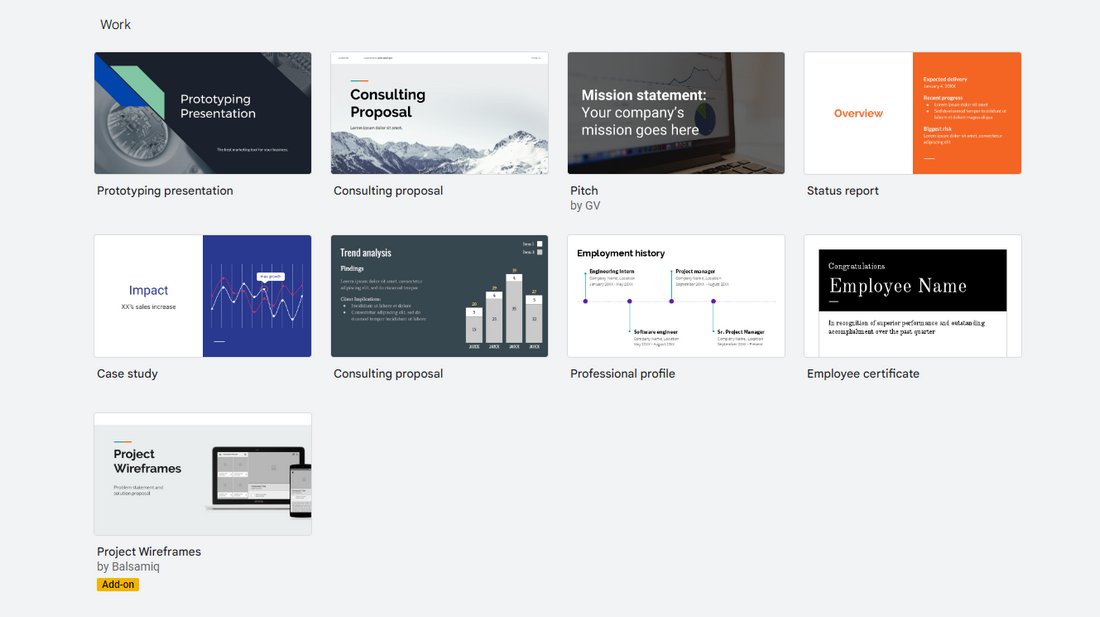
Using a great Google Slides theme is the key to making your presentation look more professional. Not only that, it will also allow you to get a head start on your design process.
Start with a Strong Foundation
Your choice of theme sets the stage for your entire presentation. Access the “Slide” menu, select “Change theme,” and peruse the available options. The theme should align with your presentation’s purpose and tone, as well as resonate with your audience.
Customize the Theme
Once you select a theme, don’t shy away from tweaking it. Adjust background colors, fonts, and layout elements to tailor the theme to your specific needs. Customization can make your presentation more unique, reflecting your personal or organizational style.
Step 2: Using High-Quality Images and Graphics
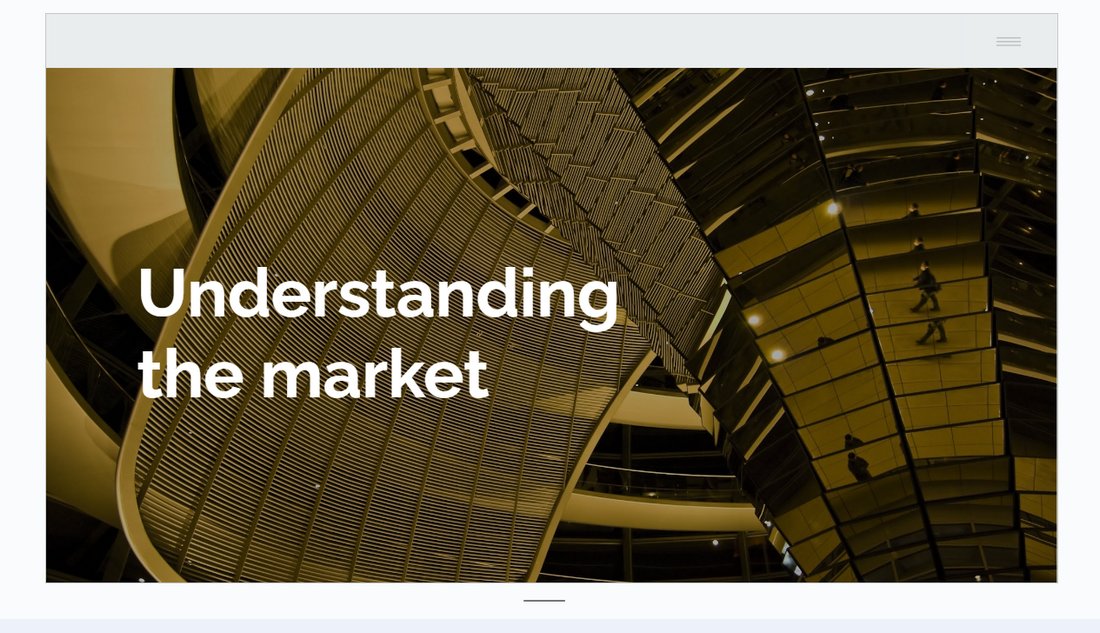
A picture is worth a thousand words! Always use images, graphics, icons, and charts whenever possible.
Incorporate Professional Images
Utilize high-resolution images to bring visual richness to your slides. Websites like Unsplash or Pixabay offer free, professional-grade images that can significantly enhance the impact of your presentation.
Smart Use of Graphics and Icons
Well-placed graphics and icons can make your slides more engaging and help break up text-heavy content. Use the “Insert” menu to add relevant shapes, diagrams, or icons. Be mindful to keep them complementary to your content and avoid overloading your slides.
Step 3: Playing with Colors and Fonts
Be careful when choosing colors. The presentation should represent your brand style as well as the topic you’re discussing.
Color Schemes
Colors can set the mood of your presentation and influence how your message is perceived. Choose a color scheme that is visually appealing yet maintains professionalism. Tools like Coolors or Adobe Color can assist in finding a harmonious and appealing palette.
Font Pairings
Fonts play a critical role in the legibility and aesthetics of your presentation. Pair a strong, distinctive font for headings with a more subdued, easily readable font for body text. Resources like Google Fonts can be invaluable for finding effective font pairings.
Step 4: Effective Use of Animations and Transitions
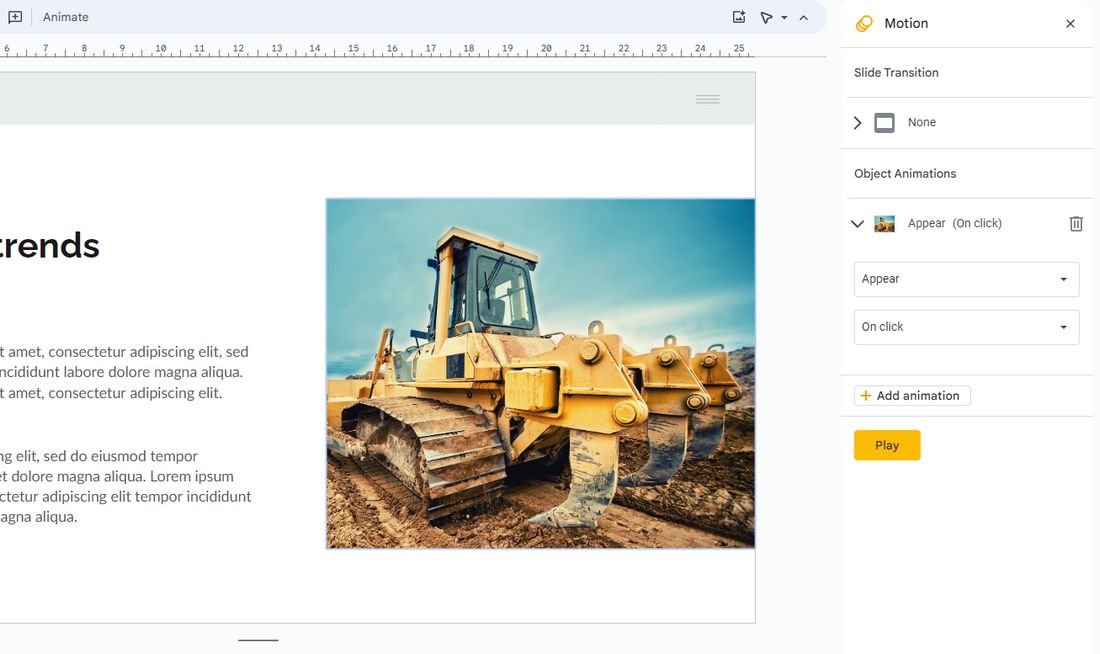
Animations in slideshows are important. But make sure not to go overboard with it.
Subtle Animations
Animations add dynamism to your presentation but should be used judiciously. Opt for simple, elegant animations like “Fade” or “Fly in” to introduce new elements or highlight key points, while avoiding overly complex or jarring animations that can distract from your message.
Thoughtful Transitions
Slide transitions should be smooth and consistent. Using the same transition style throughout your presentation can help maintain a professional and cohesive feel.
Step 5: Creating Custom Layouts
Don’t be afraid to customize the designs and create your own custom layouts.
Break the Mold
Standard layouts can be limiting. Experiment with custom layouts by creatively combining text, images, and graphics. This approach can make your slides more engaging and unique, helping to tell your story in an innovative way.
Balance Your Elements
While creativity is key, it’s important to keep your slides uncluttered. Strive for a balance between various elements, ensuring each has enough space and the slide doesn’t feel overcrowded.
Step 6: Adding Multimedia Elements
In addition to using images, try to add video and audio to your slideshow to make it more engaging.
Embed Videos and Audio
Including videos or audio clips can make your presentation more interactive and engaging. Use the “Insert” menu to embed multimedia elements that are relevant and add value to your content.

Interactive Elements
For a more engaging experience, consider adding interactive elements like hyperlinks, embedded surveys, or quizzes. These elements can be particularly effective in educational and corporate presentations.
Step 7: Utilizing Data Visualization

Numbers look great when they are accompanied by graphs and charts.
Include Charts and Graphs
Data visualization can help convey complex information in an easy-to-understand format. Use Google Slides’ built-in chart tools to incorporate graphs and charts that are visually appealing and relevant to your data.
Customizing Data Representation
Customize your charts and graphs to align with your presentation’s color scheme and style. This not only makes your data more coherent with the overall design but also enhances readability.
Best Practices for Cool Google Slides
Follow these best practices to make even cooler and professional slideshows.
1. Consistency is Key
Maintain a consistent use of colors, fonts, and design elements throughout your presentation. This consistency creates a professional and cohesive look.
2. Less is More
Adopt a minimalistic approach. Overuse of colors, fonts, or animations can be overwhelming. Less clutter means your content can shine more brightly.
3. Focus on Readability
Ensure your text is easy to read. Pay attention to font sizes, and ensure there’s a strong contrast between text and background colors.
4. Quality Over Quantity
Prioritize high-quality images and graphics. Low-resolution images can diminish the professional look of your slides.
5. Test Your Slides
Always preview your slides on different screens and in various lighting conditions to ensure they look good universally.
6. Keep Up with Trends
Stay updated on the latest design trends, but make sure your presentation style is appropriate for your message and audience.
7. Tailor for Your Audience
Customize your presentation to resonate with your specific audience. This might mean using industry-specific terminology, relevant cultural references, or appropriate humor.
8. Seek Feedback
Get feedback on your presentation from peers or colleagues. Fresh eyes can offer valuable insights and help identify areas that need improvement.
By incorporating these techniques and best practices, your Google Slides presentations will not only look cool but also be more engaging and effective. Remember, the key is to balance creativity with clarity and professionalism.
Whether you’re presenting complex data or a simple narrative, these tips will help you deliver your message in a visually compelling way.
How-To Geek
7 google slides features for eye-catching presentations.
Make a slideshow that stands out.
Quick Links
- Apply Image Effects
- Crop an Image to a Shape
- Place Text in Front of an Image
- Shorten Lengthy Videos
- Insert a Chart or Graph
- Position Slide Items With Guides
- Use Subtle Slide Transitions
Assembling a professional slideshow can be intimidating if you don't feel creative or artistic. But that doesn't mean you can't make an appealing and successful presentation. Google Slides provides features to help you design an attractive slideshow.
1. Apply Image Effects
You may have an image or two that could use a little pizzazz. Google Slides offers shadow and reflection features that may give your picture or photo just the right touch.
Related: How to Make an Image Transparent in Google Slides
Select your image and choose "Format Options" in the toolbar. When the sidebar opens, check the box for Drop Shadow or Reflection. Then, expand that section to adjust the transparency , distance, angle, or size.
This lets you take ordinary images up a notch.
2. Crop an Image to a Shape
Another way to make an image stand out is by cropping it to a shape . This is referred to as using a mask in Google Slides.
Select your image and click the Mask Image arrow attached to the Crop Image button in the toolbar. Move to Shapes, Arrows, Callouts, or Equation to see the available shapes in the pop-out menu.
Then simply click the shape you want to use. You'll see your image cropped to fit the shape.
To make additional adjustments to the image, select "Format Options" in the toolbar. You can change the size, rotation, position, brightness, or contrast.
3. Place Text in Front of an Image
For things like a title slide, section divider, or conclusion, you may want a unique look. You can place text in front of (or even behind) an image.
Related: How to Place Images Behind or in Front of Text in Google Slides
With your image and text on the slide, move the text box on top of the image. If the text displays behind the image, select the box and head to the Arrange tab.
Choose Order and pick either "Bring to Front" to place the text box on top of all slide elements or "Bring Forward" to place the text box one level up.
This lets you create a different look or save space, and it works well for welcome, transitional, or wrap-up slides.
4. Shorten Lengthy Videos
If you want to include a video in your slideshow but trim it to only show a certain part of the clip, you can do so right in Google Slides.
Select your video and click "Format Options" in the toolbar. When the sidebar opens, expand Video Playback.
If you have the exact times you want to use, enter those in the Start At and End At boxes. You'll then only see that part of the video when you play it in the presentation.
If you aren't certain of the times, press Play in the preview of the video in the sidebar. When you reach the spot where you want to start the video, pause the playback and click "Use Current Time" below the Start At box. Then, do the same for the end time to the right.
You can then play the video on your slide to make sure you've got the timing correct or adjust it further in the sidebar. Optionally, you can check the box for Mute Audio if needed.
Related: How to Add Videos and Customize Playback in Google Slides
5. Insert a Chart or Graph
Slideshows are all about visuals. So, if you have data you want to present, using a chart or graph is a good way to do it. If you have a chart in Google Sheets you want to use, you can simply insert it. Alternatively, you can create a graph from scratch.
Select the slide where you want the chart. Go to Insert > Chart and choose a chart type to create one or "From Sheets" to import one.
If you make your own graph, you'll see sample data when you insert the chart. Use the arrow on the top right to pick "Open Source."
Google Sheets will open with the sample data in a new tab. Then just add your own data.
Return to the Google Slides tab and update the chart using the Update button. You'll then see your updated visual.
From there, you can do things like resize the chart to add some text or a title or apply a border. For a full tutorial on creating a chart in Google Slides , check out our how-to.
Related: How to Create a Graph in Google Slides
6. Position Slide Items With Guides
To make sure that your images, videos, text, shapes, and other items are placed neatly on the slide, you can use the built-in guides.
Go to View, move to Guides, and pick "Show Guides." You'll see horizontal and vertical lines appear which help you to line up your items perfectly.
To make aligning items to the guides even better, you can add a snap. Head back to View, move to Snap To, and pick "Guides."
Once you enable the second feature, you'll see red horizontal and vertical lines appear as you drag your item on the slide. You can then release the item once it's lined up with those indicators.
For additional details on using guides in Google Slides , take a look at our tutorial.
Related: How to Use Guides to Position Items in Google Slides
7. Use Subtle Slide Transitions
Rather than a sudden jolt from slide to slide, consider using subtle slide transitions. You can apply a fade, dissolve, or other effect for a nicer transition from one slide to the next .
Select a slide to start with; you can easily apply the transition to all slides later. Click "Transition" in the toolbar. When the sidebar opens, expand the section below Slide Transition.
Use the drop-down box to choose an effect. You'll see dissolve, fade, slide, flip, and more.
After you pick an effect, press "Play" at the bottom of the sidebar to see a preview. You can also adjust the speed of the transition using the slider.
To use the transition throughout your presentation, click "Apply to All Slides." When you finish, simply close the sidebar. When you play your slideshow, you'll see that attractive transition between slides.
With tools for sprucing up images , removing unnecessary video content, and replacing data with visuals, consider these Google Slides features for your next presentation.
20 Google Slides Tutorials To Master Your Presentation Skills
- Share on Facebook
- Share on Twitter
By Nikolay Kaloyanov
in How-To Tutorials
2 years ago
Viewed 1,467 times
Spread the word about this article:
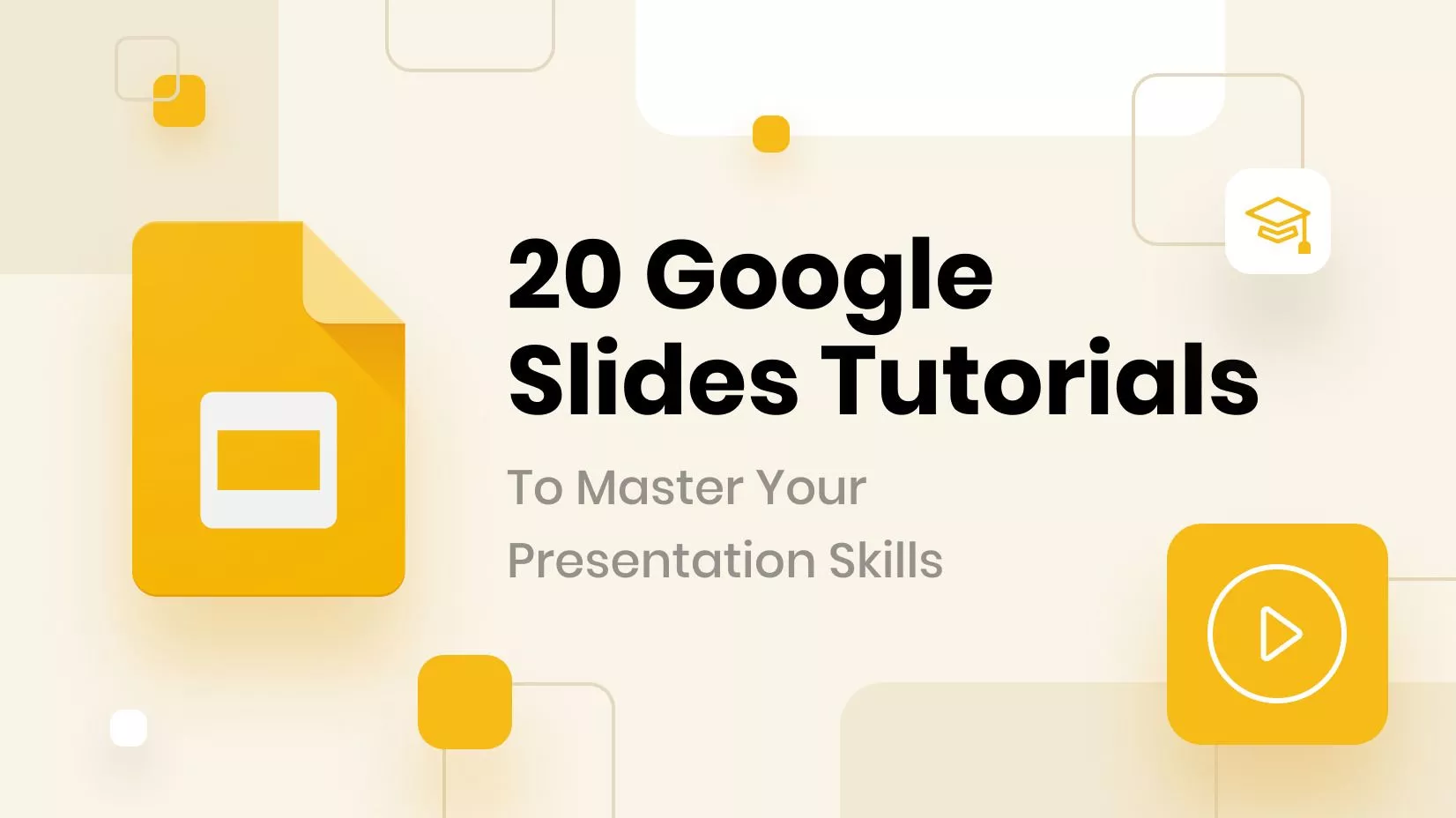
Learning how to work with Google Slides and master the popular presentation software won’t be in vain. Many people know what Google Slides is and are taking good advantage of it.
Both students and teachers can use it for free , and on top of that, many business professionals can also implement it in their work free of charge, thus making it a valuable presentation software.
In this article, we will provide you with some beginner and some advanced Google Slides tutorials that you can utilize for your needs. In the end, you will know how to use all the features in Google Slides and speed up your workflow .
1. Getting started – Complete beginner tutorial
This is an amazing Google Slide tutorial that has more than 20 subtopics. You will learn how to create a Google account, start your first presentation, and do a whole lot of other things.
We usually start our articles with big video tutorials, as you can see how to achieve everything. Still, it’d be best that you have a separate tutorial for each action you need, as compressed tutorials are always straight-to-the-point and don’t add many examples.
2. How to create a Google Slides presentation?
Creating a Google Slides presentation from scratch is an important first step in being successful with your project. It’s critical to have a Google Account first, so make sure you have one before you start.
In this beginner Google Slides tutorial, you will see how to create a new presentation, add a theme, and see how to share your Google Slides presentation with others.
3. How to add images to Google Slides?
Images are a crucial part of any design, so it’s not a coincidence that Google Slides offers not one but six ways to add them, and all of them have their benefits.
In this Google Slides tutorial, you will learn how to add images and then modify them to fit your presentations the best way possible. Another thing we liked is how you can use shapes and embed the images into them, to get a special “vibe”.
4. How to add a video to Google Slides?
Videos are a crucial element of presentations today. Why? Because they convert! Statistics show that video is the leading source of web content, with 82% attribution .
In this tutorial for Google Slides, you will learn how to embed a video, trim it, and customize it to fit your presentation agenda.
5. How to add fonts in Google Slides?
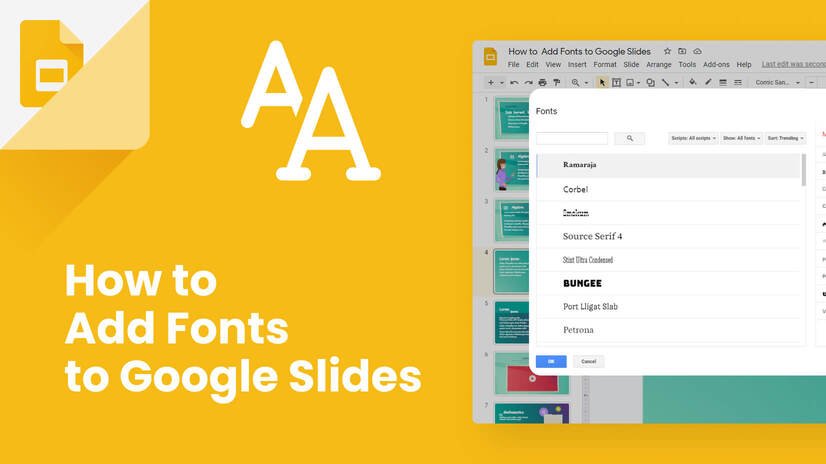
Learning how to add fonts to Google Slides is crucial for your presentation. It can give you an extra bit of creativity but could also make the difference if you want to add more branding.
In our Google Slides tutorial, you will see in which case it’s a good idea to add fonts, how to use fonts properly, and how to change and add fonts from the selection. The steps on the guide are “served” with image guidelines for easier navigation.
6. How to add charts to Google Slides?
If you want to sound more professional in your presentation, then talking the talk won’t be enough. Adding charts to your Google Slides presentation will make it more credible and useful.
In this Google Slides tutorial, you will learn how to create a chart from scratch, or import a chart from Google Sheets. You will also see how to stretch the chart and modify the data inside.
7. How to create a flyer on Google Slides?
A friend of mine (a teacher) asked me if he could do something more than a standard presentation on Google Slides. And my reply consisted of a single video – this one.
While this is an advanced Google Slides tutorial, you can clearly see how you can optimize all the resources available for something much different than a normal presentation. All you need to do is make your slides vertical and show some imagination.
8. How to insert an Animated GIF into Google Slides?
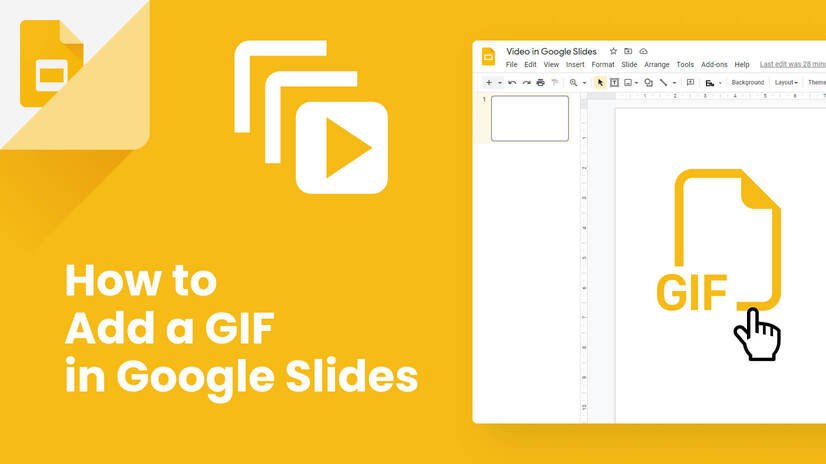
Adding GIFs to your Google Slides presentations will add a lot of value to them. More importantly, you will keep your audience’s attention for longer which is crucial
In our tutorial, we will show you why and how you should add GIFs to your Google Slides presentations. During the guide, we will also show you when it’s appropriate to use GIFs and some good places where you can find resources.
9. How to insert infographics in Google Slides?
Infographics are a great way to showcase your skills. Fortunately, there’s no need to reinvent the wheel, as there are plenty of free infographic templates out there.
In this Google Slides tutorial for teachers, you will learn how to add your infographics and customize them. It is important to align them with the theme and tone of your presentation.
10. How to print a Google Slides presentation?
Sometimes, you need to print your Google Slides presentation if it contains a lot of details that your audience should have available in front of them.
In this Google Slides tutorial, you will quickly see how to print your presentation and ensure you won’t leave your audience guessing.
11. How to add speaker notes in Google Slides?
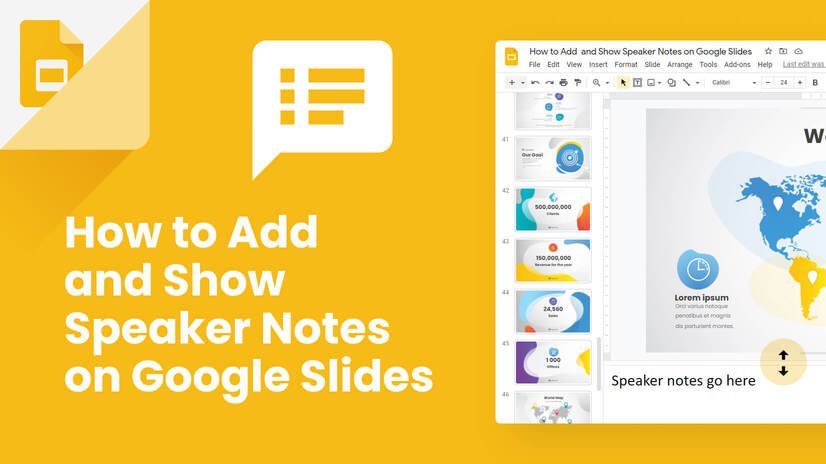
You can’t be a good presenter without knowing how to add speaker notes . They bring a lot of value to your confidence, as you will easily remember what you’re about to say in each slide.
In the article, you will first see the reason why speaker notes are crucial for you. Then, we will move forward to the next part – adding them. The third part of the article will go through the way you display them, and last but not least – we will show you a couple of free tips on how to write your speaker notes.
12. How to add a hanging indent in Google Slides?
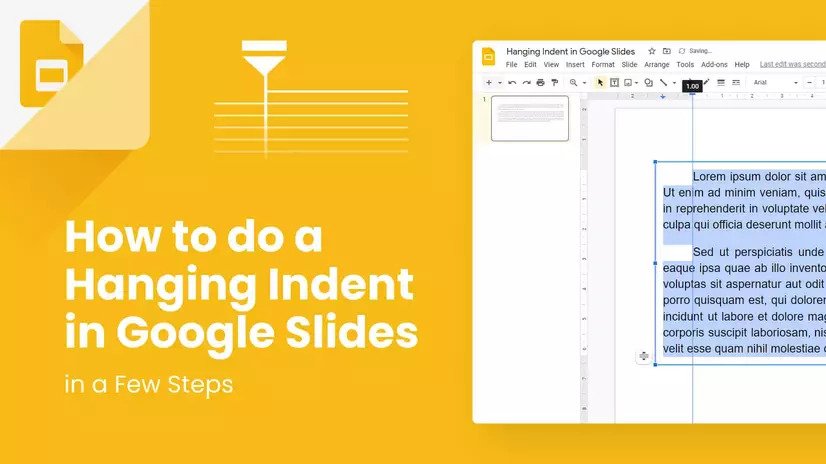
Learning how to add a hanging indent is crucial in academic environments. Knowledge of APA and MLA citation styles shows that you have done enough resources to know how to use someone else’s information and credit them when due.
Our article is a detailed Google Slides tutorial with plenty of images and instructions on how to move the ruler, in order to fully customize it according to the best practices in each citation standard.
13. How to make a radial chart in Google Slides?
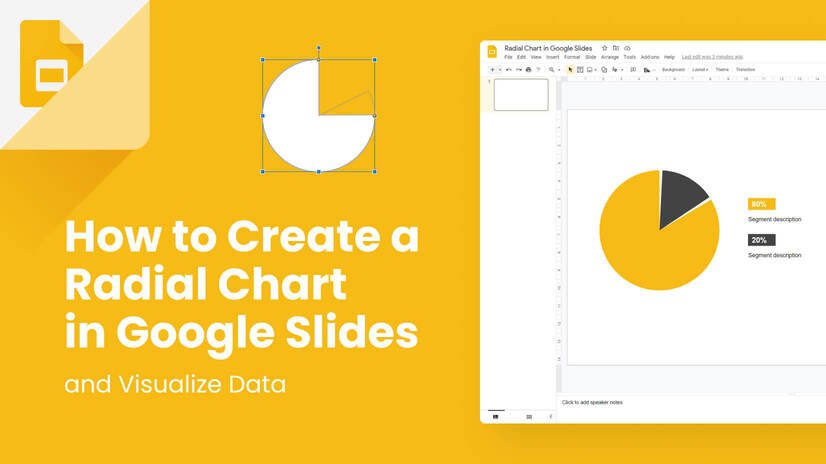
Data visualization is critical for the success of any presentation. People love to see images, instead of large text batches. Audiences remember data much faster if presented in a visual way.
Learning how to make a radial chart in Google Slides will help you present data in a more “digestible” way, thus conveying your message better. In the article, you will learn why people create radial charts and see a step-by-step guide with images of each step, in order to not miss a detail.
14. How to group/ungroup elements in Google Slides?
Grouping elements have been a common thing in design platforms like Illustrator and Figma but it is certainly a novelty in Google Slides.
Well, in this Google Slides guide you will learn how to group and ungroup elements in just under a minute. However, this could save you valuable time, especially if you plan to merge different elements – like icons and images.
15. How to create a timeline in Google Slides?
Timelines are the perfect tools if you have a presentation in which you explain chronological events – for example, company annual growth between Q1-Q4, or so. Luckily, Google Slides offers you an option to insert a timeline but you can also many Google Slides templates .
This Google Slides tutorial shows you how to create a timeline chart from scratch, and then add interesting details. What we loved here is the idea of creating catchy messages.
16. How to design a concept map in Google Slides?
Concept maps are perfect when it comes to displaying relationships between different ideas. In order for your audience to understand the main topic, you can break it down in to subtopics and explain how they are related to each other.
In this video tutorial, you will see exactly how you can create a concept map in Google Slides. Of course, if you don’t want to bother creating something from scratch, you can always check out some templates.
17. Google Slides transitions & animations: Complete guide
Transitions and animations are a significant part of Google Slides. You can add extra depth to your slides, provided that you don’t “overanimate”.
This Google Slides tutorial shows you where to access animations & transitions, and how to do them correctly. What we loved about the guide is that it shows you in real-time what is the “after effect”.
18. Create a professional business card on Google Slides
We all know graphic design apps and we’re not going to lie – they are a better fit for business cards. But are they free? I doubt so. With Google Slides, you can create a business card free of charge.
What we love in this advanced Google Slides tutorial is how detailed each step is. For just under 15 minutes, you can create your first (or next) business card, and then print it, if you like.
19. How to make a social media post in Google Slides?
If you’re a marketing agency, you will probably laugh at the idea of using Google Slides ahead of Illustrator , CorelDRAW, Photoshop , etc. But that’s not the case with small businesses that don’t have large budgets.
Is this the case with you? Then, this Google Slides video tutorial is for you. You will see how to create social media graphics utilizing stock images and the large font selection available from Google.
20. Edit images in Google Slides: Complete tutorial
We have already shown you how to add images in Google Slides. However, there is a way to actually edit them semi-professionally.
This Google Slides tutorial will show you how to add and then process an image in Google Slides. And that’s not all – it’s done by a professional designer who will also show you how to use text and add it as part of the image!
Google Slides is an app that can do a lot of things. While you might consider it as an online presentation software, it can achieve a lot more things.
If you found this article helpful, you can also check some of our other content:
- How to Convert Your PowerPoint Presentation into Google Slides
- How to Make Google Slides Look Good And Add a Touch of Finesse?

Add some character to your visuals
Cartoon Characters, Design Bundles, Illustrations, Backgrounds and more...
Like us on Facebook
Subscribe to our newsletter
Be the first to know what’s new in the world of graphic design and illustrations.
- [email protected]
Browse High Quality Vector Graphics
E.g.: businessman, lion, girl…
Related Articles
How to do a hanging indent in google slides in a few steps, how to create table of contents in powerpoint: ultimate guide, character animator tutorials part 1: introduction, 11 seo and keyword tips for your best google ranking, how to convert pdf to powerpoint [easy guide], 500+ free and paid infographic templates compatible with google slides:, enjoyed this article.
Don’t forget to share!
- Comments (0)
Nikolay Kaloyanov
Nikolay is a copywriter with vast experience in Technology, Marketing, and Design. When he isn't playing with words and crafting texts, he watches sports and asks questions. He is a funny person...until you put him on a diet.

Thousands of vector graphics for your projects.
Hey! You made it all the way to the bottom!
Here are some other articles we think you may like:

How-To Tutorials
How to create an online course in 7 simple steps.
by Lyudmil Enchev
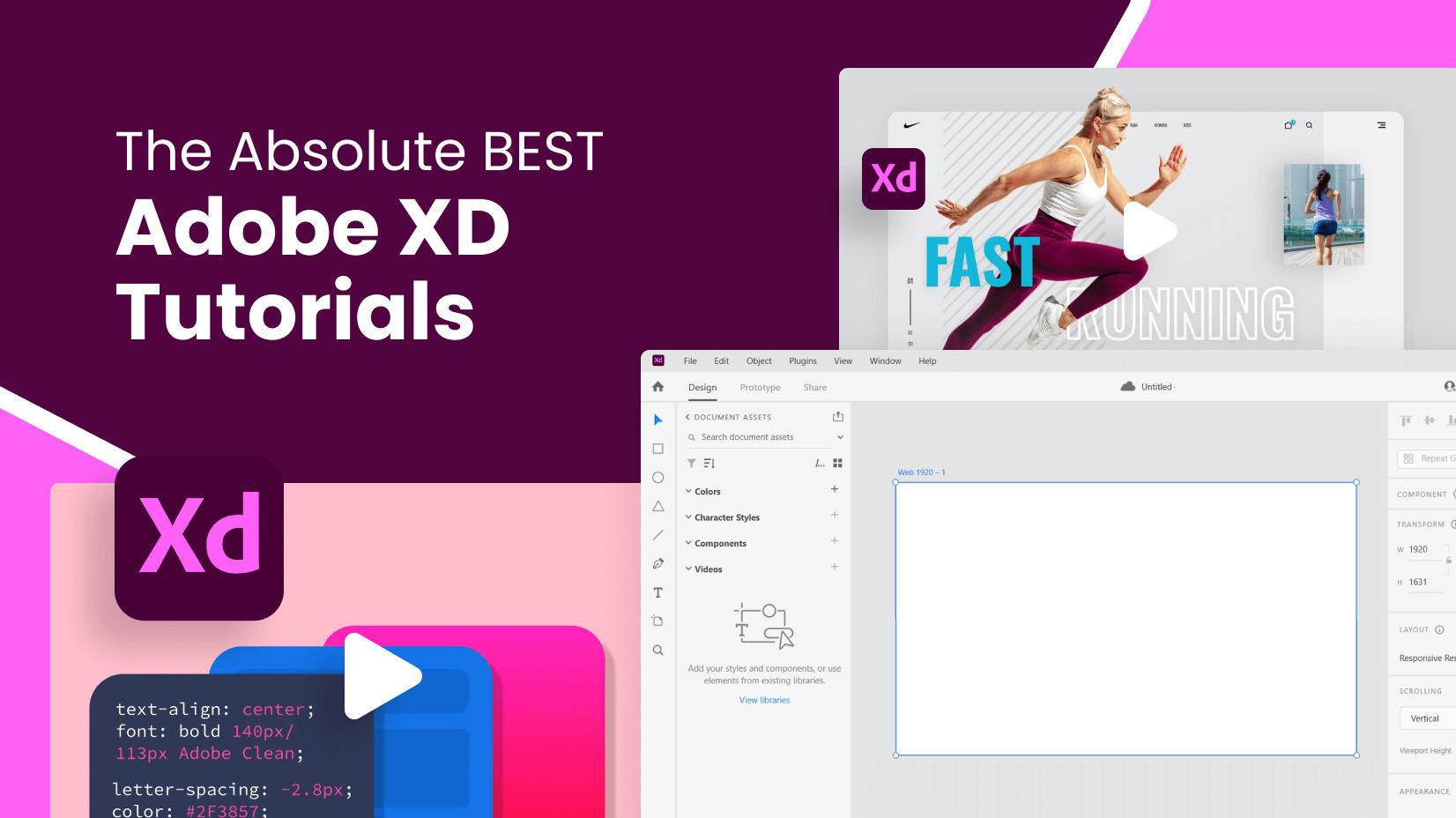
The 25 Absolute BEST Adobe XD Tutorials In 2022
by Nikolay Kaloyanov
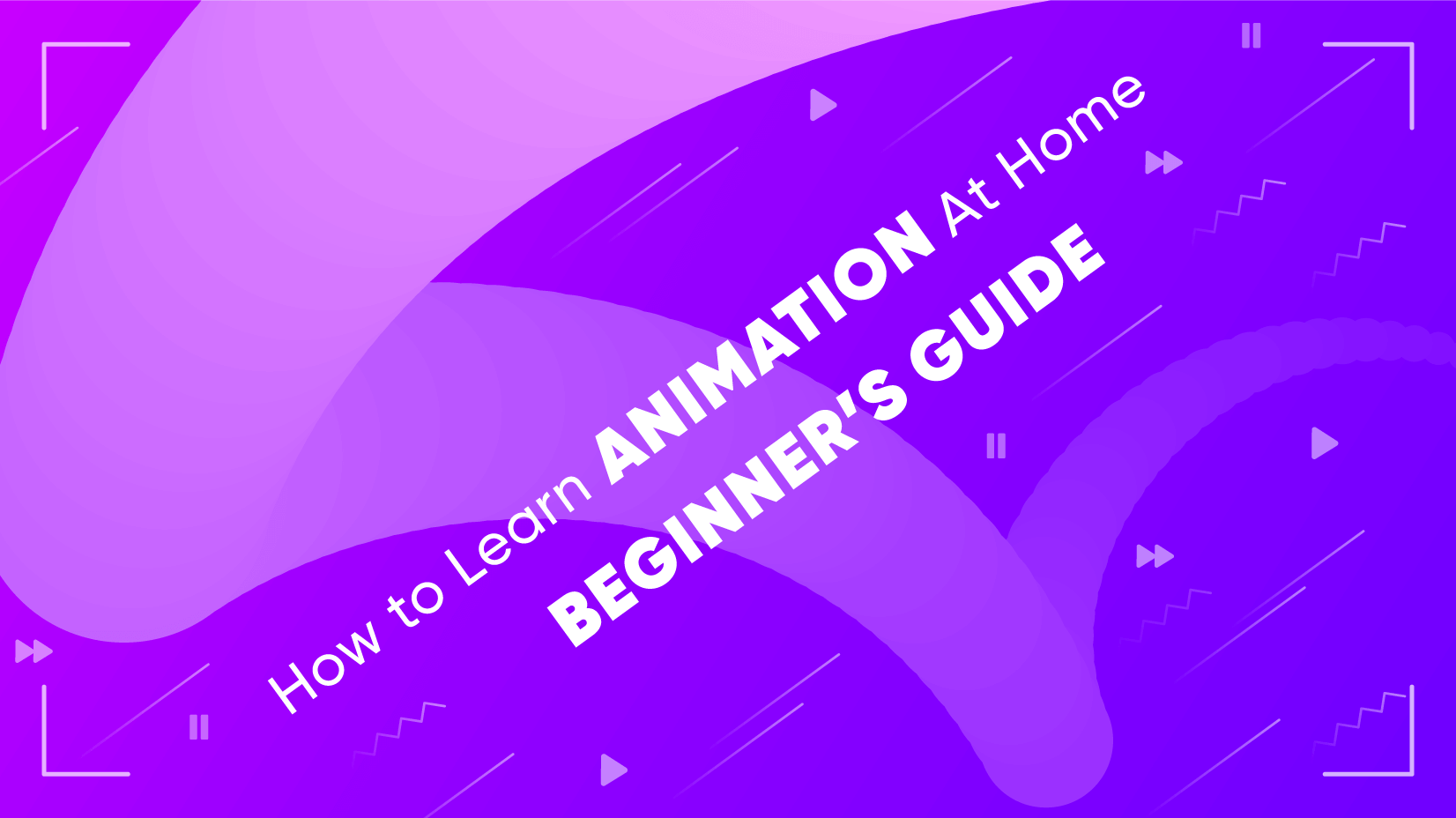
How to Learn Animation At Home: Beginner’s Guide to Online Courses, Software and Resources
by Al Boicheva
Looking for Design Bundles or Cartoon Characters?
A source of high-quality vector graphics offering a huge variety of premade character designs, graphic design bundles, Adobe Character Animator puppets, and more.
Google Workspace
Present like a pro: new updates in Slides designed to make you look good
Sep 27, 2017
[[read-time]] min read

As a go-to presentation tool, Google Slides already comes equipped with real-time collaboration features. Starting today, we’re introducing new robust features to help you and your team win that pitch, nail that client presentation and get buy-in for new ideas—all while saving valuable time.
Here’s a look at the latest updates in Slides, including new G Suite integrations, partner applications and customization options.
Capture ideas in Keep, bring them to life in Slides
We built Keep to help you easily capture and organize ideas. Today, you can use a new drag-and-drop integration between Keep and Slides to transform these ideas into action. Simply select notes from Keep (or sort with #labels ) and drag them into Slides. When you add a note from Keep into your presentation, Slides will automatically add a title and description for you.
The Office of Information Technology for the State of Colorado uses the new Keep and Slides integration to keep track of population numbers at different agencies and report them to their team. Instead of digging through emails and Docs to track down figures, the team saves statistics to Keep and drags them into Slides to present.
If you’re new to Keep, download here .
Skip manual updates, use linked Slides
Whether you’re trying to prepare several client presentations or make sure data is up to date, repeatedly copying slides from one presentation to another is a major time-sink. Now, you can link and sync slides from multiple presentations with a click. This way, you can maintain a single source of truth and easily update linked slides to match the source, like for quarterly business reviews or company presentations.
Sriram Iyer, Senior Director of Product Management at Salesforce Sales Cloud, is excited to use the new slide embedding feature to streamline his teams workflows. Says Iyer, “At Salesforce, we use Google Slides for customer-facing and internal presentations. The linked slides feature will help us easily keep presentations up-to-date.”
You asked, we updated
Our customers also asked for additional features in Slides. We listened to those requests and now you can:
- Insert Diagrams , or ready-to-use visualizations. This is great for when you need to effectively share timelines, processes or hierarchies.
- Select Grid view to view all your slides at once as thumbnails. This helps you easily reorder or change formats of multiple slides.
- Tailor presentations to different audiences with the Skip slide feature. You can now choose to skip select slides without fully deleting them when you present from your phone or laptop.
Try these feature upgrades and create better presentations.
Try new add-ons, shape up your Slides
We’re constantly improving Slides to provide you with robust tools to share ideas. Today, we’re bringing add-ons to Slides. To kick it off, we’re introducing seven integrations—designed to bring expertise from companies like Adobe and Shutterstock—right in Slides.
Use these new, rich integrations to help you build more powerful presentations, whether you want to add full-bleed images, use advanced image editing tools or include diagrams you created in programs outside of G Suite.
- Search for and add images from Adobe Stock , right in Slides. You can use the Adobe Stock add-on to build visually-stunning presentations in Slides. Teams can seamlessly search, preview and purchase Adobe Stock images—without leaving Slides. Through the add-on, teams can also use Adobe Stock Visual Search to find relevant stock images with an uploaded image (versus a text search).

- Use the Shutterstock Editor add-on to add and customize photos within Slides. With the Shutterstock add-on , teams can browse Shutterstock’s entire library of royalty-free images, and sign into Shutterstock to license content, directly in Slides. Select an image, then apply customization options like filters, text, logos and more.

Teams can benefit from even more powerful capabilities in Slides with additional add-ons from Balsamiq , Lucidchart , Pear Deck , Noun Project and Unsplash . Tap “Add-ons” in the Slides menu bar to get started.
Customize Slides, automate workflows with Apps Script
Apps Script, the same technology that powers add-ons, can transform the way you work. Apps Script for Slides lets your teams programmatically create and modify Slides, and customize the menus, dialog boxes and sidebars in the user interface.
So, what’s the big deal? Apps Script provides amazing possibilities for improving your team’s workflows. Sales teams can use Apps Script to automatically pull in information from Sheets’ databases to create customized client pitch decks and templates. Marketing teams can host internal assets in a customized sidebar in Slides for easy access to logos and files they use most often.
To learn more about how you can automate your workflows using Apps Script, check out this post .
Present with confidence using Slides —these updates start rolling out to all customers globally on the web today.
Related stories
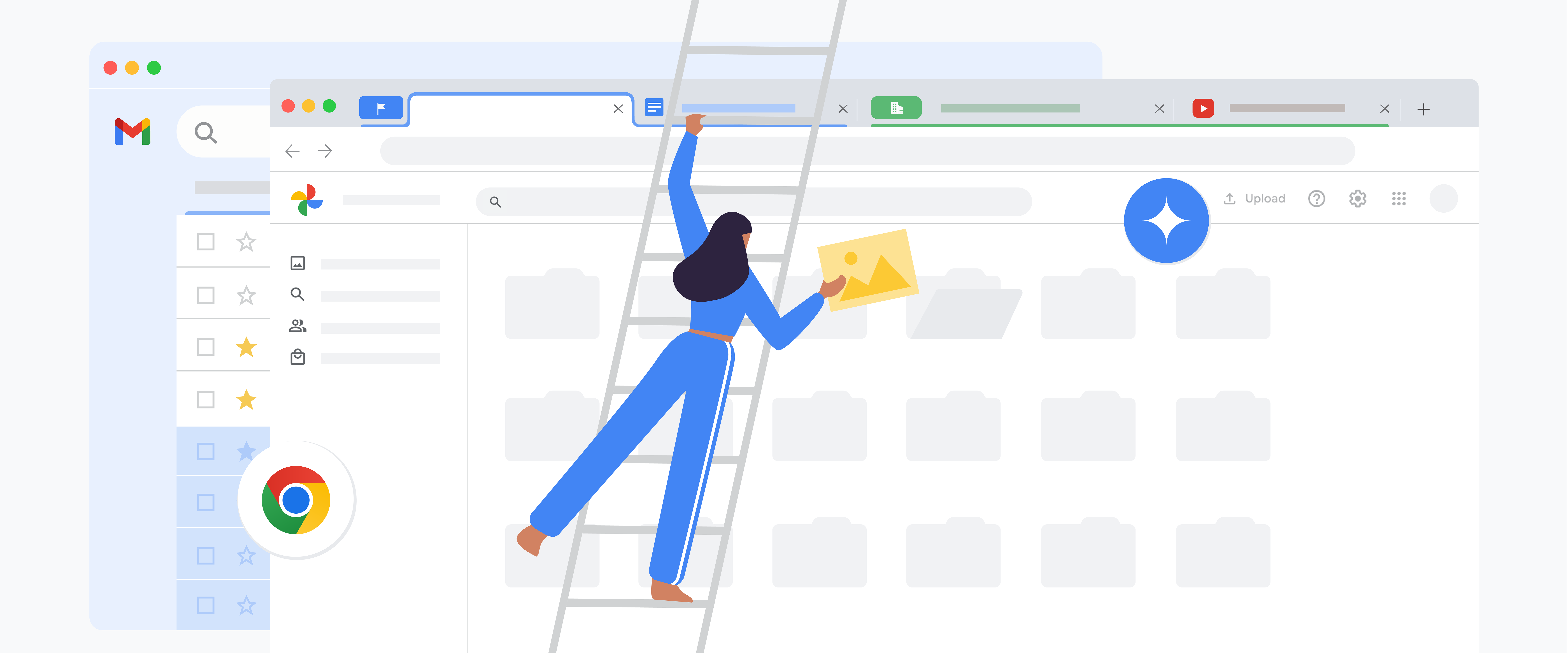
5 AI tools to help organize your digital life
Boost your productivity: use gemini in gmail, docs and more with the new google one plan.
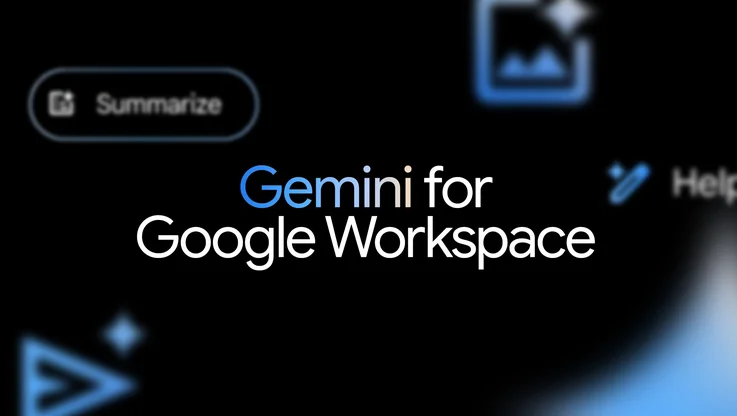
New ways Google Workspace customers can use Gemini

5 ways Google for Education helps teachers and students stay safer online
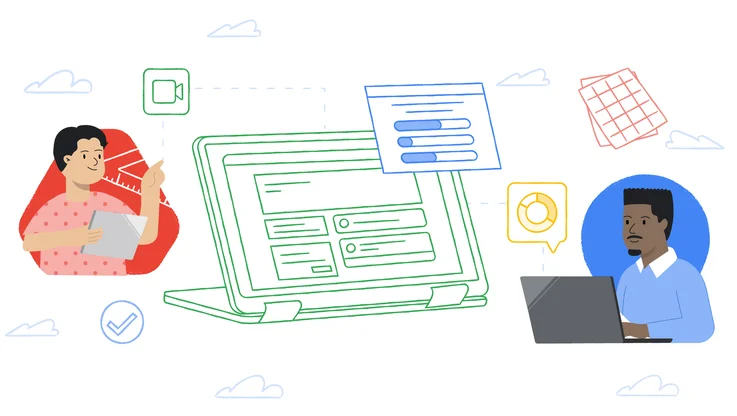
New education features to help teachers save time and support students
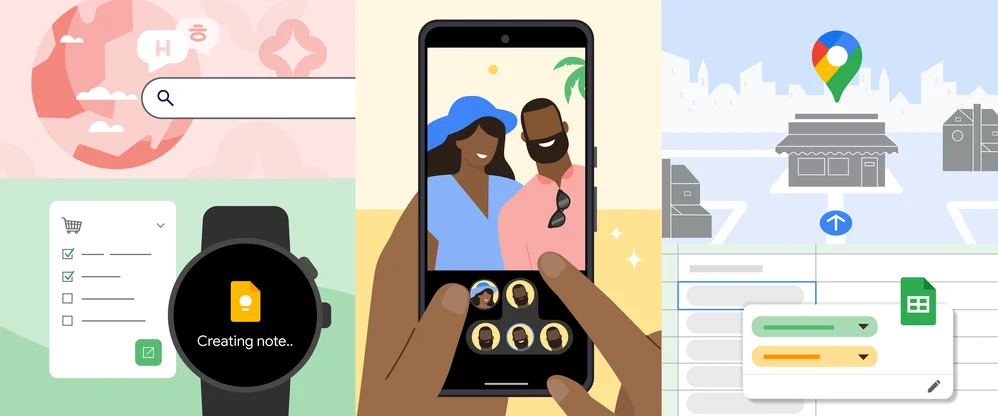
23 of our most helpful tips from 2023
Let’s stay in touch. Get the latest news from Google in your inbox.
Enterprise Digital Signage Software since 2005
Enterprise Digital Signage Software Since 2005
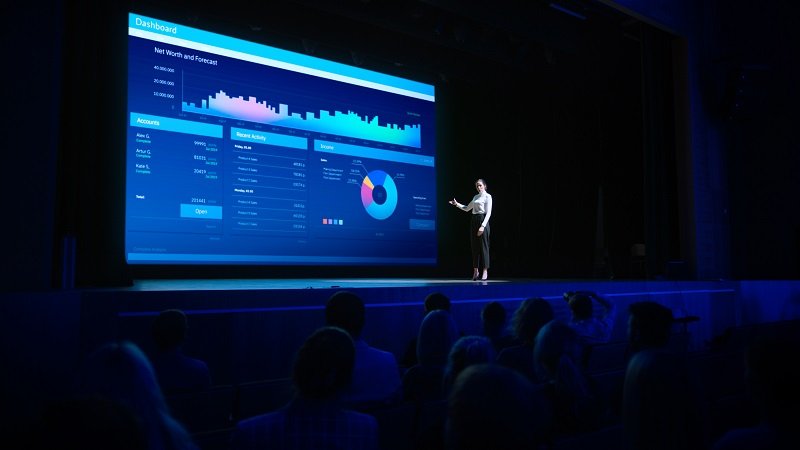
Google Slides Tips for a Presentation That Stands Out
Over time, Google slides have emerged as a favorite for many intending to design and deliver presentations. The tool features real-time collaboration features , cloud-friendly, intuitive design templates, and easy to use. However, like any other software, users should overcome some learning curve before using this tool expertly. That said, check out the guide below to learn more about Google slides presentations.
What is Google Slides?
Google slides are among the many professional office tools provided by Google. This excellent free software suits everyone, including small business owners, students, educators, and public speakers, looking to make professional presentations. Since it is a free tool, it suits anyone who don’t want to spend money or those who don’t regularly give presentations and thus don’t see the need to purchase paid presentation software.
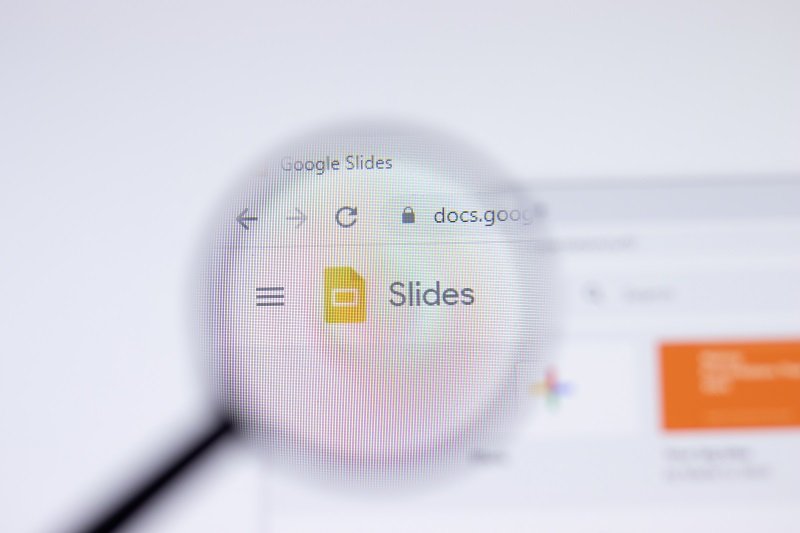
Being among the Google Docs tools, anyone with a Google account can create it. Similarly, like other tools from Google, the strength of Google slides is its collaboration ability. Anyone with an internet connection can access Google slides Presentation from their laptops or iOS, and Android mobile devices using the Google slides app.
How do you make a Presentation in Google Slides?
Creating a Google slides presentation is very easy. Follow the these steps;
1. Plan the presentation
Planning is very crucial in ensuring that your Google slides presentation is straightforward and professional. Unfortunately, most people skip this step. Planning should comprise an in-depth outline of the presentation’s goal, type of audience, and content to be delivered. Narrow the topic and eliminate any unnecessary information.
2. Download Google Slides Presentation template
The design of your presentation is as important as the information presented. Your audience can quickly dismiss a badly designed slideshow. If you are well-versed with designs, you can create one from scratch. However, if you aren’t an expert, download already created templates .
3. Create a New Presentation
Creating a new Google slides presentation is easy. Simply open your Google Drive, click on New tab in the upper left corner and click the “Google Slides” option from the toolbar menu. If you are using a pre-designed template,. There are many sites that offer Google slides templates. Some are free and some are paid sites for Google Slides templates . Which ever you chose, you should upload it to Google Drive You can use the mouse or arrow keys. With the new presentation created, you can then apply a theme and add content. If you already have existing content in PowerPoint, simply import the content into Google slides.
4. Insert Text and Images
Inserting text and images to Google slides Presentation is very simple. Obviously, both the text and images should relate to the topic of discussion. Fortunately, finding and adding graphic images to presentations is very easy. You can upload from your files, search online, or camera photos. You can also add audio and video files from various resources if necessary.
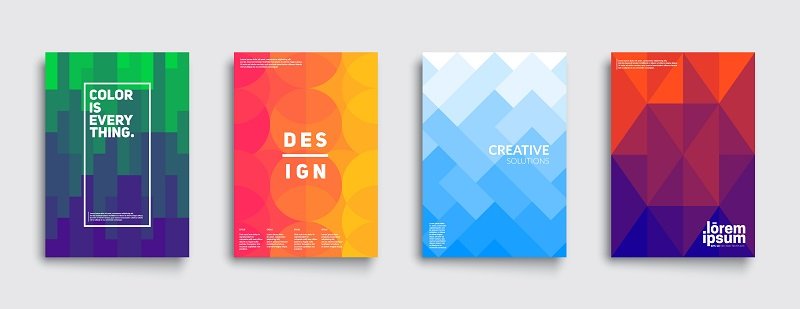
5. Finish up
With all the contents included, your Google slides presentation is ready. However, you should curate the presentation to appear professional. For instance, if you intend to publish it online, consider setting it to play by default upon opening. You can do this with the auto-play option. You can also change the appearance of your slides, introduce loop, and choose from several available themes. Don’t forget to save your presentation once done.
What are the Components of a Presentation?
All professionally prepared Google slides presentations typically consist of six components. The elements include;
- Clear objective – ensure that you achieve your goal of the presentation. The objective should guide everything in the content.
- Usefulness to the audience – your presentation should offer valuable insights to your audience.
- Well-rehearsed – you should practice before going in front of your audience. Practicing helps to build confidence and identifying key points in the presentation.
- Minimal text – your slides should contain a few sentences. A cluttered presentation is very unprofessional.
- Clearly featured contact information – include your email address, logo, social media handles, and number in the last slide if one of your audience wants to reach you.
- A clear call to action – this describes what you want your audience to do after the presentation.
How to Download Google Slides Presentation
Downloading your Google slides presentation from Google sheets is not complicated. From your Google Documents, open the slides option and the document you want to download. From the top drop-down menu bar, click on File, and then Download. Note that you can download the presentation in several forms. Once you click on Download, you can choose your preferred export format.
How to Make a Google Slides Presentation Look Good
A well-prepared slide show presentation not only looks professional but also makes it easy to communicate ideas and boosts confidence. Fortunately, Google slides has several features that make it easy to create compelling presentations . Use the following tips to make your slides look good;
- Use professional Google slide themes .
- Be creative with fonts and drop shadow effects in your text.
- Change image shapes with shape masks.
- Add subtle animations.
- Make the texts to pop off from images and other add-ons.
Can you Record a Google Slides Presentation?
With the rise of YouTube videos and other video sharing platforms, you should learn how to record Google deck presentations. Fortunately, you can record Google slides presentations. For this, you can use several tools, including Screencast-o-Matic and Panopto. Both tools feature video editing tools that make it easy to curate your recorded videos.
How to Use Google Slides Presentations on Digital Signage Displays
Did you know you can use Google slides on digital signage displays? Displaying your Google slides presentation on any screen beside you is possible using several applications. With regard to digital signage apps, the easiest option is natively uploading the presentation as PowerPoint, PDF, or Keynote files. For example, Mvix has an app called G Suite , where you can upload any google document from.
You can also use the Google slides app, which provides more innovative features, or the Microsoft Power Bi app . Regardless of your option of choice, turning your presentation into digital signage makes it easy to get your slides live on digital screens.
Bottom Line
Like Microsoft PowerPoint file, Google slides allows users to create presentations as slides using both texts and images. It is a strong presentation tool with many valuable features and collaborative abilities, as users can chat and comment freely. However, how the information is presented is equally important as the creation of the document. Therefore, you shouldn’t solely focus on creating a professional Google slides presentation. The slide decks contain a fraction of the content, which should be supplemented by the presenter.
- Google Slides
- Google Slides for Digital Signage
- Google Slides Templates
- Google Slides Theme
Related articles

How to Build Effective Wayfinding Systems

The Impact of AI on Content Design
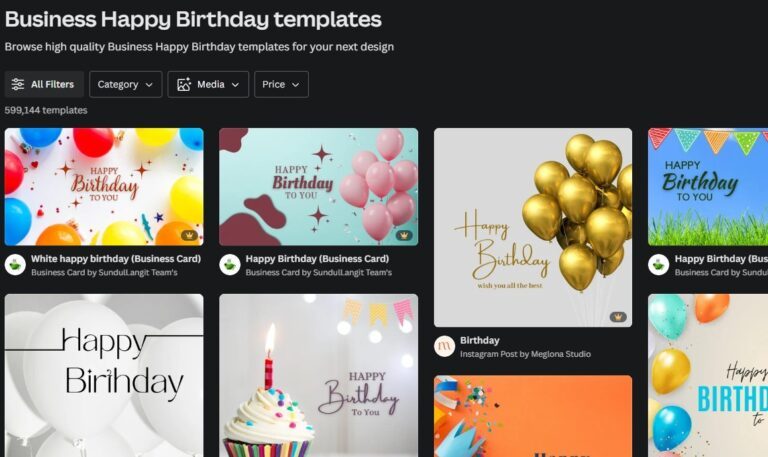
Top 5 Features of Canva
Ready to get started?
Are you exploring your digital signage project needs (hardware, software and content)? Looking for just the digital signage display software or a full-scope proposal? Would you like you a personalized software demo?
Starting at
One time cost
- Perpetual Licenses
- Includes Media Player
- Unlimited cloud storage
Have a project in mind?
Get a Quote
Let’s discuss your project and we’ll put together a customized, line-itemized estimate and proposal.
Let's Connect
- First Name *
- Last Name *
- Phone Number *
- How can we help you?
- Home Address
- Comments This field is for validation purposes and should be left unchanged.
Ask Us About:
- A personalized demo to see how Mvix CMS integrates with your content for more effective communication
- Getting a customized quote for digital signage players, software, or services
- Lifetime Warranties via Signature Care & Implementation Assistance
To discuss your project, call: 866.310.4923
Looking for technical support? Open a support ticket
October 25, 2023
How to make Google Slides that look good
Six simple rules to make your presentations more visually appealing. Start applying these design principles to your presentations and make beautiful slide decks
.png)
Co-founder, Head of Product
Creating great presentations can be a daunting job — you can’t just be a good writer, you also need to make visually pleasing slides. Designing a presentation involves hundreds of design decisions — like structuring the content, laying it out on a page (should you use columns? rows? bullets?), choosing typefaces (there are so many fonts!) and font styles, to selecting colors and adding graphics. Unless you’re a professional slide designer, you’ve probably wasted hours struggling with these decisions.
If you want to make visually appealing, cool-looking, or aesthetic Google Slides but don’t know where to start, then this guide is for you.
Always start with content, not visual design.
Before we get into it, let’s start with the cardinal rule of presentation-making .
The single biggest mistake we see all the time is people who try to “design” slides before having a clear idea of what they want the presentation to say . You should align visual design to content structure, not the other way around.
We strongly recommend that you start by mapping out your content . Start with an outline that will force you to clarify the goals and shape of your presentation and hone in on your key messages. Don’t worry about writing all of the copy on the page yet, but try to get to a list of slide titles.
Consider the following:
- Who’s the audience? (What should be the voice and tone?)
- What are the three key takeaways for the presentation?
- Are people going to be reading the slides or is someone going to be talking over it? (How dense should the slide content be? How many slides do you need?)
- Will it be projected on a screen or will people look at it on their phones (in which case you might want to use a vertical layout )?
You don’t have to design slides from scratch.
Staring at a blank presentation can be daunting and paralyzing — after all, you have to figure out both your content structure and design your slides. Here are some alternatives to getting started.
Use a template
The easiest way to make beautiful Google Slides is to use a premade template. Instead of trying to master slide design yourself, leverage the work that other designers have already put in.
How should you choose a template? You can choose a template either based on the presentation content you need or based on its visual design. If you already have a content structure in mind (because you followed the first step of this guide!), then you can actually choose from a wider set of presentation templates. Just look for the visual style and content layouts that fit your need.
.png)
Check out the Plus template library for Google Slides — they’re totally free to use.
Use Plus AI
Plus AI gives you the best of both worlds of starting from scratch and from a template. Plus can generate an outline for you from any prompt, so you don’t need to stare at a blank sheet of paper (or screen) or be constrained by the exact structure in an off the shelf template.
The slides that Plus AI generates are clean and professional, including a wide variety of slide layouts that you can further customize and tweak. You can also apply custom themes to customize the look and feel even further.
6 design rules for making visually appealing slides
Even if you use a template or a tool like Plus AI, it is still useful to understand the principles of slide design, so you have more freedom to edit and play with your content structure. You don’t need to become a typography expert or master color theory, just follow these basic principles to quickly up-level your slide designs.
1. Page layout is your first priority
It doesn’t matter how aesthetic your color palette is or how harmonious your typeface choices are, if content is not well laid out on your page.
- Check your slide margins and spacing across your slides.
- Zoom out and look at them in a grid view, which will help you spot issues.
- If you have repeating elements on a page (e.g., 3 columns of text), make sure they are aligned and evenly spaced. Use an imaginary grid to layout your content.
.png)
2. Establish clear information hierarchy
In general, don’t use more than 2-3 font sizes on a page. A reader should be able to quickly glance at your slide and understand which text elements are titles, headings, and detail. The more text sizes you have on the page, the more muddled your content structure becomes.
If you’re struggling with this rule, you probably have too much content on your slide. Try splitting it up into two or more slides.
Make sure your titles and headings are visually distinct from your body text. You can accomplish this by varying text size, weight (e.g., boldness), typeface (font), color, and positioning.
%20(1).png)
3. Keep everything consistent across slides!
Make sure your slide title looks exactly the same and is located in the same place across your slides. Don’t vary text styles or sizes across slides. Use a consistent and coherent color palette. If you have graphic elements, make sure they are in the same style across the presentation.
You can make exceptions to this rule, but make sure you do so intentionally, like inserting a full bleed quote slide to emphasize a point.
These are the first three rules because they are all you need to make a visually pleasing presentation. Once you’ve mastered these, you can play with your slide designs to introduce more visual interest — to make them look “cool,” or “aesthetic.”
4. Establish an intentional, but limited, color palette
Using color is the easiest way to evoke a mood or tone.
We recommend picking one, two, or three primary colors for your presentation, then building out a color palette around that. Always test your palette to make sure there is enough contrast between your background and text colors, so that your content remains legible! (As a general rule of thumb, keeping your background and primary text colors neutral can help.)
%20(1).png)
You can get inspiration anywhere. Use a color picker to extract colors from a photograph that represents a feeling or vibe you like. Adapt the colors from your favorite brands and websites.
.png)
By the way, you can use Plus AI to generate custom color palettes for you. You can import themes from Plus templates or use tools like Coolors.co to generate color palettes quickly.
%20(1).png)
5. Typography is a vibe
Like colors, your choices of font (and font styles) do a lot of heavy lifting when it comes to conveying your message. It is the most immediate way to convey a tone. Is this a serious or playful presentation? Is the vibe luxurious and refined or cool and cutting edge?
%20(1).png)
We recommend selecting one or two fonts for your presentation. For professional, business, or minimalist presentations, just go with one (just make sure it looks good at all sizes). If you want to add more visual interest, try choosing a pair of contrasting fonts.
Tips for choosing fonts in Google Slides:
- Use the Google Fonts site to preview some text. Try them out at different sizes and weights.
- In Google Slides, the default set of font choices is pretty limited. You can add more by clicking More fonts inside the font dropdown.
- Note that unfortunately you cannot use custom fonts (i.e., non Google fonts) in Google Slides. This means that if your company or brand uses a specific font, you’ll need to find something similar in Google Slides.
Need a place to start? Here are some of our favorite font pairings:
- Roboto & Bitter
- DM Sans & Sanchez
- Sync & Plus Jakarta Sans
- Fraunces & Source Sans Pro
- Libre Bodoni & Inter
- Hepta Slab & Space Grotesk
.png)
6. Add graphic elements but don’t overdo it
Obviously, adding graphic elements like illustrations, icons, photos, or abstract shapes can make a big impact on your presentation. We love using imagery in our designs.
In general, the more image-heavy your presentation is, the simpler you should keep your other design elements (fonts, colors, content density).
%20(1).png)
Tips for adding images to your presentation:
- Ideally, the photos should have some relevance to your presentation.
- Visual consistency. Make sure the photos and your presentation color palette are harmonious. If possible, make sure photos are in a consistent visual style across the presentation and especially on the same slide.
- There unfortunately aren’t many built-in photo editing tools within Google Slides, but you can often get a lot of mileage out of just adjusting the brightness and opacity of images to make them more cohesive.
- Mask your images in a shape (like a rounded rectangle or circle) to mirror other slide design elements on the page and create focus.
- Btw, Google Slides doesn’t support SVG import. Here’s a workaround for that .
.png)
Beyond photos and illustrations
%20(1).png)
Try adding a gradient background instead of (or in addition to) using photos. It’s a simple but powerful way to create something more eye-catching.
Instead of building or hunting down complex infographics, try playing around with native shapes within Google Slides. You can accomplish a lot with simple geometric shapes.
Free resources
Here are some of our favorite free design resources. Make sure you check the license and usage rules and give credit to designers when needed.
- Photos: unsplash.com , pexels.com
- Icons: thenounproject , Figma community (search for icons)
- Fonts: Google Fonts , How to pair fonts
- Gradient backgrounds and more: magicpattern.design
- Colors: coolors , colorhunt.co
- Inspiration: awwwards.com , siteinspire.com , dribbble

Latest posts
Latest post.

How do AI content detectors work — and can you trust them?
We investigate 10 of the most popular AI content detector tools, their accuracy, whether they can be trusted — and how to bypass detection.

How to use ChatGPT to create PowerPoint presentations
Step-by-step guide to using AI tools to create presentations. Looking for ChatGPT for PowerPoint? Here's a guide to using AI in PowerPoint and Google Slides
.webp)
A guide to all of Google’s AI products
A comprehensive guide to Google's AI ecosystem, categorizing all of Google's AI products and analyzing the ways that Google AI products have evolved over time.
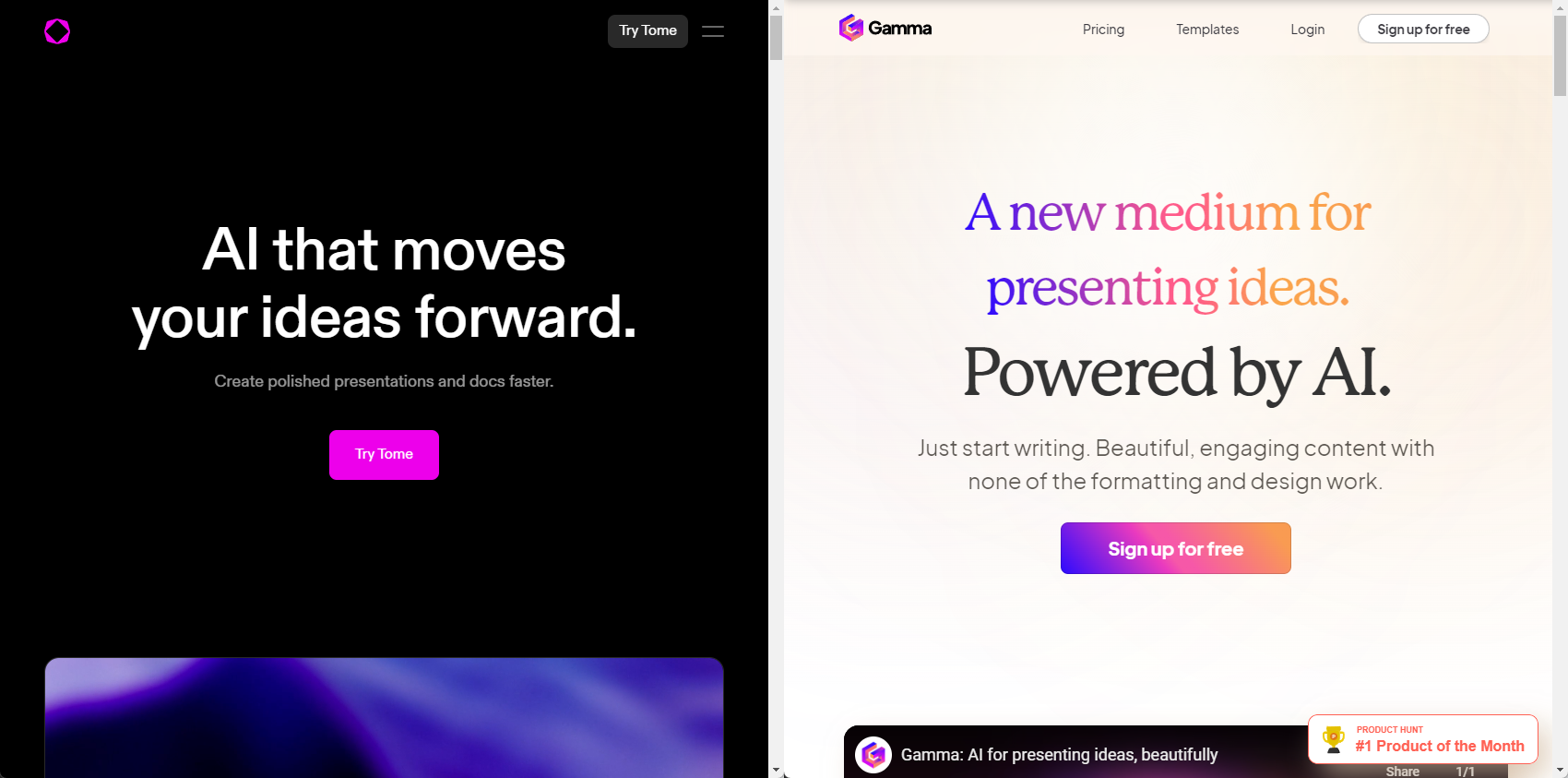
Tome vs. Gamma: In-depth comparison, pricing, and recommendations
In-depth comparison of Tome and Gamma with recommendations for which tool is right for you
More resources
235+ Ideas for persuasive speech topics
How to choose a great persuasive speech topic, inspiration and ideas, and example presentations for you to get started
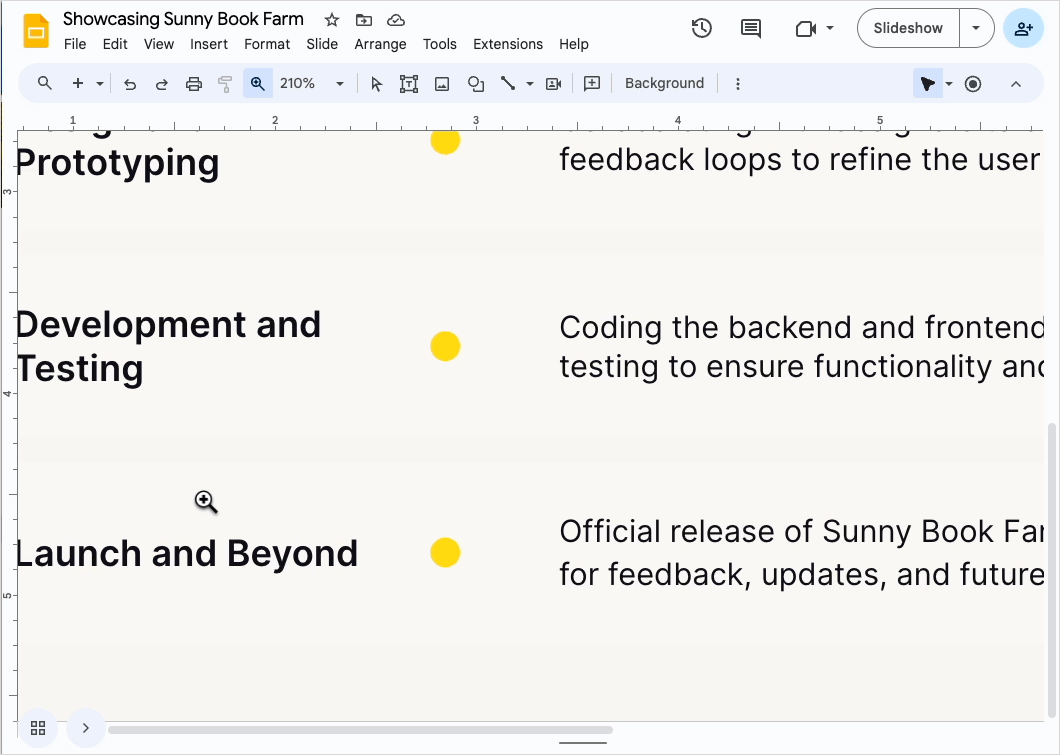
How to zoom in on Google Slides
When you zoom in on Google Slides, you get a close-up view of your text, image, or other slide element which makes it simpler to fine-tune those elements.
Ideas for your next PowerPoint Night
The best, funniest, and most thought-provoking prompts for your next PowerPoint night
How to Make Google Slides Look Good

Google Slides is a popular presentation software that allows you to create visually appealing slide decks easily. With the right techniques, you can design professional presentations that captivate your audience. This step-by-step guide will teach you how to make your Google Slides look fantastic.
Use Google Slides Templates
The easiest way to create great-looking slides fast is by using Google Slides templates . There are many free and premium templates available online that you can customize to suit your needs.
Here are the steps:
- Open Google Slides and click on Template gallery on the homepage
- Browse through different categories like Business, Education, Art, etc.
- Select a template that aligns with your presentation topic
- Click Use template to create a copy that you can edit
Using templates saves time and gives your presentation a professional edge from the start. You can modify colors, fonts, layouts, and content while retaining the overall design.
Optimize Page Layout
The page layout is the foundation of any visually appealing presentation. Follow these tips:
- Stick to a single column layout for easy viewing flow
- Use ample white space between elements
- Create a visual hierarchy so the audience knows what to focus on
- Align elements properly for a clean look
Spending time perfecting the layout ensures your content shines through clearly.
Establish Strong Visual Hierarchy
A strong visual hierarchy allows viewers to easily grasp the key information. Here are some ideas:
- Use a large, bold title to highlight important points
- Make key text stand out with size, color or style
- Group related elements together
- Use whitespace to distinguish sections
This technique naturally guides the audience through your content.
Choose Complementary Colors
Using colors strategically is crucial for an aesthetically pleasing presentation.
Here are some tips:
- Stick to a color palette of 2-4 colors
- Use a primary color to make key elements stand out
- Choose a secondary color for variety
- Use a neutral color like gray or white for backgrounds
- Ensure sufficient contrast between text and background
Harmonious colors make even simple designs look professional.
Use High-Quality Visuals
Nothing makes presentations more interesting than vibrant visuals. Some ideas:
- Insert relevant, high-quality photos
- Use infographics, charts and diagrams to represent data
- Animate builds and transitions for visual dynamics
- Apply shape masks to images for a creative flair
Visuals boost engagement, memory retention and showcase your creative abilities.
Master the Slide Master
The Slide Master in Google Slides allows centralized control over backgrounds and default text styles.
Follow these steps to customize it:
- Go to View > Master
- Select and modify background graphics or colors
- Change the font style and size for default text placeholders
- The updated Master will apply to all slides
This powerful tool ensures visual consistency across your presentation.
Add Cool Effects
Subtle animations and effects can make ordinary slides extraordinary:
- Use transitions like fade, wipe, glide with sounds for smooth flow
- Animate key elements to grab attention
- Add a neon text effect for titles
- Use the reflection effect on appropriate images
Well-placed effects add dynamism and polish to any presentation.
Creating visually captivating Google Slide presentations is easy with the right techniques. Using templates, optimizing page layouts and visual hierarchy, selecting complementary colors, adding high-quality visuals, customizing the Slide Master and incorporating cool animated effects can transform ordinary slides into extraordinary ones.
So open up Google Slides and start designing presentations that impress and inspire your viewers!
About The Author
Vegaslide staff, related posts.

How to Edit the Footer in Google Slides
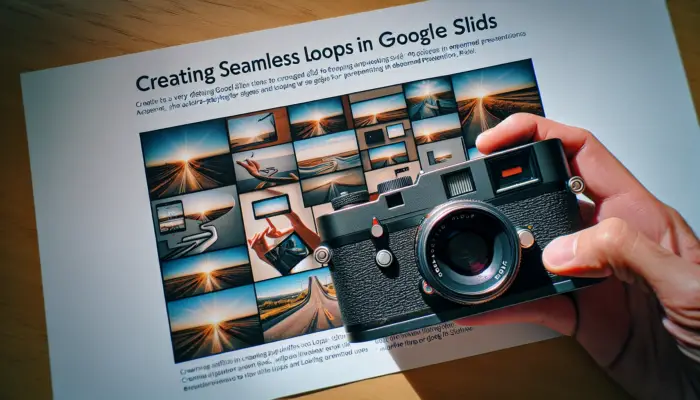
How to Continuously Loop Google Slides
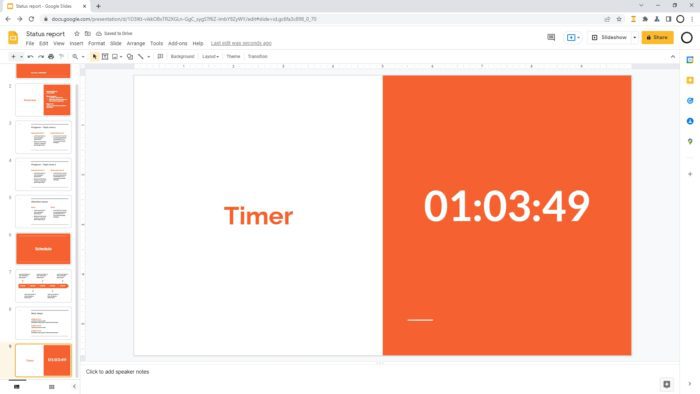
How to Add a Countdown Timer to Google Slides
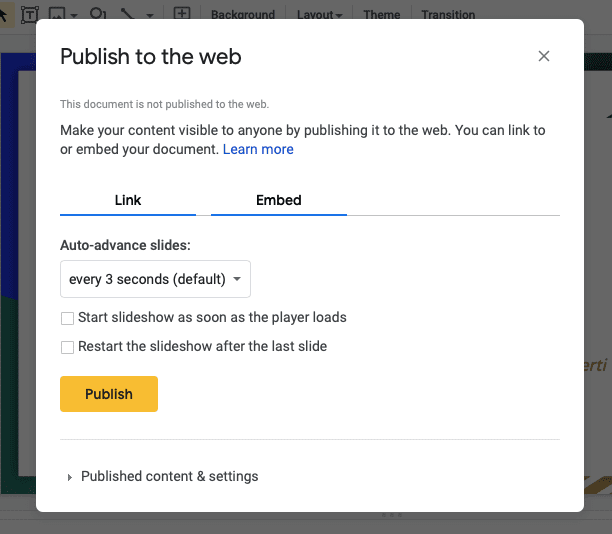
How to Make Google Slides Play Automatically

- Generative AI
- Office Suites
- Collaboration Software
- Productivity Software
- Augmented Reality
- Emerging Technology
- Remote Work
- Artificial Intelligence
- Operating Systems
- IT Leadership
- IT Management
- IT Operations
- Cloud Computing
- Computers and Peripherals
- Data Center
- Enterprise Applications
- Vendors and Providers
- United States
- Netherlands
- United Kingdom
- New Zealand
- Newsletters
- Foundry Careers
- Terms of Service
- Privacy Policy
- Cookie Policy
- Copyright Notice
- Member Preferences
- About AdChoices
- E-commerce Affiliate Relationships
- Your California Privacy Rights
Our Network
- Network World
Google Slides cheat sheet: How to get started
How to use Google Slides to create, collaborate on, and lead business presentations.

Need to build a slide presentation for a meeting, training, or other event? Google Slides is an easy-to-use web app that comes with the essential tools and more. It stores your presentations in the cloud with Google Drive. Anyone with a Google account can use Slides and Drive for free, and they’re also included with a Google Workspace (formerly G Suite) subscription for business and enterprise customers. There are Google Sheets mobile apps for Android and iOS, too.
This guide will help you become familiar with the Google Slides web interface and show you how to start a new presentation, upload a Microsoft PowerPoint file to edit in Google Slides, collaborate with others on your presentation, and finally, present it to others.
Create or open a presentation
Log in to your Google or Workspace account. Then:
From Google Slides : At the top of the home page, you’ll see a “Start a new presentation” header, with a row of thumbnails underneath. To start a new, blank presentation, click the Blank thumbnail. To start a new presentation in a template, select one of the thumbnails to the right or click Template gallery toward the upper-right corner, then click any thumbnail on the page that appears.
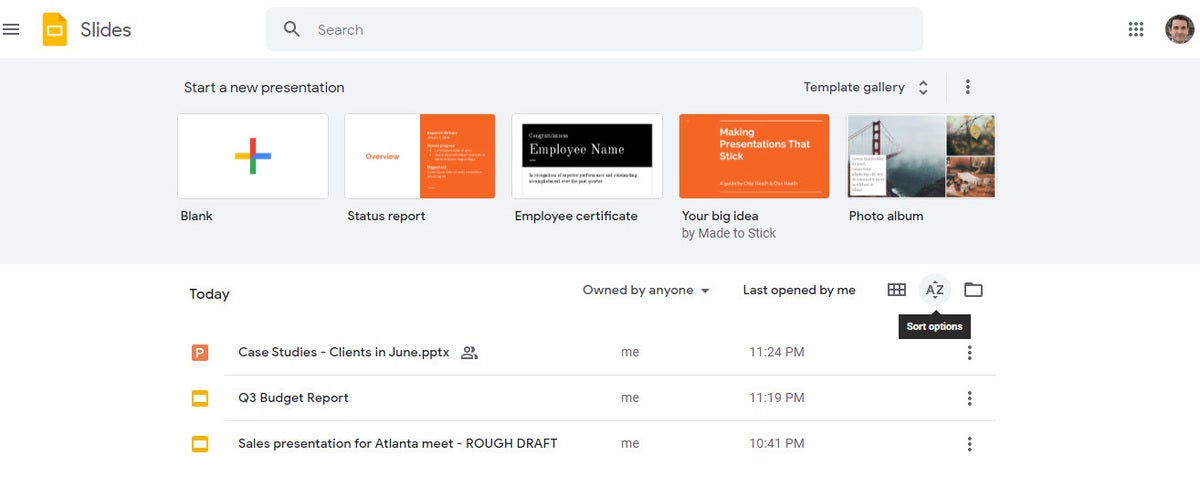
The Google Slides home page. (Click image to enlarge it.)
Below the “Start a new presentation” area you’ll see a list of presentations that are stored in your Google Drive or shared with you. To open a presentation, click it in this list.
The list of your presentations appears in reverse chronological order starting with the presentation you most recently opened. Clicking the “AZ” icon at the upper right of this list changes the sort order to Last modified by me , Last modified , or in alphabetical order by presentation title. You can also browse to a specific folder by clicking the folder icon next to the “AZ” icon.
From Google Drive : Presentations stored in your Google Drive are listed in the main window of the Drive home page. To see a listing of presentations that others are sharing with you, click Shared with me in the left column. From either list, double-click a presentation to open it in Google Slides.
To start a new, blank presentation, click the New button at the upper-left of the screen and then click Google Slides .
If you want to use a template to start a new presentation, click the New button, then move the cursor over the right arrow next to Google Slides and select From a template . The template gallery for Google Slides will open; click a thumbnail to start a new presentation in that template.
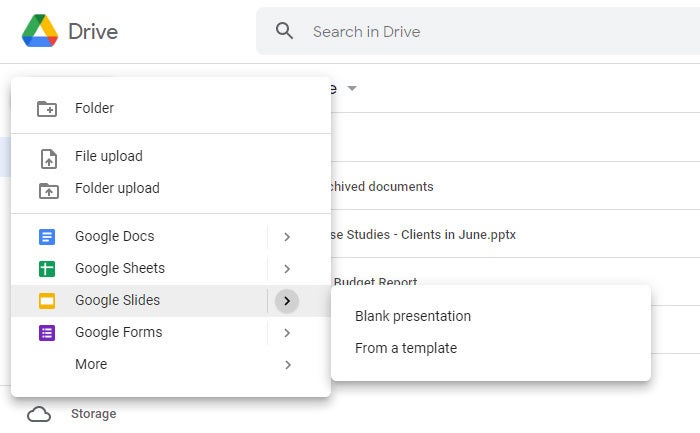
Creating a new presentation from Google Drive.
From Google Slides or Drive: You also can use the search box at the top to find presentations in your Google Drive or shared with you. Enter words or numbers that may be in the presentation you’re looking for.
Upload a PowerPoint presentation to Slides
You can edit a Microsoft PowerPoint presentation in Google Slides, but first you must upload it to Google Drive.
From Google Slides: Click the folder icon ( Open file picker ) that’s above and toward the right corner of your presentations list. On the panel that opens, click the Upload tab. Drag-and-drop your PowerPoint file (.ppt or .pptx) onto this panel, or browse your PC’s drive to select it.
From Google Drive: Click the New button, then File upload , and select the PowerPoint file from your PC’s drive and click Open .
Traditionally, when you uploaded PowerPoint files to Google Drive, they were automatically converted to Slides format. That’s still the case when you upload PowerPoint files via the Google Slides home page .
However, Google now supports the ability to edit Microsoft Office files in their native format. By default, any .pptx files that you upload via Google Drive will remain formatted as PowerPoint documents. You can edit and collaborate on a PowerPoint file right in Slides, with all changes made by you or your collaborators saved directly to the PowerPoint file.
On the Google Slides and Drive home pages, native PowerPoint files will be denoted with an orange “P” icon, and when you open a native PowerPoint file in Sheets, you’ll see a “.PPTX” flag to the right of the document title.

Native PowerPoint files show the PowerPoint icon (top) instead of the Google Slides icon (bottom).
If you’d rather have Google convert PowerPoint files to Slides format automatically when you upload them via Google Drive, click the gear icon in the upper-right corner of the Drive home screen and select Settings from the drop-down menu. In the Settings box next to “Convert uploads,” check the checkbox marked Convert uploaded files to Google Docs editor format .
Work in a presentation
When you open a new or existing presentation, its first slide appears in the main window of Google Slides. Here’s a breakdown of the toolbars, menus, panes, and sidebars that appear around your presentation.
The left pane shows thumbnails of all the slides in your presentation. Click a thumbnail, and the slide it represents will appear in the main window, where you can edit it.
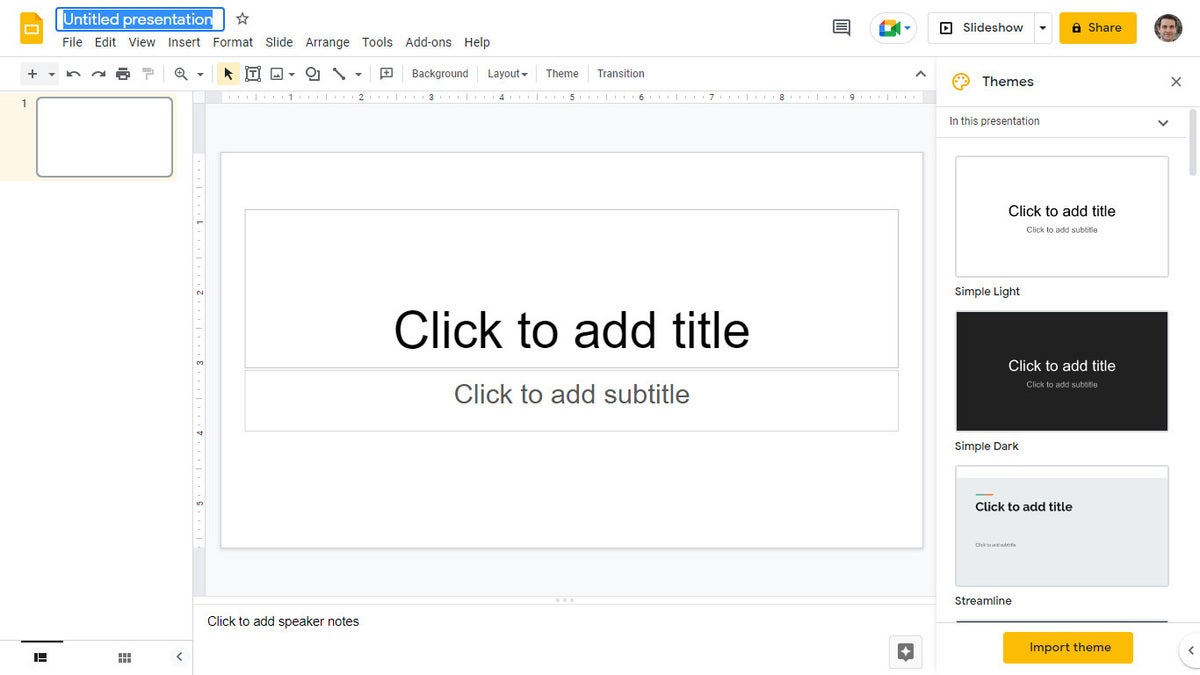
The Google Slides editing interface. (Click image to enlarge it.)
Your presentation’s title appears along the top of the screen. To change it, click anywhere inside the title and start typing.
The menu bar below your presentation’s title has a complete set of tools for working with presentations. These are the main submenus to know:
- File has commands for taking action on the whole presentation, including Print, Rename, and Share.
- Edit lists the standard editing commands such as copy, cut, paste, delete, duplicate, and find and replace.
- View lists several ways that you can view your slides as you design and edit them. This includes arranging them into a grid, previewing them as a slideshow, or zooming in on them. You can also watch the transition effect that takes place between slides when they’re played in a slideshow.
- Insert lets you add several objects to your slides, including charts, diagrams, pictures, tables, and text. You can also add links to YouTube videos or sound or video files that are stored in your Google Drive.
- Format lets you change the look of your slides. Certain functions on this submenu become clickable depending on whether you’ve selected an image or text on a slide, or selected the slide itself.
- Slide is where you can add, delete, or duplicate a slide that you’ve selected. You can also add a preset layout to a slide, change its background or theme color, or add and edit a transition effect that takes place between slides when your presentation is played as a slideshow.
- Arrange lists tools that let you group or reorder objects on a slide in relation to another. For example, you can place an image behind another image or group an image and a block of text together to make them easier to move at once.
- Tools leads to several miscellaneous functions. These include letting you record a voice clip to go with a slide, running a spell checker, and showing you a list of objects in your presentation that are linked to other files.
The toolbar directly above your presentation puts commonly used commands in easy reach. From this toolbar, you can click buttons to add to a slide or change its background, comments, layout, objects (images, lines, shapes, text), text style, theme colors for the whole presentation, transition effects during a slideshow, and more. The buttons on the toolbar change depending on whether you’ve selected image or text on a slide or the slide itself.
Notice that there’s no Save button in the toolbar — or anywhere in Google Slides. That’s because Slides automatically saves any changes you make to your presentation.
Speaker notes: Along the bottom of each slide you’ll see an area marked Click to add speaker notes . Here you can type in brief notes to remind yourself what to do or say when the slide is being shown. Only you will see these notes when you show your presentation to an audience.
Themes sidebar: When you start a new blank presentation, the Themes sidebar opens on the right side of the screen. (You can also open this sidebar at any time by clicking Theme on the toolbar above your presentation.) Themes apply the same fonts, colors, and other design elements to all the slides in a presentation, giving it a consistent look and feel. Click a thumbnail in this sidebar to change your presentation to that theme.
Create and manage slides
Here are the basic things to know about working with slides in a presentation.
Add a new, blank slide to your presentation: Click the + button at the left end of the toolbar above your presentation. Alternatively, if you click the down arrow next to the +, you can choose a layout to use as the basis for a new slide.
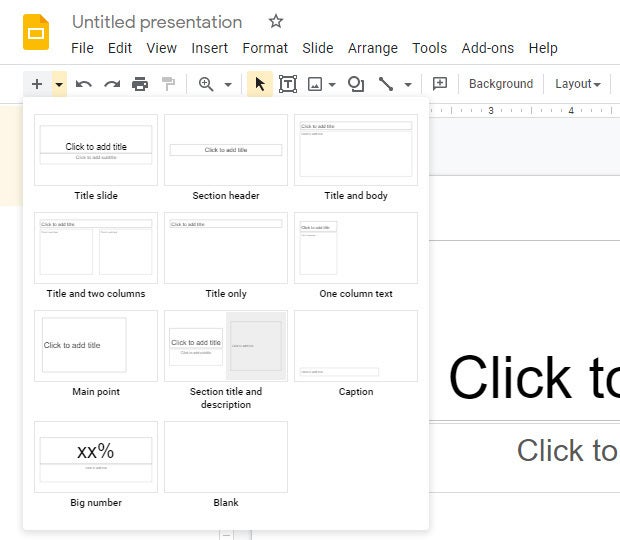
Click the down arrow next to the + button in the toolbar to choose a layout for a new slide.
Apply or change a slide’s background: Select the slide’s thumbnail in the left sidebar and click Background on the toolbar above your presentation. On the panel that opens, you can change the slide’s background color or use an image file from your Google Drive, Google Photos account, or PC as the background.
Apply or change a slide’s layout: Select the slide’s thumbnail in the left pane, then click Layout on the toolbar above your presentation. On the panel that opens, select the layout you want to apply to this slide.
Apply or change a slide’s transition: Select the slide’s thumbnail in the left sidebar and click Transition on the toolbar above your presentation. In the Motion sidebar that opens along the right side of the screen, you can apply or change the animated transition effect that is played before this slide.
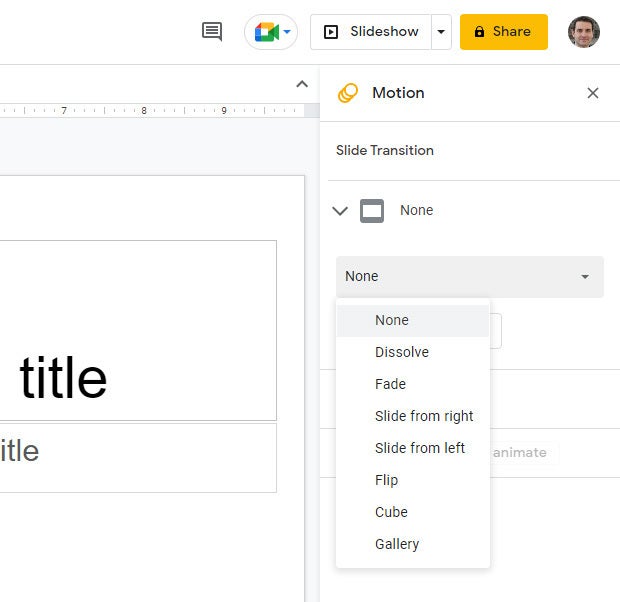
Choosing a transition style in the Motion pane.
Move a slide to a different spot in the slideshow sequence: Click and hold its thumbnail in the left sidebar, drag it up or down to another place in the sequence, and release it.
Delete a slide: Right-click its thumbnail in the left sidebar and select Delete from the pop-up menu. Alternatively, select its thumbnail and select Edit > Delete from the menu bar or just press the Delete key.
Share and collaborate on a presentation
Presentations are often a group effort, with several team members contributing to and polishing a presentation. In Slides, it’s easy for multiple collaborators to work on a presentation together.
First, you need to share the presentation. When you’re viewing your presentation in Google Slides, click the Share button at the upper-right. Or, from your Google Drive homepage, click to highlight the presentation that you want to share. Then, in the toolbar toward the upper right, click the Share icon (a head-and-shoulders silhouette with a +).
Either way, the “Share” panel will open.
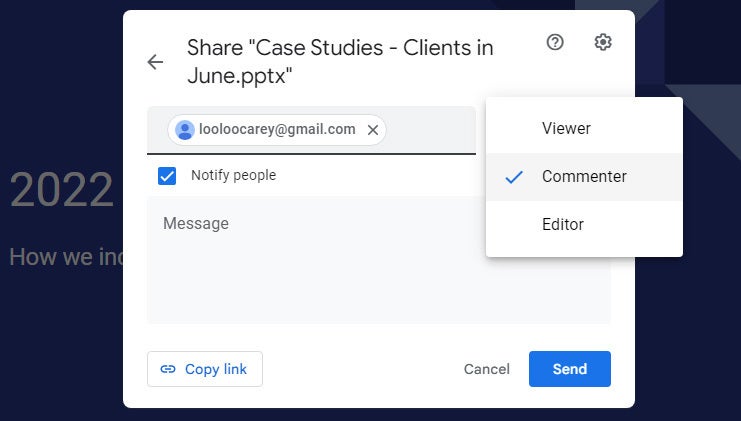
Setting permissions for a file being shared privately.
Share a presentation privately
In the entry box, enter the email addresses (or names of your Google Contacts) of the people with whom you want to share. By default, the people you invite to your presentation can edit it and reshare it with others.
To change access permissions for invitees: Click Editor to the right of the entry box and choose another option from the drop-down menu. Commenter means they can view your spreadsheet and add comments but can’t change it. Viewer means they can view your presentation but can’t edit it or add comments.
To prevent your presentation from being reshared, downloaded, or printed: Click the gear icon at the upper-right of this panel. On the smaller panel that opens, uncheck the boxes by Editors can change permissions and share and Viewers and commenters can see the option to download, print, and copy .
When you’re done setting permissions (and, optionally, typing in a message to your invitees), click Send , and everyone you’ve added will receive an email with a link they can click to access the document.
The shared presentation icon.
A presentation you’ve shared (or that others have shared with you) will have an icon of two silhouetted heads next to it in the presentations list on your Google Sheets and Google Drive home pages.
To limit or change a person’s access to your presentation: With the presentation open in Google Slides, click the Share button at the upper-right. Or, from Google Drive, highlight the presentation and click the Share icon.
The Share panel reopens showing a list of all the people you’ve invited, along with their permission status. Click the down arrow to the right of a person’s name, change their permission level or remove their access entirely, and click Save .
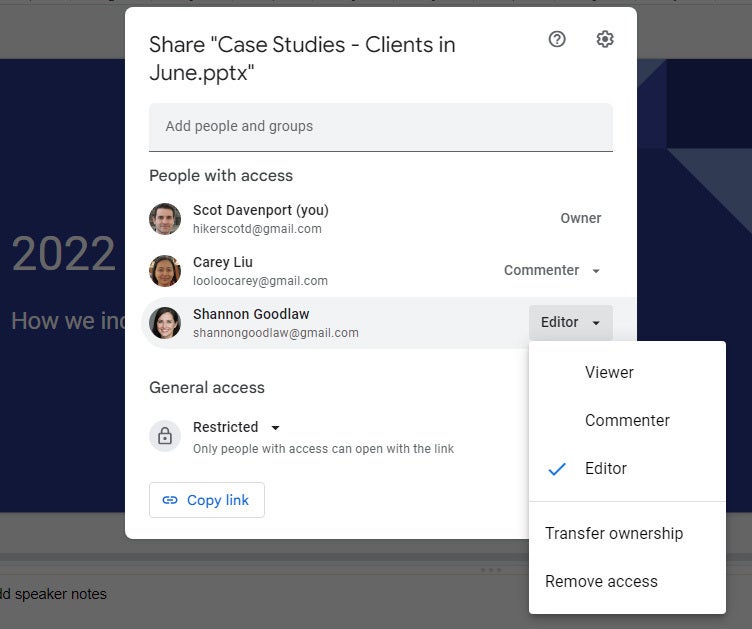
You can change permissions for people you’ve shared a presentation with on an individual basis.
If you have a Google Workspace subscription, another option is to select Give temporary access and, next to Access expires , select a date within one year of the current date. If you set an expiration date for a person that you’ve assigned as Editor, their access will be downgraded to Commenter on the expiration date.
Share a presentation publicly
Most business users will want to share presentations privately with select colleagues or clients, but you do have the option to share a presentation publicly. At the bottom of the Share panel is a “General access” area where you can copy a link to the document. By default, this link is restricted to those you invite to the document. To change it to a public link, click Restricted and select Anyone with the link from the menu that appears.
Click Copy link and the link to your presentation will be copied to your PC’s clipboard. You can share this link by pasting it into a chat message, document, email, forum post, or most other means of online written communication. Anyone who clicks this link will be able to view your presentation online. (Be aware that anyone can copy and reshare this link.)
To allow anyone in the public to comment on or edit your presentation: At the bottom right of the Share panel, click Viewer and select Commenter or Editor from the drop-down menu. Then click the Done button. Now the web link to your presentation will let anyone who clicks it add a comment or edit it.
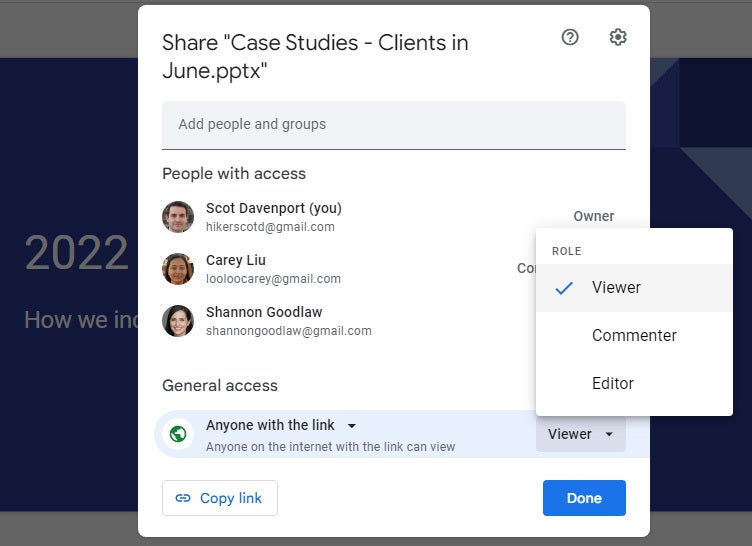
Sharing a spreadsheet publicly.
To turn off public sharing for your presentation: Bring up the Share panel again. Near the bottom, click Anyone with the link and select Restricted from the menu, then click the Done button.
Note: You can apply both public and private sharing methods to your presentation. For example, you could allow the public to only view your presentation, but allow specific people that you’ve invited to comment on or edit it.
Collaborate on a presentation
The people you’ve shared a spreadsheet with can view or work on it at the same time as you or at other times. Remember that people who have Editor privileges to your presentation can change all aspects of it. Having multiple people making changes to a presentation can get confusing. In most cases, setting everyone to Commenter is the best way to collaborate in Slides: People can attach comments to a slide or to objects in a slide, but their comments won’t alter your presentation’s information or design.
To add a comment to a slide: Right-click its thumbnail in the left sidebar and select Comment from the menu that opens. Alternatively, you can select its thumbnail and select Insert > Comment from the menu bar or click the Add comment button (a speech balloon with a + sign).
A blank comment card with your name on it opens to the right of the slide in the main window. On this card’s entry line, type a brief comment, and when you’re finished, click the Comment button.
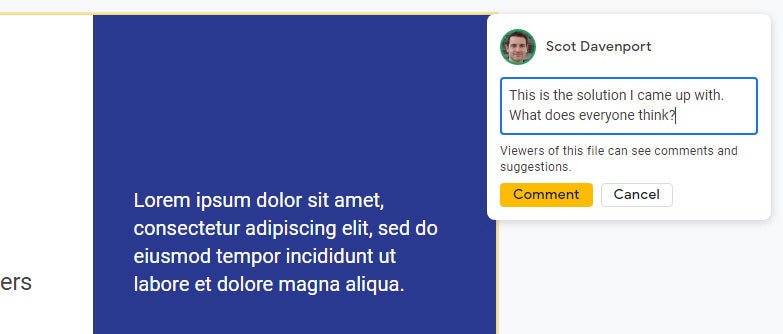
Typing in a new comment.
To add a comment to an object on a slide: Right-click the object (a block of text, chart, image, picture, etc.) and select Comment from the menu that opens. Alternatively, you can select the object and select Insert > Comment from the menu bar.
To draw someone’s attention to a comment: As you’re composing the comment, type the @ symbol and begin typing their name, then select the person from the list of suggested Google contacts that appears. They’ll receive an email notifying them of the comment and linking to it.
To read, reply to, or remove a comment: A slide that contains a comment is denoted in the left sidebar with a speech balloon by its thumbnail. Click the slide’s thumbnail to make the slide appear in the main window, and you’ll see all its comment cards on the right.
To reply to a comment, click its card. The card will expand to reveal an entry line where you can add a comment in response.

Replying to a comment.
Clicking the checkmark at the upper right marks the comment card as “resolved” and removes the card from the presentation. Clicking the card’s three-dot icon opens a menu that lets you edit or delete your comment.
To see a list of all comments: Click the Open comment history icon (the speech balloon) to the left of the Slideshow button. A sidebar will open along the right side of the screen; it lists all the comment cards in your presentation. When you click a comment on this list, the view of your presentation in the main window will jump to the cell where the comment is located and open its comment card.
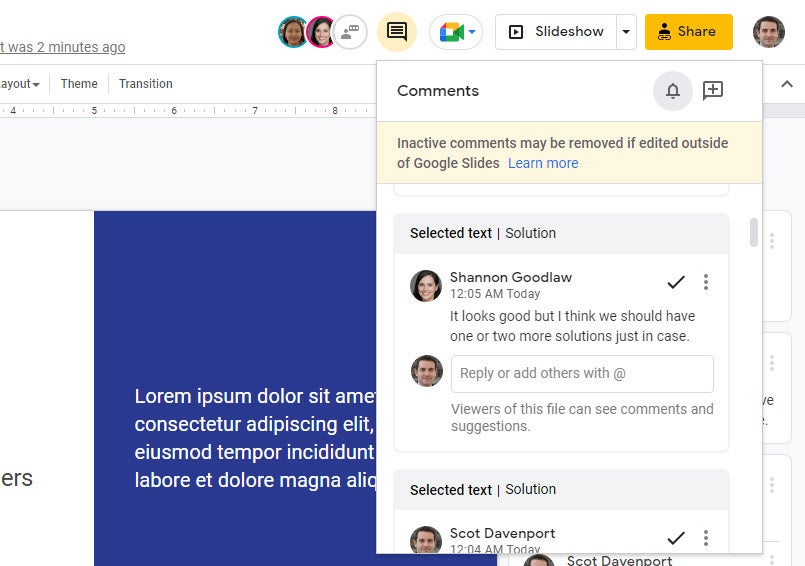
The Comments pane lets you quickly review all comments and jump to specific ones.
For more details about collaborating on your presentation, including what it’s like to collaborate in real time, see “ How to collaborate on a document ” in our Google Drive guide. You can also collaborate on a presentation in Google Chat; that’s covered later in this story.
Recover older versions of a presentation
It’s easy to go too far when making tweaks to a presentation. Fortunately, it’s also easy to roll back to an earlier version of the presentation. Click File > Version history > See version history . This opens a panel on the right that shows a list of older versions of your presentation.

Using Version history to view an earlier version of a presentation. (Click image to enlarge it.)
To view an earlier version of your presentation: Click the date for it in the list. That version of the presentation will then appear in the main window.
To restore an earlier version so it replaces your current presentation: With the version you want to restore showing in the main window, click the yellow Restore this version button at the top of the screen. The restored version will then appear at the top of the version history list.
To give an older version a unique name: Click on its date. You’ll be prompted to type in words to replace the date. (The date and time will then appear in smaller size underneath the new name.)
Give a presentation
When it’s time to play your presentation to an audience, Google Slides has two modes: Slideshow and Presenter view. Slideshow mode essentially shows what your audience will see. Presenter view mode provides additional tools for your eyes only that run alongside Slideshow mode.
Slideshow mode: Click the Slideshow button at the upper-right corner of the screen. Google Slides will expand to full-screen view and show the slide that’s currently in the main window. (If you want to start the slideshow from the first slide in your presentation, click the down arrow to the right of the Slideshow button and select Start from beginning .)
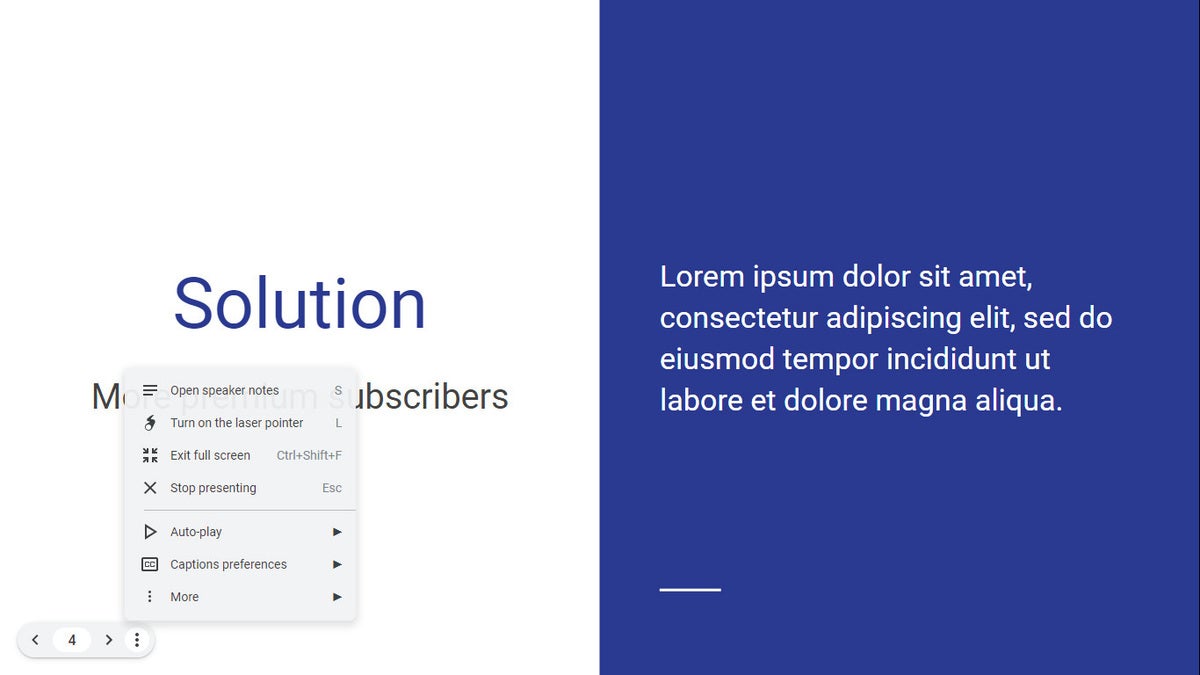
The control bar in Slideshow mode lets you click through the slides, turn on auto-play, use a laser pointer effect, and more. (Click image to enlarge it.)
When you move the on-screen pointer to the lower-left corner of your presentation, a control bar appears. You use this to click forward and back through the slides. Clicking the three-dot icon on the control bar opens a menu with other controls, such as starting auto-play and adjusting how quickly it moves from slide to slide.
On this menu, Turn on the laser pointer turns the mouse pointer into a simulated red laser dot. Captions preferences — available only if you’re using a Chrome browser or Chromebook — lets you turn on real-time, automatic transcribing of your words as you say them (English only) and shows them to your audience as on-screen captions. Open speaker notes takes your presentation out of full screen and opens a separate “Presenter view” window, as described below.
Presenter view mode: Click the down arrow to the right of the Slideshow button and select Presenter view . This shows the presentation in your browser window and launches a separate window that assists you while you’re giving your presentation.
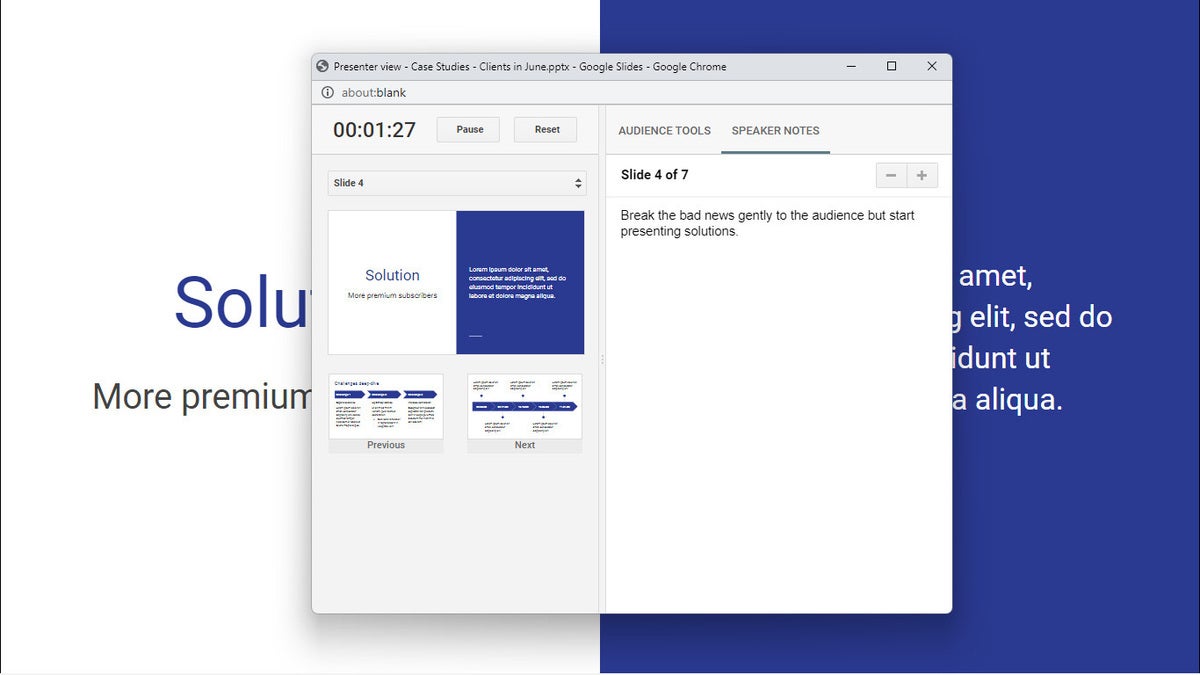
Presenter view lets you (but not your audience) see your speaker notes while presenting. (Click image to enlarge it.)
From the Presenter view window, you can jump to any slide in your presentation, read the speaker notes you wrote for a slide, and control the Q&A feature. There’s also a timer that you can set to remind yourself how much time you’re spending showing a slide — or the entire presentation — to your audience.
Click the AUDIENCE TOOLS tab to use the Q&A feature, which lets you take questions from your audience. To open questions for a slideshow, click the Start new button. A web link appears at the top of your presentation. An audience member watching your presentation on their computer, phone, or tablet can click/tap that link, which will take them to a page where they can type a question for you. You’ll see the question in your Presenter view window, and you can choose whether to show their question to the rest of your audience during the presentation. To close questions for a presentation, turn the switch from ON to OFF .
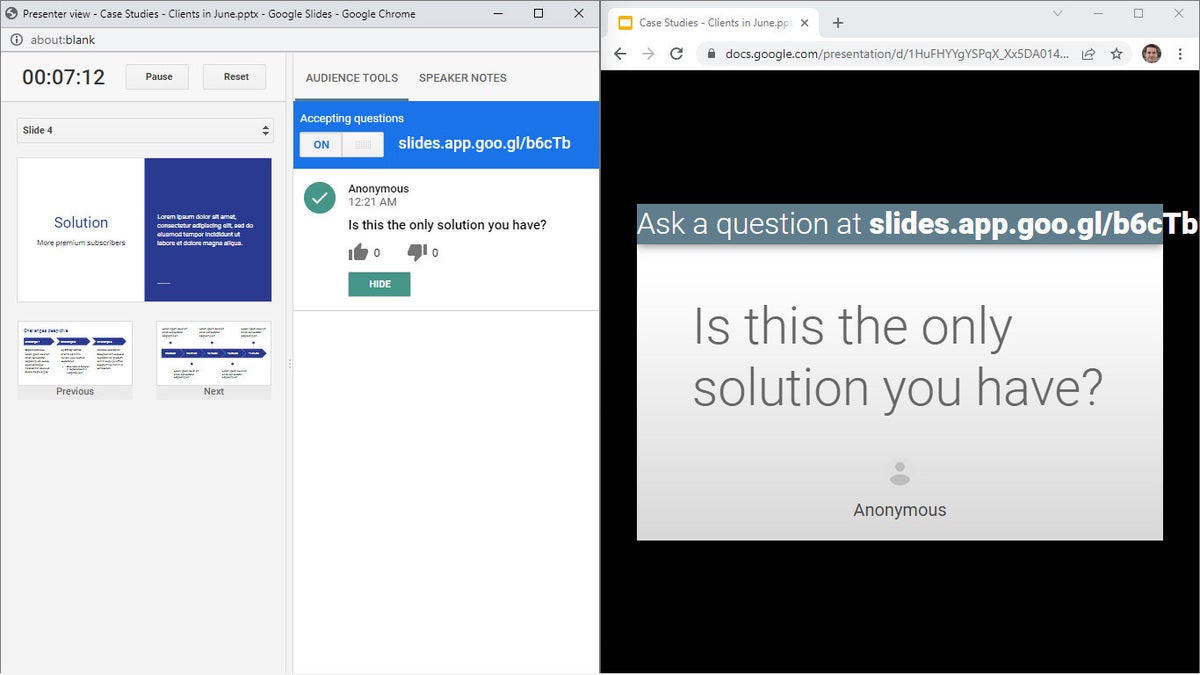
Audience members can submit questions from their devices, and the presenter can decide whether to display them as part of the slideshow. (Click image to enlarge it.)
Present in Google Meet
Need to give a presentation during a Google Meet video meeting? As long as you’re using a Chromium-based browser (Chrome, Microsoft Edge, Opera, etc.), it’s easy: Toward the upper right of the Google Slides page, click the Google Meet icon. From the panel that opens, select a meeting that’s scheduled on your Google calendar today, start a new meeting, or type/paste in the web link or code that you have for another meeting.
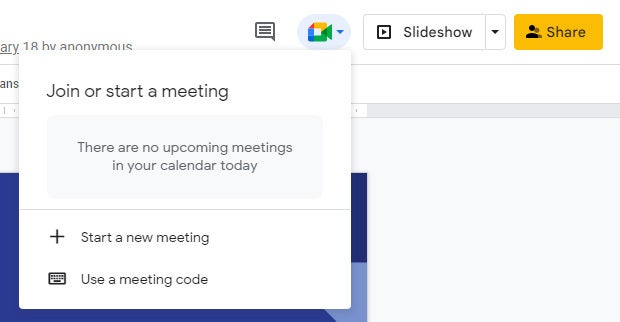
Click the Meet icon to get started presenting to a video meeting.
If you start a new meeting, a sidebar for the meeting will open on the right. At the bottom of the sidebar, click the Present now icon (a box with an up arrow). On the panel that appears, select your presentation and click the Share button, and you’ll be presenting to the meeting.
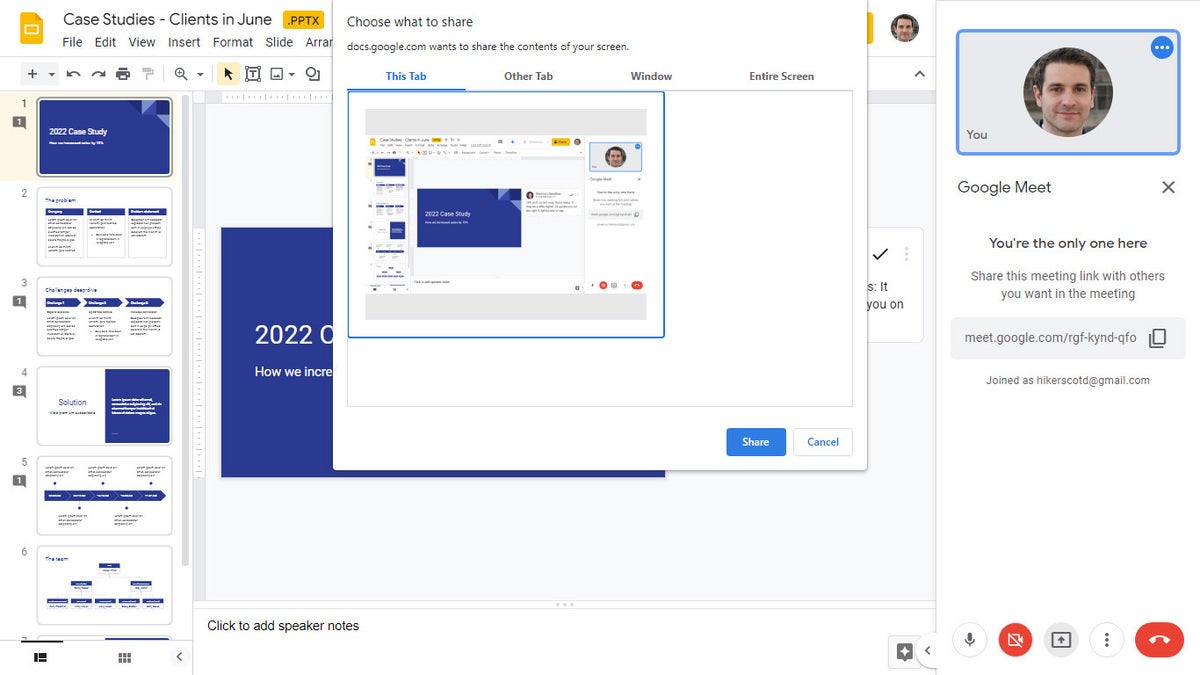
Choose which tab or window you want to share and click the Share button. (Click image to enlarge it.)
If you join a scheduled meeting, you have two choices: “Join the call” and “Just present this tab.” If you click Join the call , a sidebar for the meeting will open on the right. Follow the same steps as above to present to the meeting. If you click Just present this tab , you’ll go directly to the panel where you select your presentation and click Share , but you won’t have a sidebar where you can follow the main meeting.
To stop sharing your presentation to the meeting, click the Stop sharing button at the top left of your browser window.
For more details about using Google Meet, see our Google Meet cheat sheet .
Download and export a presentation
Google Slides lets you download presentations for use offline. On the top menu, select File > Download and choose a file format. You can save your presentation to your PC as a PowerPoint (.pptx) file or in other formats such as PDF, or as JPG or PNG for an individual slide.
5 tips for working with Google Slides
Now that you’re comfortable working in Google Slides, try these intermediate tips.
Use the Google Slides mobile app
With the exception of the “Version history” tool, the Google Slides app for Android , iPhone , and iPad has many of the same features described in this guide.
When you have a slideshow open, the toolbar at the top of the screen lets you take a variety of actions:
- To present your slides on your phone or tablet, on a Chromecast device, or in a Google Meet meeting, tap the triangle icon.
- To share your presentation with other people, the headshot silhouette. (See “How to share from the Google Drive, Docs, Sheets, and Slides mobile apps” in our Google Drive cheat sheet .)
- To view all the comments in the presentation, tap the Comments icon (a chat balloon) if you see it in the toolbar, or tap the three-dot icon and select View comments from the menu that appears.
- The three-dot menu also lets you see the presentation’s Q&A history, export it, make it available offline, and more.
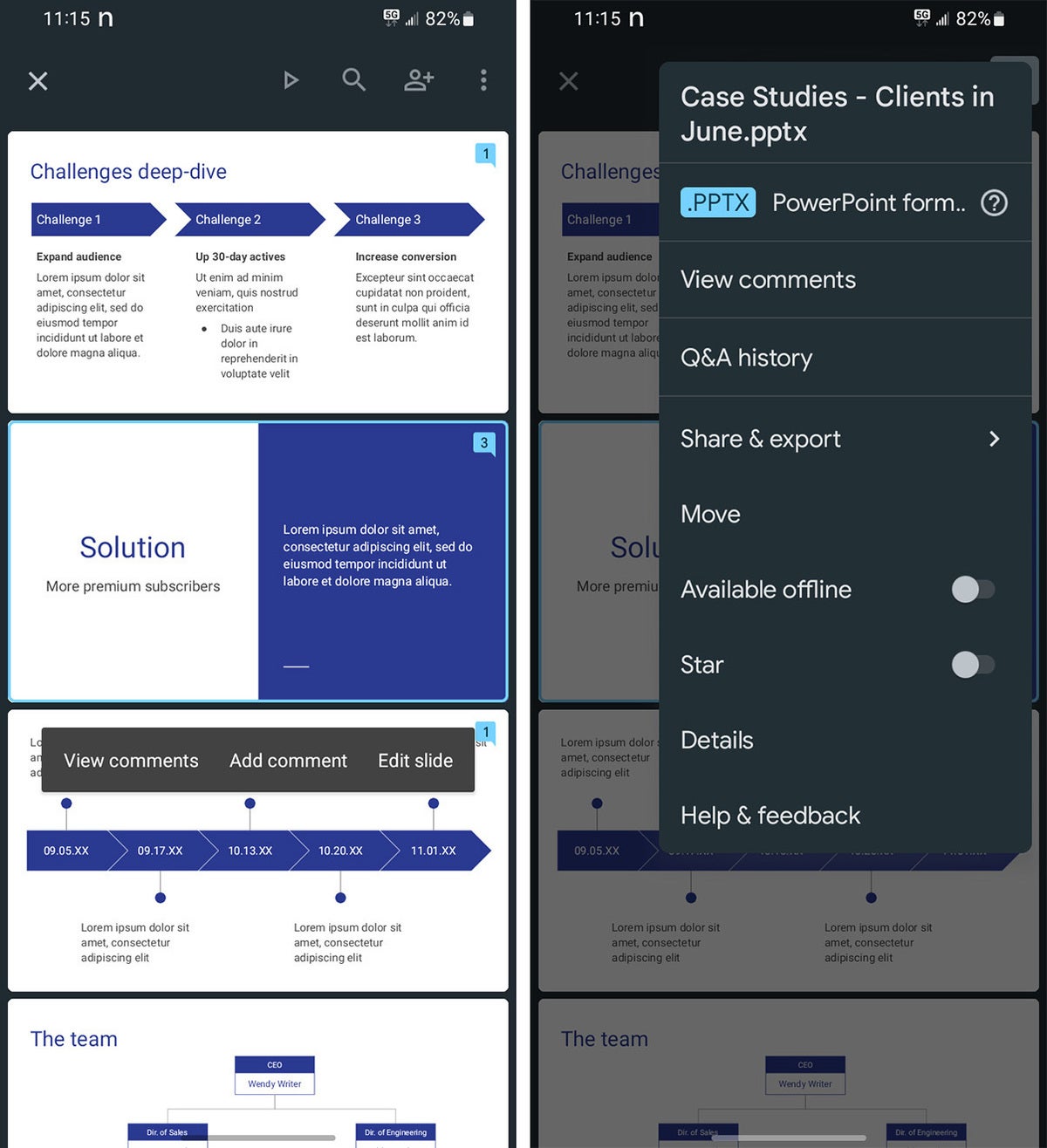
The Google Slides Android app.
To edit or comment on a slide: Tap the slide, and a menu will appear that lets you add or view comments for that slide or edit it. Tap an element on a slide, such as text or an image, and tools to edit that element will appear.
Any changes you make to your presentation in the mobile app are automatically saved and will appear the next time you open it in the Google Slides web app.
Get suggested slide layouts and content
Click the Explore icon at the lower-right corner of the screen. The Explore sidebar will open along the right side. In most cases, you’ll be presented with thumbnails of suggested layouts that Google Slides has automatically customized for the slide that’s open in the main window. Click the one you want, and it will be applied to the slide.
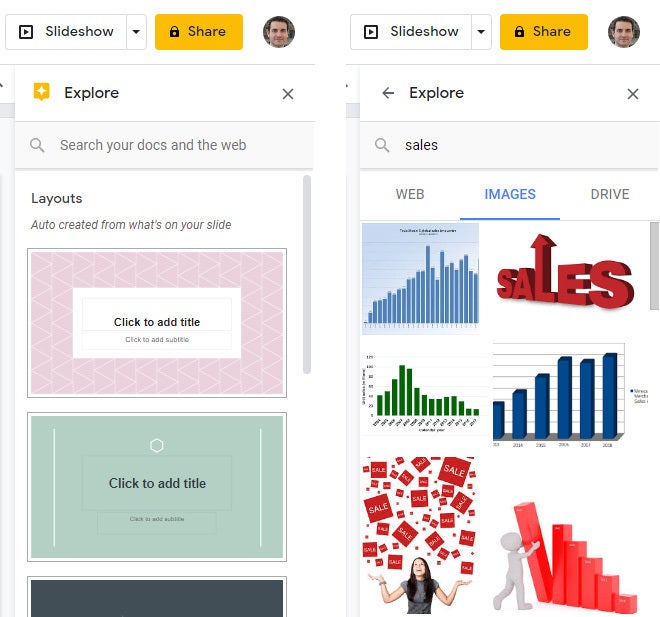
Use the Explore tool to get suggested layouts (left) and search for images (right).
At the top of the Explore sidebar is a search box. You can type in a word or phrase to find related content on the web or in your Google Drive. Search results appear on separate Web, Images, and Drive tabs in the sidebar. Click a web or Drive result to open it in a new browser tab. On the Images tab, click the + icon on the upper-right corner of an image to insert it onto your slide.
Create custom slide layouts to use as templates
You can design your own slide layouts to use as templates in any future presentation. First, open a new, blank presentation as described above. Then:
- On the menu bar over the blank presentation, select View > Theme builder .
- The main window switches to a layout editor. Toward the left you’ll see a column with the heading THEME on top and LAYOUTS just below that. Click the thumbnail of any layout in the LAYOUTS list. It will appear in the main window.
- You can remove objects that are already in any layout. For example, click on a block of text. A frame appears around the text. Without selecting the text itself, move the pointer to ward an edge of the frame, right-click, and select Delete from the menu that opens.
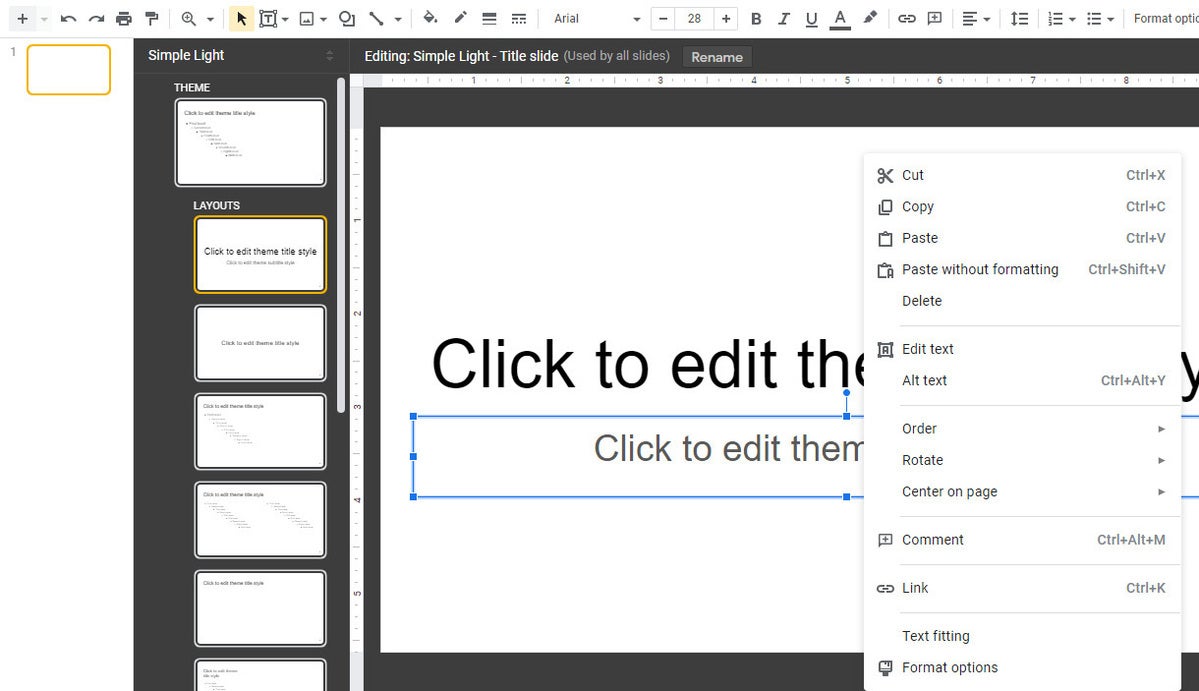
Creating a custom slide layout. (Click image to enlarge it.)
- Using the formatting toolbar above the slide, you can add new objects to the slide, including images, image placeholders, shapes, lines, and blocks for text. (Tip: enter placeholder words inside the text blocks.) When you click on any object, a frame appears around it. Drag and drop the frame to relocate it on the slide, or drag its edges to change its shape or size. You can also add or change the border and background colors for any object on the slide and/or change the background color for the whole slide.
- When you’re finished designing your layout, click the Rename button above the slide and give the layout a unique name.
- If you want to create another custom layout, click on the thumbnail of another layout under the column LAYOUTS and repeat the above steps starting from #3.
- When you are finished custom-designing all your layouts, click the X toward the upper-right of the slide layout in the main window.
- Along the top of the screen, click anywhere inside Untitled presentation and start typing. Tip: Use a name that indicates this is a template (e.g., “Annual Budget Presentation – Template”).
In the future, you can make new presentations starting from this template, and your custom slide layouts will be available.
- Open the template presentation you created in the steps above. On the menu bar, click File > Make a copy > Entire presentation . On the panel that opens, type in a name for the new presentation you want to create and click the Make a copy button. Google Slides will open this new presentation in a new browser tab.
- On the toolbar above the first slide of your new presentation, click Layout . From the panel of thumbnails that opens, select one of the layouts that you created. It will then be applied to the slide in the main window.
Collaborate on a presentation in Google Chat
An alternative way to collaborate on a presentation is to share it in Google Chat. Other people in your chat can add comments and help make changes to your presentation.
Start in Google Chat . To the left of the box where you type in your chat messages, click the + icon and select Drive file from the menu that opens. A panel will open over the screen listing the files in your Google Drive. Find and click your presentation to highlight it, then click INSERT on the lower-right corner.
You’ll be taken back to the chat message box. Click the blue right-pointing arrow to the right of the box, and a panel will open over the screen designating permissions for the shared presentation. By default, permissions are set to Comment. To change this, click Comment and select View or Edit . You can also allow the people in the chat to share a web link to your presentation with others outside of the chat by selecting Turn link sharing on .
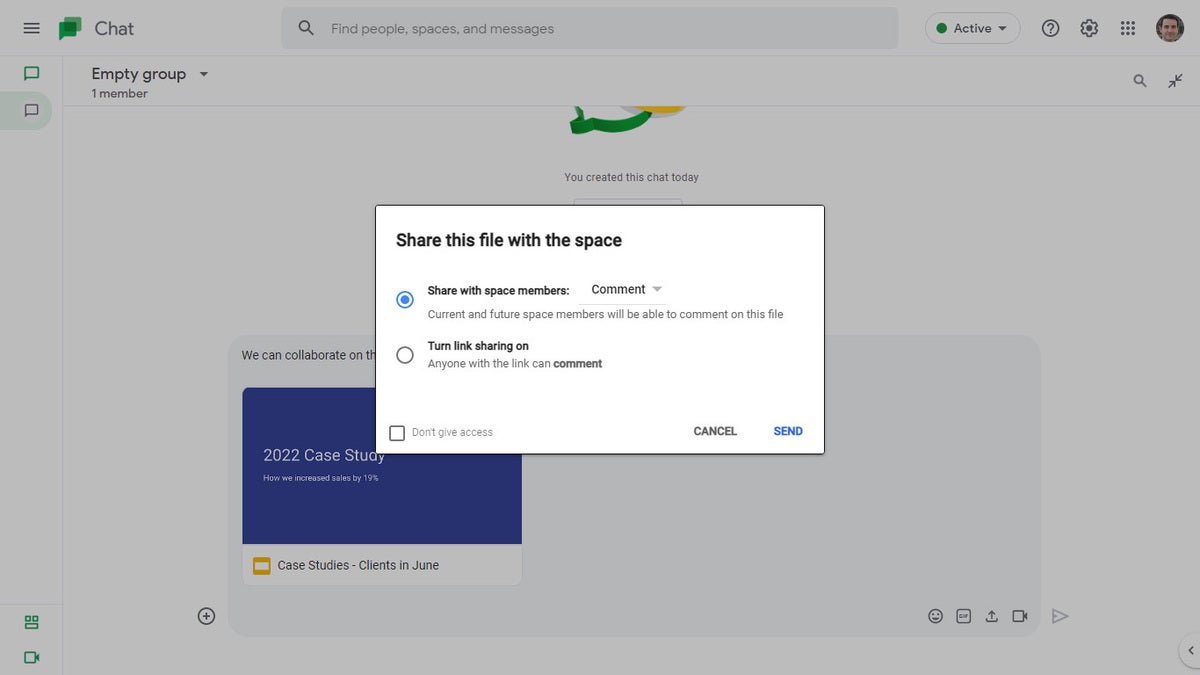
You can share a presentation to individual or group chats in Google Chats. (Click image to enlarge it.)
After you’ve set the permissions, click SEND , and your message will appear in the chat stream with a large thumbnail of your presentation. To open a presentation in the chat, click the thumbnail. The presentation will open inside a large window that’s laid out alongside the right of the chat stream.
This is actually Google Slides running inside the chat window with your presentation loaded in it. Thus, most of the Slides commenting and editing tools are available for you and others in the chat to use on your presentation (if you granted them permission to comment or edit). The user interface is the same, except there’s no menu bar.
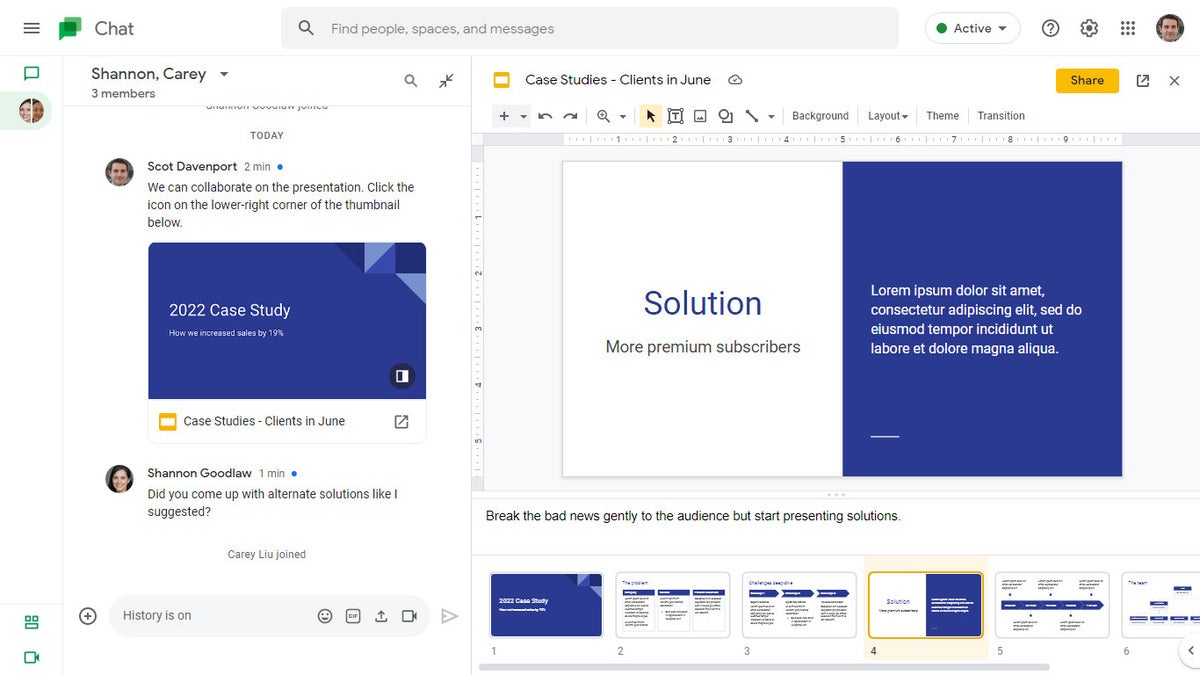
Collaborating on a presentation from within a Google Chat. (Click image to enlarge it.)
Use keyboard shortcuts
Save time in Slides by using keyboard shortcuts for common tasks. Below are some of the most useful to know. For more, select Help > Keyboard shortcuts from the top menu when you have a spreadsheet open or press Ctrl + / (Windows, Chrome OS) or ⌘ + / (macOS).
Handy Google Slides keyboard shortcuts
This story was originally published in September 2019 and updated in August 2022.
Related content
How many jobs are available in technology in the us, apple's find my system is coming to android, how to use a smartphone as a mobile hotspot, android 14 upgrade report card: predictable unpredictability, from our editors straight to your inbox.
Howard Wen ( www.howardwen.com ) is a longtime contributor to Computerworld . He specializes in explainer guides, how-tos, and reviews of office applications and productivity tools.
More from this author
Google docs cheat sheet: how to get started, 8 highly useful slack bots for teams, microsoft onedrive cheat sheet, 9 chrome extensions that supercharge google drive, most popular authors.

- Howard Wen Contributing Writer
Show me more
A phish by any other name should still not be clicked.

India is about to become Apple's third-biggest market

Windows 11 Insider Previews: What’s in the latest build?

The link between smartphones and social media addiction

Sam Bankman-Fried gets 25 years in prison

How to combat social media addiction


Google Slides: How to make a phone-friendly, vertical presentation
W hile your presentation shows up thoroughly on a laptop, TV, monitor, or projector, the default landscape orientation doesn't play well on smartphones. If you plan to give a quick presentation on a smartphone or want to add a touch of novelty to stand out, use the steps below to use vertical orientation in Google Slides.
Apart from enhancing the mobile experience, vertical orientation simplifies the printing process, delivers a better flow of information, and makes your presentation stand out among other horizontal slides.
Although Google offers feature-rich Slides mobile apps on iPhone and Android , vertical orientation is only available on Google Slides for the web.
Use vertical orientation in Google Slides
You shouldn't create and complete a presentation in landscape mode and change the orientation at the end. It may mess up the graphical elements of your presentation. Follow the steps below to use vertical orientation in Google Slides.
- Navigate to Google Slides on the web and open a presentation you want to edit.
- Click File at the top and select Page setup .
- Expand the top menu and find the default options. Standard 4:3 is ideal for viewing your presentation on a tablet. Widescreen 16:9 is suitable for viewing a slide on a TV, projector, or monitor. Widescreen 16:10 is the preferred dimension for viewing a presentation on modern laptops with taller displays.
- None of the default options offer vertical orientation. Select Custom .
- Expand the side menu and select Inches , Centimeters , Points , or Pixels . Let's select Inches .
- Type 9 x 19.5 (preferred for modern smartphone displays) and select Apply . You can also select Pixels and type 1080 x 1920 (common on most Android phones).
- You can check the entire site in a vertical orientation.
Now, you can use Google Slides features to create an ideal presentation.
How to autoplay your Google Slides presentation
Popular portrait orientation dimensions.
Whether you want to create a portrait presentation for printing or smartphones and smaller screens, glance over and memorize some common vertical slide sizes.
- A3: 29.7 x 42 cm
- A4: 21 x 29.7 cm
- US Letter: 8.5 x 11 inches (identical to A4 size)
- US Legal: 8.5 x 14 inches
Try the dimensions below to view a presentation on a smartphone or upload it to a social media network like Instagram, TikTok, or Snapchat.
- iPhone 15 Pro: 1179 x 2556 pixels
- Samsung Galaxy S24 Ultra: 1440 x 3120 pixels
- Google Pixel 8 Pro: 1344 x 2992 pixels
If you don't want to deal with these unusual pixel numbers, use 1080 x 1920 pixels in the page setup menu for vertical slides.
When should you use vertical slides?
Vertical slides come with several benefits. You need to factor in your audience and the context of the presentation. Here are the top reasons for using a vertical orientation in Google Slides.
- Better mobile experience: A vertical orientation makes more sense if you plan to view your presentation on the phone. Scrolling on vertical slides feels more intuitive than tapping them.
- Seamless printing: Since a vertical layout is suitable with most standard paper sizes, you don't need to make any major tweaks to fit the content on paper.
- Ideal for online presentations: Do you plan to share a presentation with your students or attendees over a video conference? Not everyone has a laptop to view your shared presentation. Use a vertical orientation that's more user-friendly for your audience.
- Suitable for social media platforms: Go with a portrait ratio if you want to share a presentation during livestreaming on a social media platform like TikTok or YouTube.
- Novelty factor: Vertical slides add a unique touch to your presentation. When everyone else addresses the audience with the same horizontal slides, a vertical presentation adds a unique touch to your pitch.
Using vertical orientation in a presentation: Our observations
Before you apply a vertical orientation, keep the points below in mind.
- Google Slides doesn't allow you to mix horizontal and vertical slides. The tweak applies to the entire presentation when you change the page setup.
- If you use a Google Slides template, adjust your designs accordingly. Most templates are designed for landscape orientation and don't use flexible elements that automatically fit a vertical slide.
What's the difference between Google Slides templates and themes?
Optimize your presentation for mobile convenience.
Whether you use a horizontal or portrait orientation, your presentation must hit the bull's eye to catch your audience's attention. Instead of creating a presentation from scratch and ending up with a bland one, use one of the top Google Slides templates to speed up the process.
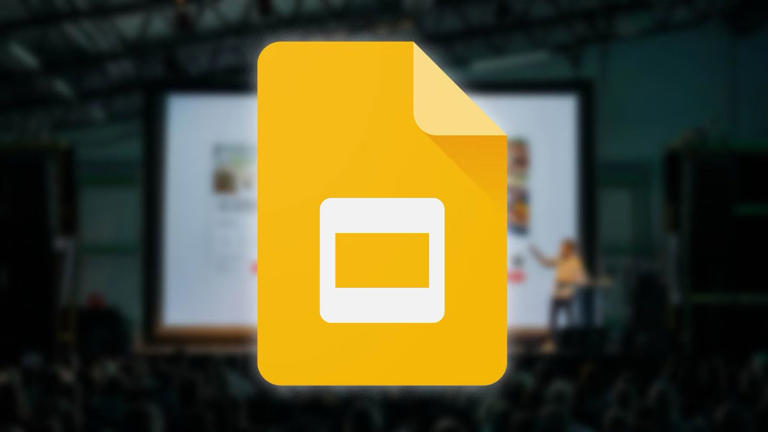

- Disk & Data Manager
- Partition Wizard
- Power Data Recovery
- ShadowMaker
- Media Toolkit
- uTube Downloader
- Video Converter
- Download MovieMaker
How to Make Google Slides Look Good?
This post created by MiniTool MovieMaker walks you through why you should make your Google Slides visually appealing, what are the benefits of adding design elements, and how to make Google Slides look good.
Since ancient times, people have been fascinated by beauty. Whether we’re discussing cave paintings or Renaissance art, people have always loved art. Only the means change; our nature does not.
No matter which presentation software you choose (like Google slides, PowerPoint , WPS Office, etc.), strong performance revolves around three essential elements: confident speakers, useful content, and excellent design. Also, while many people try to add a lot of information and improve as an orator, many speakers leave out the visual elements for one reason or another.
Why Make Your Google Slides Visually Appealing?
A presentation that looks good visually can have a big impact on your audience.
Your audience browses tons of information every day, including news, videos, chats, social media feeds, and more. A brain that is used to receiving a lot of information every day will filter out most of it. Only the most shining moments have the chance to be remembered by you.
The same goes for presentations. If you have tips on how to make a Google Slides look good, your idea may be “sold”, earning you points. However, if you have something extra – like a pinch of salt – it will help distinguish a good presentation from a great one.
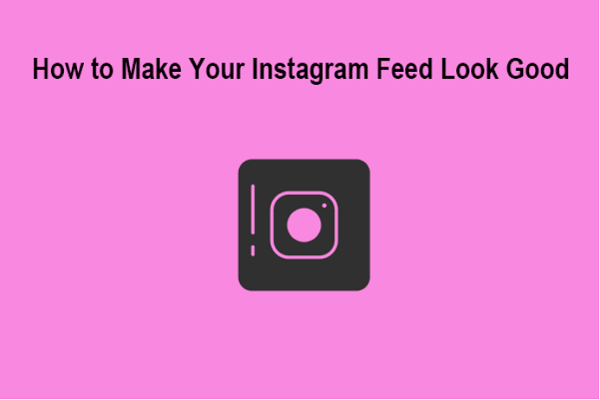
Wondering how to make your Instagram feed look good? With the help of these five tricks on this page, you can quickly improve your Instagram feed. Ready?
What Are the Benefits of an Amazing Google Slides Presentation?
Whether you are a student, teacher, or business professional, there should be good reasons to include graphic elements in your presentations.
Modifying themes, inserting shapes, and creating animations in Google Slides is time-consuming. You’ll spend a lot of time editing here and there in your presentation. But how do you make up for that time?
Before we look at how to make a Google Slides presentation look good, let’s see what are the benefits of adding design elements.
- Understand your concepts better. Google Slides presentations include a main topic as well as sub-topics. Your audience will understand what you’re saying more easily if you organize and make your slides more appealing.
- Data visualization. The main focus of most presentations will be 2-3 data-filled slides. This helps convince your audience and sell your ideas.
- Improved conversions. While the word “conversion” may be related to sales, it’s not just for that purpose. For salespeople, effective presentation design can lead to more product and service sales; For students, it is possible to convince their teachers that they deserve an A+; And professors can keep their students focused throughout their lectures.
Google Slides has a number of features that you can use to improve the look of your presentations. Here are a few tips and tricks you can use to improve your design and engage your audience.
Use Google Slides Templates
Templates are useful when you don’t want to do the same thing over and over in a design presentation. You can enter your content and fine-tune the template for your presentation so you don’t have to start from scratch.
There are many default templates available in Google Slides. You have the option to change the colors in the Theme builder and customize each slide individually.
Also read: Top 6 Sites to Get Free Google Slides Themes/Templates 2023
Add Transitions
It’s important to know how to make Google Slides look good. Likewise, transitions too. The key is to strike the right balance between adding too little and too much. It is best to use no more than one transition per slide and apply the same effect to all slides.
It’s a good idea to avoid using “Cube” and “Gallery” transitions. They’re a little too much. Also, you can try to use object animations. They can grab the attention of your audience if you are presenting an important chart.
Select the Right Colors
The Color Theory can be applied to any aspect of our lives. The same is true for your Google Slides presentations. You should choose your colors wisely according to the theme you decide on.
Remember to adjust the font colors as well. Presentations with dark backgrounds should use lighter, brighter fonts. Also, lighter backgrounds need to be balanced with darker, bolder text.
Colors play an important role in branding. If you want to highlight your branded items and give them more value, it might be a good idea to use branded colors in your Google Slides presentations.
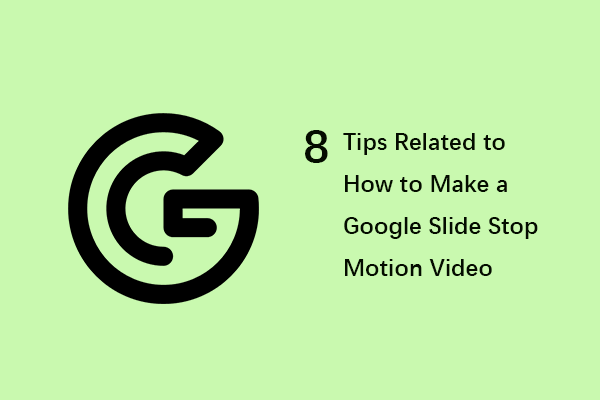
What are some useful tips for how to make a Google Slide stop motion video? Do you know which keyboard shortcuts can help you save time? Find out now!
MiniTool MovieMaker is a free video editing software that allows you to create amazing videos.
MiniTool MovieMaker Click to Download 100% Clean & Safe
Your audience is demanding, and they want to hear from someone who can express themselves with ease and catch the eye. So, you should learn how to make Google Slides look good.
About The Author
Position: Columnist
- Data, AI, & Machine Learning
- Managing Technology
- Social Responsibility
- Workplace, Teams, & Culture
- AI & Machine Learning
- Diversity & Inclusion
- Big ideas Research Projects
- Artificial Intelligence and Business Strategy
- Responsible AI
- Future of the Workforce
- Future of Leadership
- All Research Projects
- AI in Action
- Most Popular
- The Truth Behind the Nursing Crisis
- Work/23: The Big Shift
- Coaching for the Future-Forward Leader
- Measuring Culture

The spring 2024 issue’s special report looks at how to take advantage of market opportunities in the digital space, and provides advice on building culture and friendships at work; maximizing the benefits of LLMs, corporate venture capital initiatives, and innovation contests; and scaling automation and digital health platform.
- Past Issues
- Upcoming Events
- Video Archive
- Me, Myself, and AI
- Three Big Points

How to Create Slides That Suit Your Superiors: 11 Tips
When you’re pitching ideas or budgets to execs in your organization, you need to deliver slides that fit those particular people just right. This checklist identifies the key considerations.

- Workplace, Teams, & Culture
- Leadership Skills

Carolyn Geason-Beissel/MIT SMR | Getty Images
I recently interviewed 20 of my customers, all in senior roles at Fortune 100 companies, and asked them their biggest pain point in presenting to higher-ups and even colleagues. What I heard consistently was that it can feel like Goldilocks bouncing from one option to the next, testing to figure out what’s “just right.” Does the audience want deep reports? Sparse slides? Something in between? Like … what?
Teams often come to presentation meetings with vast amounts of backup content just in case an exec wants to take a deep dive on any given point. There’s often a struggle to anticipate every direction attendees might want to go. It’s frustrating, and it’s not efficient.
Get Updates on Transformative Leadership
Evidence-based resources that can help you lead your team more effectively, delivered to your inbox monthly.
Please enter a valid email address
Thank you for signing up
Privacy Policy
There are many ways to build slides. I’m not just talking about crafting them well versus poorly. I’m talking about all of the important decisions regarding how to organize them, how much text to use, when to lean into a chart, the best ways to use bullets and color, and whether to include an appendix with additional information. Before you make your next proposal or request of the executive team, use this list of 11 tips for your next set of slides as a guide.
Four Things You Must Have in Every Exec’s Slides
Before we drill down into the harder aspects, the ones where your executives’ tastes may vary widely, let’s quickly cover four aspects that you can consider the building blocks — the basics you should never proceed without.
Start with an executive summary. Begin the slide deck with a tight executive summary that follows a three-act structure. First, start with stating the current realities. Second, clearly state the problem or opportunity your idea addresses and its potential impact. Third, explain how your recommendation solves the problem or exploits the opportunity and the next steps you’re proposing.
Have a logical organization. The arc of the deck — the package from beginning to end — should make sense. If your audience reads only the headline of every slide, the order should be coherent and make most of the case for you. The content below each slide’s headline must support the statement made in the title. Remove everything that doesn’t support your point; as writers will tell you, you sometimes need to “kill your darlings” when you’re editing.
Begin the slide deck with a tight executive summary that follows a three-act structure.
Make it skimmable. Help your audience to quickly grasp the point without getting bogged down in details. Create a clear visual hierarchy. Guide the reader’s eye through the content: Use bold headings, bullet points, and numbered lists to break down information into digestible pieces. Highlight key takeaways or conclusions in a different color or font size to draw attention to these critical points.
Focus on concise insights. Succinct statements with clear insights are everyone’s jam. Every slide should serve a purpose and contribute directly to the decision-making process. Distill complex information. Don’t use 100 words when 20 words will nail it. If you’re having difficulty trimming, consider using company-approved AI tools to help you take out the fluff.
Five Preferences to Confirm With the Person You Want to Reach
Now we’ll delve into what your particular audience does and does not want. If you haven’t yet, start by asking the person you’re presenting to what they generally prefer. They probably know themselves well but have not been asked to articulate how they like to receive information.
Ask how dense is too dense. Some executives prefer detailed slides with comprehensive data. Others favor a more high-level approach. You’re weighing how to balance informative content with readability, ensuring that slides are not overloaded yet are sufficiently detailed to support decision-making.
Confirm the delivery format and timing. Some execs like information presented to them. Others prefer a pre-read of the material followed by a discussion. I always recommend our tool Slidedocs (I’ve written a free e-book on them), which are visual documents using both words and images. The templates help presenters organize their thoughts into a document for a pre-read or a read-along. They are designed to be skimmable and able to travel through your organization without the help of a presenter.
I’m a huge fan of pre-reads and prefer to use my time in meetings to ask questions and build alignment. If your audience didn’t review your material in advance, ask at the top of the meeting whether they would like you to present it or would prefer to read through it and then discuss it.
Find out how much data visualization they prefer. Charts, graphs, photos, and illustrations often communicate complex data more clearly than words alone. When execs can see what you’re saying, they often can better understand the impact of your idea. Does the exec want to understand exact numbers? Bar charts allow them to move their eyes across a series of specifics. Does the exec want to know the shape of a trend over time? Line charts can show the pattern. (See “Classic Charts Communicate Data Quickly.”) Some prefer charts with annotations that draw attention to what you think is the most important point. Others want to make their own conclusions from the data.
One of my clients, the CEO of a massive commercial real estate company, doesn’t want anything visualized. He prefers numbers, only in a table, and only in two colors — black and red. You might think this is archaic. But the fact that he’s clear to his teams about what he wants takes all the mystery out of how to communicate with him.
When the stakes are high, have a conceptual thinker help with diagrams and concepts. If you don’t have one on your team, and when it’s high stakes, find an internal designer to help you or hire one. You can’t afford to have the baby (your idea) thrown out with the bathwater (terrible slides).
Identify which details need spelling out. How well do the people you’re presenting to know the landscape and function of the company and products you’re talking about? For example, if your engineering team threw a slide into a deck about an issue that requires executive approval, do the execs all speak geek? Or do you need to explain the technology so that they will really understand the ask? Either eliminate internal jargon and acronyms or unpack those bits, especially if your proposal deeply involves expertise outside of the executives’ domain.
Ask whether appendices will be useful. When you’re organizing a presentation, you often troll data, read through complicated reports, and even hire external experts to figure out what’s best for the company. Do your execs want access to that supporting data? You can add a document to the end of the presentation as an appendix to show all of the data and source material. This allows the main content of the slides to remain focused and accessible while still providing comprehensive background information for those who want more.
Two Tips to Improve Your Presentation Skills
Getting materials in place is the biggest step. They will be your best tools for selling your ideas. But there are two extra areas to pay attention to as a presenter: how you handle questions and how you use every experience to improve.
Anticipate questions, and practice your answers. Before you have your meeting, gather a small team to challenge every point you make. Invite colleagues you trust to role-play as “a rapidly inquisitive exec” or “the doubting naysayer exec” so you are prepared to present your idea well. They’re gonna grill you, and practicing will help you remain unruffled when it happens.
Related Articles
Ask for feedback after the presentation. Establish a feedback loop with those you presented to. Ask what worked well and how you can improve. If attendees don’t have the time, find people who have had their ideas funded and talk to them about what they did that worked. Advice and some perspective will help you nail your performance even better next time.
Empathetically understanding your audience members and how they process information, whether it’s executives or peers, sets up your ideas for success. Clarity creates efficiency. When a presentation fits just right, you’ve given your great thinking the best chance of moving through your organization and having maximum impact.
About the Author
Nancy Duarte is CEO of Duarte Inc. , a communication company in the Silicon Valley. She’s the author of six books, including DataStory: Explain Data and Inspire Action Through Story (Ideapress Publishing, 2019).
More Like This
Add a comment cancel reply.
You must sign in to post a comment. First time here? Sign up for a free account : Comment on articles and get access to many more articles.
Android Police
How to draw on google slides.
Add that personal touch to make unique presentations
Google Slides has features like a digital pen, speaker notes, and autoplay that help you create impressive presentations. It works flawlessly on any device, including Android phones, iPhones, laptops, Macs, PCs, and affordable Chromebooks . One feature that's often overlooked is the drawing option. If you like to sketch, add a unique twist to your slides. It's a fun way to create a visually pleasing presentation. This tutorial shows you how to draw on Google Slides and spruce up your presentations.
When should you use the drawing feature in Google Slides?
There are no rules for drawing on Google Slides if it's an informal presentation for friends or classmates. But exercise restraint if you're making a slideshow for the office or school. You can add annotations, diagrams, and handwritten notes for workplace presentations.
How to add a hanging indent in your Google Slides presentation
How to draw on google slides using the scribble tool.
Google Slides has several shapes and lines in the Insert menu, but that might not be enough for the image you want to create. You can use the Scribble tool to make freehand drawings.
The Scribble feature is unavailable on the mobile app. You can only access basic shapes and lines. Your only option is to create the presentation on the desktop version of Google Slides.
Here's how to draw on Google Slides with the Scribble option:
- Open Google Slides and log in to your account.
- Choose a new slide.
- Click Insert from the toolbar.
- Choose Line .
- You'll see a plus sign as your cursor.
- Hold the left mouse button until you finish drawing.
The drawing is selected after you let go of the left mouse button. The toolbar displays customization options, allowing you to modify the line color and weight. You can also change the start and end points.
Go to Format > Format options to change the size and position. You can also add drop shadows and reflections to your drawings. Google Slides doesn't offer a fill option. However, you can fill shapes with color.
How to insert Google Drawings in Slides
Google Drawings is a simple drawing tool for creating illustrations. It gives you a checkered drawing board to doodle on. You can import the final image to other apps like Google Slides after you finish drawing.
Here's how to make a drawing:
- Other options include Table , Chart , Diagram , and Word Art .
- After you complete your drawing, click File and choose Share .
- Copy the link.
Here's how to use the drawing in Google Slides:
- Open Google Slides .
- Click Insert .
- Paste the link and click Insert Image .
Google Drawing is only available on the web. It doesn't have Android or iOS app versions.
How to draw on Google Slides with the Annotate extension
You can use the Annotate Chrome extension to draw on Google Slides. Here's how to add and pin the extension:
- Open Google Chrome and visit the Chrome Web Store .
- Type Annotate in the search bar.
- Click Add extension .
- After installation is complete, pin the extension so that it's easily accessible.
- Click the puzzle piece button at the top of the screen.
Here's how to use the Annotate extension:
- Go to your Google Slides tab and click the Annotate extension in the upper-right corner.
- Press and hold the left mouse button until you finish drawing.
- The drawing remains on the original slide even if you go to a new one.
- Click Save .
What's the difference between Google Slides templates and themes?
Your annotations appear in your Annotate account under Web Annotations . Don't be alarmed when your drawing disappears if you navigate away from your slide and return. Click Load previous annotations to view your drawings. Although you can't see it in the left sidebar, the drawing appears when you present your slideshow.
Add some quirkiness to make your Google Slides presentations stand out
The tips in the guide should help you include your drawings in your Google Slides presentations and make them unique. Add more flair to your slideshows by adding sound effects, voiceovers, and other audio clips . If you're short on time yet want to impress your audience, try these beautiful Google Slides templates to create professional-looking slideshows in a jiffy.

COMMENTS
Go to Insert >> Image >> Search the web >> Type in the name of the image you want. Or, go to Explore section and Google directly from the Slides tab. 3. Reflect your images if it suits the context. This will be a really cool effect, especially for slides with a single important image.
Today, I want to show you guys how I make my presentations on Google Slides! I didn't use a template for this video but there are template resources that I'v...
Use the Insert > Audio option to add audio to your Google Slides. If you want to add some soft music to your presentation, you can. In fact, this method of how to make Google Slides look good has nothing to do with visuals! First, click on Insert. From the menu that drops down, click on the Audio option.
You can make Google Slides vertical by following simple steps: Open a new or existing presentation. Click the " File " button to open a drop-down menu. Click the " Page setup " option. Select the " Custom " option and set your desired size (width and height) Hit " Apply " to save the changes.
Trying to make cool Google Slides? You've come to the right place. In this video, you'll learn how to make Google Slides presentations look good with ten tip...
In this article, we share 20 pro Google Slides tips to help you get the most out of using Google Slides. Learn how to make Google Slides look good with these cool Google Slides tricks. Guide to Making Great Presentations (Free eBook Download) Before going further, be sure to grab our free eBook: The Complete Guide to Making Great Presentations.
Colors are a substantial part of branding. If you have a Google Slides presentation and you want to showcase your branded goods, you might want to use the brand colors, as to highlight your product and add more value to it. 3.3. Pay attention to fonts. The fonts you pick will set the tone of your presentation.
Now, simply go back to your Google Slides presentation and change the fonts according to your selection. 5. Choose the Right Color Combination. Just the way fonts are an important part of your Google Slides presentation design, choosing a good color combination can make your presentation look visually appealing, consistent, and professional.
Follow the steps below to add animations and transitions: Go to "Slide," and select "Transition.". Select your preferred effect in the side panel under "Slide Transition.". Adjust its speed as necessary. Click "Apply to all slides.". Under "Object Animations," select the effect you want to apply to your text or object.
Follow the below steps to learn how to make Google Slides look good: Select "Insert" > "Diagram" to add a diagram to your slides. The diagrams side panel will show up on the right side of your screen. The six types of diagrams available are Grid, Hierarchy, Timeline, Process, Relationship, and Cycle diagrams.
Best Practices for Cool Google Slides. Follow these best practices to make even cooler and professional slideshows. 1. Consistency is Key. Maintain a consistent use of colors, fonts, and design elements throughout your presentation. This consistency creates a professional and cohesive look. 2. Less is More. Adopt a minimalistic approach.
Here are the top 20 design tips to consider when using Google Slides: Tip 1: Use templates. Tip 2: Use plenty of images. Tip 3: Experiment with typography. Tip 4: Add diagrams and infographics. Tip 5: Get creative with your images. Tip 6: Be careful with color.
Assembling a professional slideshow can be intimidating if you don't feel creative or artistic. But that doesn't mean you can't make an appealing and successful presentation. Google Slides provides features to help you design an attractive slideshow. 1. Apply Image Effects You may have an image or two that could use a little pizzazz.
Learning how to work with Google Slides and master the popular presentation software won't be in vain.Many people know what Google Slides is and are taking good advantage of it.. Both students and teachers can use it for free, and on top of that, many business professionals can also implement it in their work free of charge, thus making it a valuable presentation software.
We built Keep to help you easily capture and organize ideas. Today, you can use a new drag-and-drop integration between Keep and Slides to transform these ideas into action. Simply select notes from Keep (or sort with #labels) and drag them into Slides. When you add a note from Keep into your presentation, Slides will automatically add a title ...
3. Create a New Presentation. Creating a new Google slides presentation is easy. Simply open your Google Drive, click on New tab in the upper left corner and click the "Google Slides" option from the toolbar menu. If you are using a pre-designed template,. There are many sites that offer Google slides templates.
1. Use an Aesthetically Pleasing Template. This aesthetic presentation template is from Envato Elements. The first step in how to make your Google Slides look aesthetic is to use a premium Template. We'll use the premium Aesthetic Creative Google Slides from Envato Elements for this tutorial. This premium template comes with over 30 slides.
Example of page layout improvements to make your slides more effective and attractive. 2. Establish clear information hierarchy. In general, don't use more than 2-3 font sizes on a page. A reader should be able to quickly glance at your slide and understand which text elements are titles, headings, and detail.
Design not your strong point? Use the Explore button in Google Slides to create beautiful presentations with zero effort! Also, a bonus tip on inserting imag...
Google Slides is a popular presentation software that allows you to create visually appealing slide decks easily. With the right techniques, you can design professional presentations that captivate your audience. This step-by-step guide will teach you how to make your Google Slides look fantastic.
Open the template presentation you created in the steps above. On the menu bar, click File > Make a copy > Entire presentation. On the panel that opens, type in a name for the new presentation you ...
Follow the steps below to use vertical orientation in Google Slides. Navigate to Google Slides on the web and open a presentation you want to edit. Click File at the top and select Page setup ...
Use the New > Google Slides > Blank Presentation option to start your new presentation. A new presentation opens: Google Slides will launch a new presentation that's ready for you to design. Of course, if you're using a template as recommended, you'll need to upload it to your Google Drive account.
It's important to know how to make Google Slides look good. Likewise, transitions too. The key is to strike the right balance between adding too little and too much. It is best to use no more than one transition per slide and apply the same effect to all slides. It's a good idea to avoid using "Cube" and "Gallery" transitions.
Start with an executive summary. Begin the slide deck with a tight executive summary that follows a three-act structure. First, start with stating the current realities. Second, clearly state the problem or opportunity your idea addresses and its potential impact.
In this video you will learn about how to export google slide to Microsoft PowerPoint software and how to make a best presentation step by step.Interactive G...
Open Google Slides and log in to your account. Choose a new slide. Click Insert from the toolbar. Choose Line . Select Scribble from the drop-down menu. You'll see a plus sign as your cursor. Hold ...
Seven-year-old Beautiful.ai is showing just how good AI-enhanced slideshows can be—and making traditional tools like PowerPoint and Google Slides seem like clunky old relics.